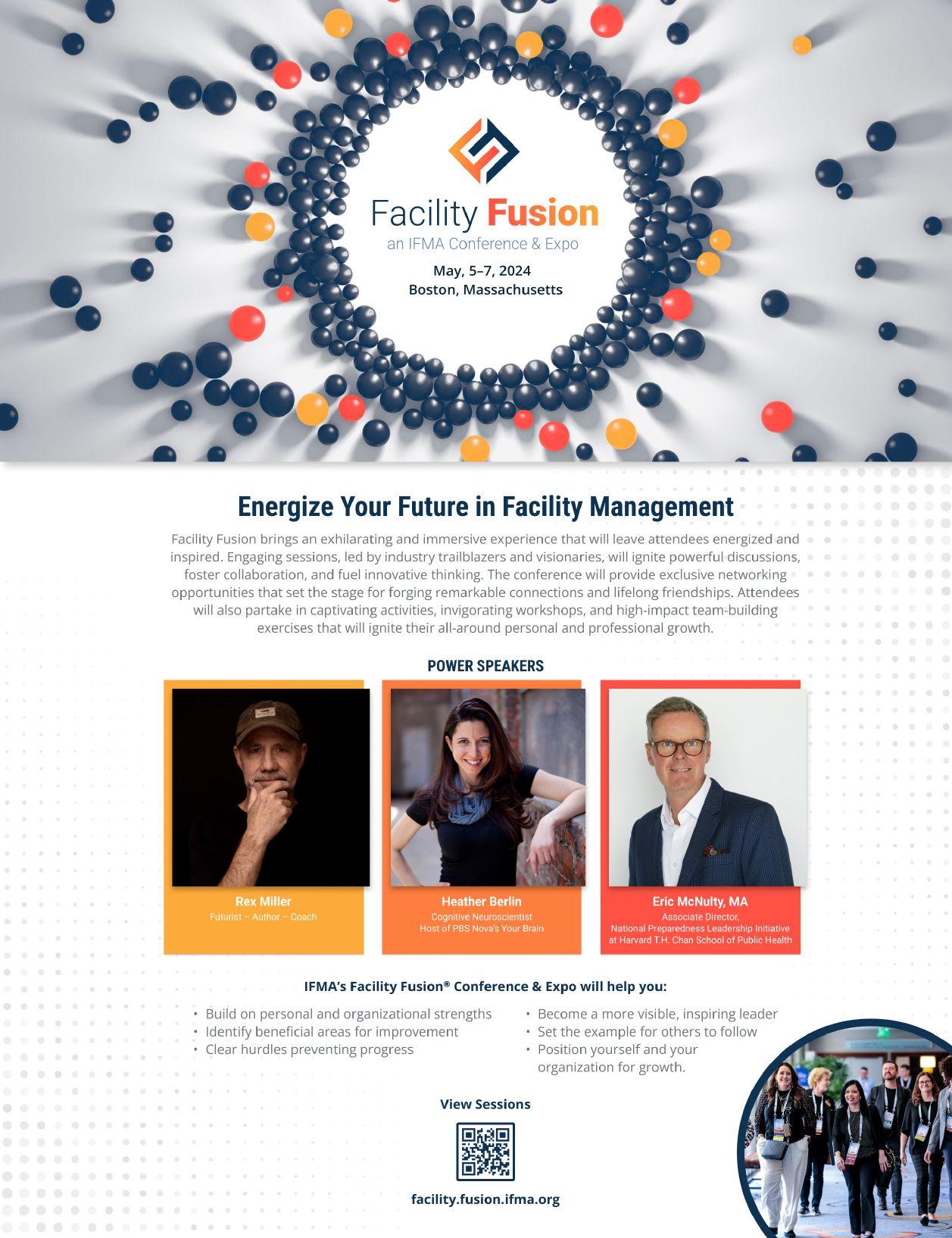

















































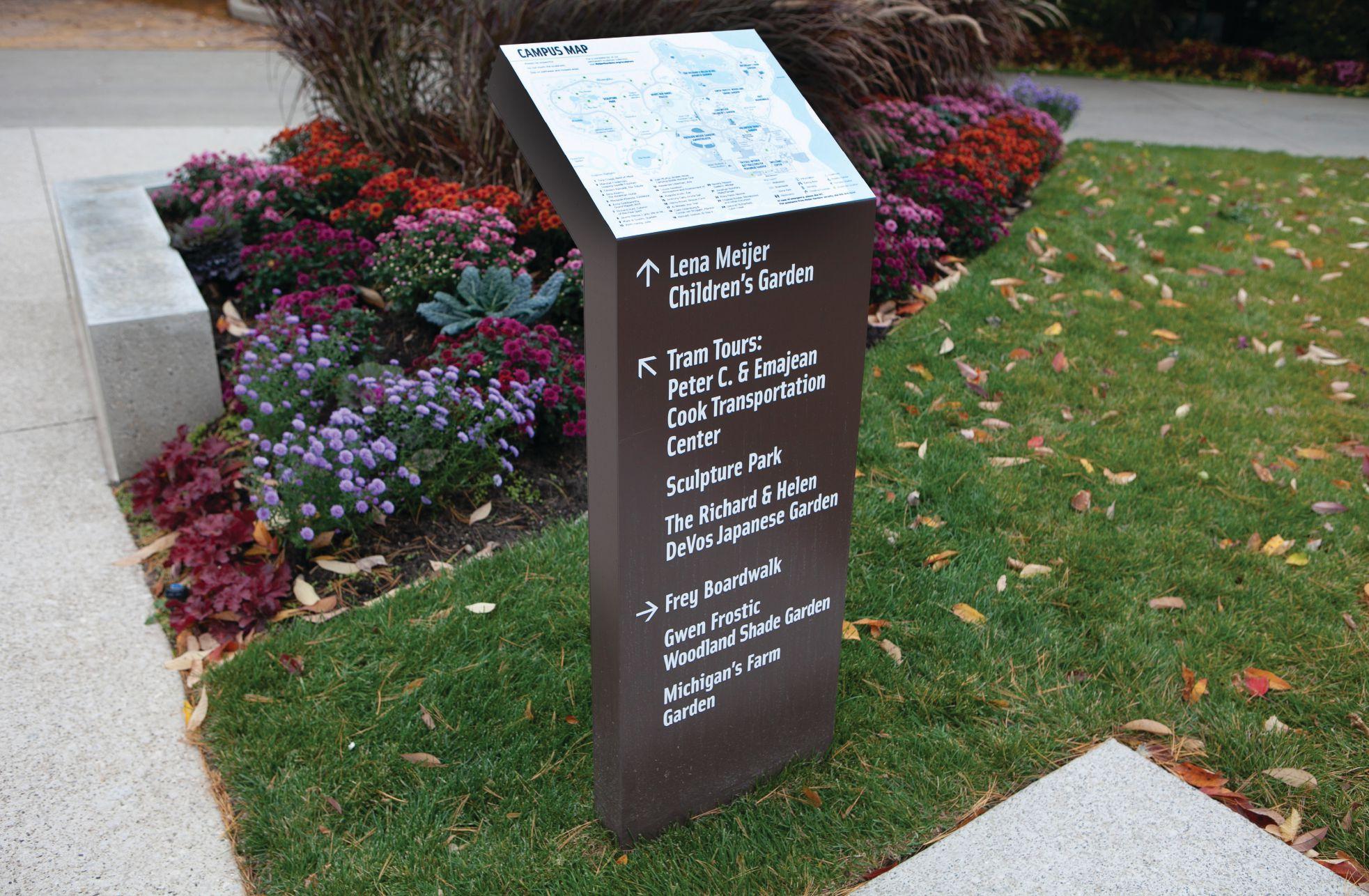
Transforming your space begins at our place.












We are excited to start 2024 with programs and membership benefits to help you succeed.
Propel your career forward, find better solutions faster, keep pace with the changing industry and bring additional value to your organization with IFMA’s programs and services.
IFMA’s educational offerings help facility professionals from all backgrounds and experience levels develop the skills they need for career advancement.
With your IFMA membership, you will make the connections and build the relationships needed for a successful career in facility management.



Make a lasting impact on IFMA and the facilities management profession by becoming a thought leader or by taking advantage of a leadership opportunity.
IFMA Events are designed for FM professionals of every career level and will help you develop personal and professional skills..

Discover how IFMA can help you succeed in facility management.

014 Better by Design
Revolutionizing experiences with AI
Mary Carnes
020 Enhancing FM Efficiency
The power of standard communication protocols
Harry Willemse
024 Employee Retention
Why ongoing education is the key
Clare Epstein
029 An Ounce of Prevention
Reducing the threat of workplace violence
Kim Fox
034 My Facility
Holden Forests & Gardens
Nico Viola
040 Unforeseen Issues
Solving problems before they start
Bill Conley
046 The Shrinking Workplace
Successful decommissioning in the post-pandemic landscape
Nick Kloos
052 What is Your Image?
What your facility says about your organization
Mary Guiteau
058 Restroom Maintenance Strategies
Combining hygiene & efficiency
Jon Dommisse
068 Expect the Unexpected A proactive approach to minimizing risks
Adam Rebesa
072 Case Study
Transforming campus infrastructure
Brian Leach & Zach Price
078 Rethinking Workplace Noise
Taking inspiration from nature
Evan Benway

IFMA is the world’s largest, most widely recognized association for facility management professionals, supporting more than 24,000 members in 136 countries. Founded in 1980, IFMA’s vision is to lead the future of the built environment to make the world a better place. A key contributor to the development of international FM standards, IFMA provides career resources, continuing education and three industry-respected credentials; maintains the largest repository of FM-related content on the web; and hosts year-round global events. Among the values that guide us, we believe in the benefit of global diversity, inclusion and social equity; and we recognize that sustainability, resilience and responsible environmental stewardship are paramount. For more information, visit ifma.org.
FMJ (ISSN 1059-3667) is published six times a year (January/February, March/April, May/June, July/August, September/October, November/ December) by the International Facility Management Association, 800 Gessner Road, Suite 725, Houston, Texas 77024-4257 USA.
Periodicals postage paid at Houston, Texas and at additional mailing offices. One electronic copy of each issue is supplied to IFMA members. Printed copies are available to members at an additional US$48 per year. Nonmembers can purchase a subscription for US$84 per year.
To receive a subscription, mail a check to FMJ, attn: Subscriptions; 800 Gessner Road, Ste. 725; Houston, Texas 77024-4257 USA or visit www.ifma.org/fmj/subscribe. For advertising rates call +1-281-974-5674 or email diana.maldonado@ifma. org. FMJ is printed in the United States. FMJ reserves the right to edit any articles received or solicited for publication. This right includes the discretion to select titles, artwork and layout. Opinions expressed in articles are those of the authors, not necessarily those of FMJ staff. ©2024 International Facility Management Association.
POSTMASTER
Send address changes to: FMJ, 800 Gessner Road, Suite 725, Houston, Texas 77024-4257 USA.
PLEASE RECYCLE
With the goal of minimizing our carbon footprint, FMJ is printed by an FSC®-certified company.
ON THE GO ? FMJ can be viewed on your mobile device, so you can get your FM content fix anywhere, anytime.
The online version of FMJ features extra resources like videos, podcasts, white papers and more to enhance your reading experience. Click on the FMJ Extra icons that appear in the digital magazine to link to additional sources of information to learn more about topics covered by articles in this issue.
015 Report
The State of Organizations 2023

025 Report Building the Agile Future
031 Resource
Workplace Violence Prevention Compendium of Resources


041 Article The Acronymic World of FM
049 Report
Cross-generational Attitudes That Will Transform the Built Environment
059 Resource 2023 Healthy Handwashing Survey



Check out the online issue of FMJ for a special section that follows the end of the print magazine and includes additional articles not available in the print edition. Read the extra articles listed below for contributions from councils and communities, and other supplementary content.
Ask the Experts
Young Professional Profiles
Book Excerpt
Leadership in Managing Facilities: A One-Year Journey
Richard Payant
Bridging the Gap
OT and IT’s impact on FM
Mike Murdy
A Critical Challenge
Developing the next-gen FM workforce
James Mylett
Evolving With Excellence
Comprehensive updates in IFMA’s benchmarks & targeted training
Nickalos Rocha & Jake Smithwick
Facing Hail Damage
The need for resilient roofing
Chuck Miccolis & Chris Sanders
Vendor Profiles

Our reliance on observable facts, be it statistics, physical results or lessons learned through experience, provides the data we need to make informed decisions on virtually everything.
Sometimes that means the answer is to keep doing what we’ve been doing because it works, and we’ve always done it that way.
Sometimes it means trying something new.
IFMA’s FMJ magazine is no different, and what better time to start anew than in the new year?
Beginning with this issue, we’re addressing the entire scope of the facility management industry, rather than focusing on one key topic. During the pandemic, the FM profession evolved faster than ever before. FMs reacted to data that changed almost daily to safely navigate through quarantine and social distancing mandates, through an eventual return-to-work and now a hybrid work model.
FMs and their organizations were forced to find new strategies; then quickly restrategize in response to changing guidelines and expectations. In that time, the way we viewed space, occupancy, indoor air quality and sensor technology transformed FM from the way we do things now to trying something new – an evolution that would have otherwise taken a decade or more occurred over just four years.
Resilience, agility and strategy were combined into a systematic, yet fluid plan – one that could pivot deftly without leaving a wake of chaos in its path. This plan required organizations and FMs to ensure occupants' confidence in the safety and reliability of their facilities. FMs transformed their facilities into a true destination of choice.
As FMs found new ways to craft strategy, so did IFMA’s FMJ. Whereas one issue would be dedicated solely to technology or operations and maintenance, or sustainability, now every issue is dedicated to technology … and O&M … and sustainability … and design … and everything in-between, because you need timely information on all of these areas.
For 34 years, you have trusted IFMA’s FMJ to be your source for thought leadership and practical takeaways from industry pioneers, experts and innovators who freely share their knowledge and insight. Like the industry and the association it passionately chronicles, FMJ has evolved in many ways since Volume 1, Issue 1 and will continue to do so.
From an editorial standpoint, I’m excited. This will be a great challenge, which means we have a great opportunity. Opening content submissions to the breadth of FM interests and concerns will allow us to give you what you need with each new edition.
We are always accepting proposals for content. Our pitch proess, editorial submission guidelines, calendar and deadlines are available by scanning the QR code below. I encourage anyone who touches our industry to consider sharing your knowledge with our readers. Knowledge sharing cultivates the innovation that makes FM professionals the most valuable and undeniable resource for forwardthinking organizations.
Cheers!


View FMJ’s Editorial Calendar. Scan the QR Code to read more about our pitch process, guidelines and deadlines.
STAFF
EDITOR IN CHIEF
Bobby Vasquez bobby.vasquez@ifma.org
SENIOR EDITOR & WRITER
Chablis Lindquist chablis.lindquist@ifma.org
SENIOR ACCOUNT MANAGER
Diana Maldonado, CEM diana.maldonado@ifma.org
DIRECTOR, CREATIVE SERVICES/ DESIGNER
Ellen Peeples Cregan
2023-24
IFMA GLOBAL BOARD OF DIRECTORS
CHAIR
Dean Stanberry, CFM, SFP Contractor to the U.S. General Services Administration Denver, Colorado, USA
FIRST VICE CHAIR
Lynn Baez, CFM, SFP, FMP, CBCP, IFMA Fellow Enterprise Vice President of Facilities and Workplace, McKesson Irving, Texas, USA
SECOND VICE CHAIR
Christa Dodoo, CFM, CIWFM, FMP, CMQ-OE Head, Global Facilities Management Services United Nations World Food Programme Rome, Italy
PAST CHAIR
Laurie A. Gilmer, P.E., CFM, FMP, SFP, LEED AP President/COO, Facility Engineering Associates, P.C. Santa Rosa, California, USA
Francisco Antonio de Souza Abrantes, MBA Senior Consultant, FASA Consulting São Paulo, Brazil
Cheryl Carron Global Head, Facilities Management & Experience Services Corporate Solutions, JLL Milwaukee, Wisconsin, USA
Trudy Blight
CFM, FMP, SFP, BID, PIDIM, PMP, IFMA Fellow Project Manager, AES Services, University of Manitoba Winnipeg, MB, Canada
Jason E. Callis, CFM Facilities Management, Project Executive The Veridus Group Indianapolis, Indiana, USA
Lorena Espada EMEA Head of Facility Management, Chubb European Group Madrid, Spain
Aykean Matthews, MBA, CFM, FMP Facilities Director, The International School of Port of Spain Port of Spain, Trinidad & Tobago
Arnald NG, CFM, SLCR, MRICS APAC Delivery & Performance Director, GSK Singapore
Lena Thompson FMP, SFP, IFMA Fellow Director, Building Operations & OFM, American Psychological Association Washington, D.C., USA
Luis Viña Director, Alliance Director LatAm, CBRE Mexico City, Mexico
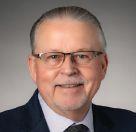
Welcome to 2024!
DEAN STANBERRY
CFM, SFP Chair, Board of Directors
If you were in the audience for my opening speech at IFMA’s World Workplace last September in Denver, Colorado, USA, you heard me announce the release of a new white paper, “Evolution is Never Finished,” which summarizes findings from IFMA’s Emerging Topics Working Group. The paper’s title is intentional in that the facility management profession experiences evolution daily, and IFMA’s role is to continuously monitor and periodically report on how those changes affect the industry. As we begin a new calendar year, I highly recommend reviewing the paper’s insights into the key external drivers shaping the future of the facility management.
What I said in September still holds true today: CRE and FM have never before experienced evolutionary change at this velocity. IFMA is currently tracking six high-impact trends affecting the FM profession, including circular economy, climate change, ESG reporting, PropTech, artificial intelligence, and workplace wellness and well-being. In some cases, a given topic may be relatively new to FM. We will need to build awareness of the topic, identify what knowledge an FM will need to know and develop the education to help FMs apply this new knowledge in practice. This will be delivered in many forms, including our Connected FM podcast and blog, webinars, FMJ articles, research papers and microlearning courses.
The FM profession covers literally all industries and every possible built environment setting. Individual roles and responsibilities vary. And as the association strives to deliver maximum benefits to members around the world, ensuring that content applies and appeals to every FM is becoming increasingly complex. While not every IFMA resource may be of direct interest or use to each member, we are fulfilling our mission to advance our collective knowledge, value and growth for FM professionals to perform at the highest level.
While you will see more information regarding the emerging trends mentioned above, the association will not forget about FM’s core responsibility, which is operations and maintenance (O&M). In fact, it is even more imperative that we master the basic blocking and tackling activities related to O&M in order to harness the advancements offered by these emerging trends.
Regarding technology, some may require additional learning at a more fundamental level. What are enterprise systems, and how do they work? How do databases manage data, and why is data consistency crucial? Why is interoperability between systems important, and how is it achieved? What are the characteristics of data, and what is data analytics? Nearly all the emerging trends discussed so far depend on complete, accurate and timely data to be of any use. Data is the new currency; data analytics is how you unlock its value.
It is important to note that no technology (software) can turn bad data into useful information and business insight.
The association will do its best to help our members identify gaps in data quality, skills and knowledge. Some may face a bubble of effort and resources required to overcome these gaps, but it is necessary to join the next generation of FM — which is already here!
In closing, my (virtual) door is always open; so, please feel free to contact me with your questions, concerns and comments at Dean.Stanberry@ifma.org.


Here’s to an exciting and productive 2024! Opening speech

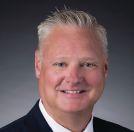
DON GILPIN President & CEO
IFMA
Our professional community relies on good and best practices to ensure facilities and teams are performing at the highest, most efficient level. Through IFMA events, publications, podcasts, webinars, courses and content sharing, members and nonmembers alike can research current best practices. But did you know that research itself is a best practice?
IFMA collaborates on a global scale with subject matter experts, industries and organizations that believe in improving the built environment through benchmarking and research. Our reports are one of your most important member benefits, helping you evaluate, justify and implement modern best practices in support of a resilient built environment.
With more than 40 years of turning information into insights for the FM industry, IFMA does not use the descriptor “industry-leading” lightly. We are recognized as the most trusted source of academic and applied research on topics that carry the greatest urgency and importance to FM professionals worldwide. IFMA Research and Benchmarking currently has more than 20 projects underway, with three new reports set to be released at the first of this year, including:
High demand for talent has prompted many employers to consider job applicants’ abilities over relying solely on higher education degree requirements. This has opened the door to a broader range of candidates and presented individuals with new career opportunities. However, it has also opened the floodgate to a number of non-degree certificate programs, microcredentials and skill badges, leaving employers and professionals wondering whether career-focused credentials have value and credibility; and if so, which ones.
IFMA’s previous report on the ROI of our credentials verified their quality, integrity and value to credential holders, finding an average five-year return on investment of 16:1, with an average salary increase of US$5,400 within the first year. Our new report shows employers the benefits that IFMA credentialed and certified employees bring to the organization.
FMs in every sector know that setting goals for emissions reductions and climate resilience, and for improving experiences and outcomes for organizations and occupants, starts with organizational buy-in. But the stakes are even higher for FMs in health care, which makes justifying increased resources for updated practices and upgraded systems all the more important.
Benchmarking can help FM professionals make a valid business case for optimizing operations for compliance and competitiveness. By measuring organizational processes and performance metrics against accepted standards, best-in-class practices and/or competitors, FMs can show the C-suite where and why they need increased resources to do their jobs. The information contained in this report can be used to make the case specifically to medical center executives.
IFMA’s salary and compensation reports provide practical value at both the individual and company level — current and prospective practitioners can use the information to negotiate a raise, promotion or employment; and those in hiring positions can use the information to remain competitive amid workforce shortages and a tight labor market.
This first-of-its-kind report can also help employers discover and develop recruitment strategies for an underutilized community. Thousands of U.S. Armed Forces personnel transition from military to civilian life each year. Many bring with them an educational background, a unique skillset and valuable hands-on experience. With military veterans comprising only 16 percent of facility managers in the United States, introducing active-duty and military veterans to the profession and increasing awareness of their worth among organizations is a high priority.













































The European Committee for Standardization (CEN) unites the national standardization bodies of 34 European countries, providing a platform for the development of standards and other technical documents in relation to a variety of products, materials, services and processes in a wide range of fields and sectors. As an official liaison organization of CEN, IFMA EMEA is instrumental in helping develop and define standards at the European level.
“Participation allows IFMA EMEA to have a voice in support of our European stakeholders and keep our members informed about relevant standards development,” said IFMA EMEA Managing Director Lara Paemen.
In this capacity, IFMA EMEA is “expected to provide highquality, added-value expertise in a defined technical field relevant for CEN and/or CENELEC Technical bodies and to provide effective contributions through direct participation in their meetings” (Section 2.1, CEN guidelines). Emiel Roos is IFMA EMEA’s new liaison representative to CEN/ TC 348, but also coordinates information from the other CEN technical committees on which IFMA EMEA serves, including:
■ TC348 Facility Management
■ TC371 Energy Performance of Buildings
■ TC442 Building Information Modeling (BIM)

Cement is a significant source of industrial CO2 emissions, representing 26 percent of global industrial sector CO2 emissions in 2019. Announced in December 2023 at COP28 in Dubai, the Cement and Concrete Breakthrough initiative, co-led by Canada and the United Arab Emirates (UAE), will enable countries to share best practices on a range of policies and other measures to decarbonize the cement and concrete sector. Together with endorsing countries including Germany, Japan, Ireland and the United Kingdom, international partners, and the global cement and concrete industry, this groundbreaking initiative will lead a shift that will make clean cement the preferred choice in global markets. Created in 2022 at COP26, the Breakthrough Agenda provides a framework for initiatives that enable countries to accelerate decarbonization actions. The Breakthrough Agenda now covers sectors responsible for more than 60 percent of global emissions.


According to the latest report by Kings Research, the global solar energy solutions market was valued at US$30.06 billion in 2022, and is projected to reach US$92.18 billion by 2030, at a compound annual growth rate (CAGR) of 15.12 percent from 2023 to 2030. The market is experiencing rapid expansion due to increasing demand for sustainable energy sources; and the declining costs of solar energy systems have significantly enhanced the competitiveness of solar power in the electricity generation sector. Europe leads the global solar energy solutions market in terms of growth, attributed to its continuous efforts to develop and implement solar energy solutions as part of a commitment to reducing greenhouse gas emissions and transitioning toward a more sustainable energy system. Government policies and incentives have played a pivotal role in promoting solar energy adoption across Europe. Measures such as feed-in tariffs, tax credits and support systems for renewable energy have incentivized the installation of solar panels on rooftops and the establishment of large-scale solar farms.

Submit your news to be considered for inclusion in the Industry News section of the next issue of FMJ. Send us an email at communications@ifma.org.

The National Association of Corporate Directors’ (NACD) Governance Outlook Report: Projections on Emerging Board Matters is an annual forecast of trends and issues that U.S. directors and senior executives are likely to face in the coming year. The trends and insights uncovered in the 2024 report reflect how the boardroom is responding to rapid developments in the business landscape. Said NACD President and CEO Peter Gleason, “Unsurprisingly, directors are most concerned with talent, technology and the economy, and how these trends amplify each other. Directors need to anticipate their cascading effect rather than view them in isolation.” Key trends include the threat of a recession, increased regulatory requirements, cybersecurity issues and more competition for talent. AI appeared for the first time on the list of top trends that will impact businesses over the next 12 months. More directors expect the U.S. economy to head toward a soft landing in 2024 than they did a year ago, with only 29 percent of this year's respondents anticipating a recession in the coming year, down from 65 percent last year.


Working at heights? Ahead of National Ladder Safety Month in March, the American Ladder Institute (ALI) strongly recommends revisiting safety protocols and training on proper ladder usage. For the 13th year in a row, fall protection (general requirements) was OSHA’s No. 1 safety violation for fiscal year 2023, with a 23 percent increase in these violations compared to 2022. Three violations in the Top 10 are related to falls and ladders, with fall protection (training requirements) listed eighth and ladders ranked third. Tens of thousands of people are injured annually in accidents caused by improper ladder usage. Dedicated to promoting safe ladder use through ladder safety resources, safety training and the development of ANSI ladder safety standards, ALI believes ladder accidents are preventable with thorough safety planning and training; and urges companies with employees working at heights to become a leading voice on ladder safety at work.

“It is a balanced plan that tackles emissions, bridges the gap on adaptation, reimagines global finance, and delivers on loss and damage. It is built on common ground. It is strengthened by inclusivity, and it is reinforced by collaboration. It is an enhanced, balanced, but make no mistake, historic package to accelerate climate action.”
— COP28 President Dr. Sultan Al Jaber
In December 2023, 198 governments (Parties) convened in Dubai, United Arab Emirates (UAE), at the 28th meeting of the Conference of the Parties (COP28) to the United Nations Framework Convention on Climate Change. COP28 concluded with Parties agreeing to a landmark text named The UAE Consensus that calls on Parties to transition away from fossil fuels to reach net zero.
Throughout the two-week process, COP28 President Dr. Sultan Al Jaber and the presidency team expressed determination to deliver “a plan that is led by the science” and define a new way for this and future COPs, based on the inclusion of diverse peoples and elevating the needs of the Global South.
In addition to the unprecedented reference to transitioning away from all fossil fuels to enable the world to reach net zero by 2050, the final negotiated text encourages Parties to submit economy-wide Nationally Determined Contributions (countries' self-defined national climate pledges under the Paris Agreement); includes a new specific target to triple renewables and double energy efficiency by 2030; and builds momentum behind a new architecture for climate finance.


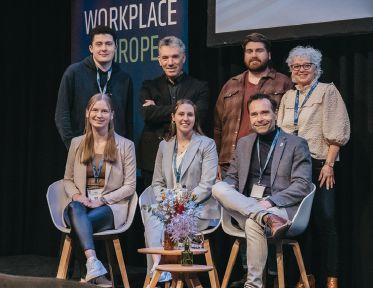








Facility Management is no longer limited to the traditional roles of maintenance and operations. It has evolved into a strategic function that permeates every facet of the industry, driving significant impacts in areas such as sustainability, digitalization, occupant experience and more.
The conference aims to explore the transformative power of FM and its profound influence on diverse aspects of the industry. Join us as we uncover the latest trends, best practices, and innovations that propel FM's impact across sectors.



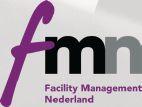

OPENING KEYNOTE










Geertrui Mieke de Ketelaere


Adjunct Professor at Vlerick Business School













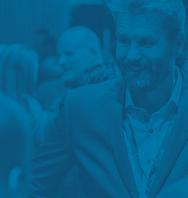


















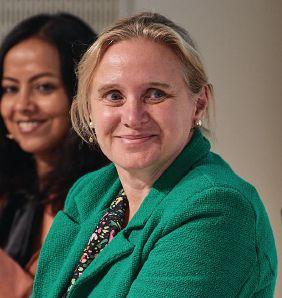
























Mark T. Hofmann









CLOSING KEYNOTE




























Crime and Intellegence Analyst
Harness the expertise of industry leaders and acquire the essential skills that will propel you to success in 2024.
Dive into the exciting lineup of speakers and sessions, and gear up for a fantastic journey at World Workplace Europe.

























OPENING RECEPTION

Connect with the global facility management community and build your professional network. World Workplace Europe offers various networking opportunities designed to facilitate meaningful interactions throughout the conference.
CHARITY DINNER




Serving as a perfect prelude to an evening filled with networking opportunities, this reception promises a delightful start to your time in Rotterdam.
Enjoy luxury bites, a delectable dinner, entertainment, live music and networking with colleagues. Proceeds will benefit the IFMA Foundation and grant a European FM student scholarship.
FM NETWORKING PARTY
Unwind with fellow participants in an informal setting, accompanied by refreshing drinks, delectable bites, and lively music—a perfect blend to conclude World Workplace Europe.
Depot Boijmans Van Beuningen Rotterdam
The world’s first publicly accessible art storage facility.
Guided bike tour on architecture and development of Rotterdam Roam this amazing city by bike.




BY MARY CARNES








FMJ EXTRA | Report
The State of Organizations 2023

Ever since the COVID-19 pandemic, the ways in which people live and work have drastically changed. Especially in the ever-evolving landscape of the modern workplace, the role of facility managers has shifted and grown increasingly complex. Beyond mere physical space management, FMs are entrusted with creating environments that align with an organization’s identity, enhance employee well-being, and drive productivity and connection.
Thanks to the many innovative workplace management technology solutions and the integration of artificial intelligence (AI), FMs have gained powerful tools to decipher the ins and outs of workplace design.
To truly understand this dynamic, it is important to take a deeper look at crucial aspects of workplace technology and how that, along with AI, is reshaping the future of workplace design to meet current and future societal needs.



To cater to the well-being of employees, organizations must create an exceptional hybrid experience. Through proper space management and design, AI and other workplace technologies can alter the office for the better. One way AI is changing the game is through noise mitigation. Open office plans have been the trend for years, promoting collaboration and flexibility. However, they have also given rise to a significant challenge: noise and distraction. Workplace management technology, along with AI-powered solutions, now aids FMs in addressing this concern.
According to a study conducted by the Harvard Business Review, excessive noise in open offices is a leading cause of decreased employee productivity and satisfaction. AI-powered noise mitigation strategies have been shown to improve employee concentration and overall well-being.
AI algorithms can analyze noise patterns, identifying peak times and areas where noise pollution is most problematic. Utilizing real-time data, FMs can strategically position acoustic barriers or white-noise generators to mitigate disturbances. Additionally, AI can predict noise trends. This data, coupled with space planning software tools, helps FMs proactively allocate quiet spaces. This leads to a harmonious work environment that caters to diverse work styles.
Creating these work environments has historically been a large lift. However, the days of manual space management are long gone. The integration of workplace management technology and AI has streamlined the operational aspect of facilities. Advanced space-management software collects real-time data about space usage, occupancy rates and resource consumption. Workplace intelligence dashboards can provide this data in an easily consumable manner to optimize space allocation, making the workplace more efficient. FMs can use this data to identify underutilized areas, reallocate resources based on actual needs and design multifunctional spaces that dynamically adapt to different requirements throughout the day based on repeating trends.
In a recent survey conducted by Deloitte, 82 percent of FMs reported that integrating AI and workplace technology increases job satisfaction and enhances performance significantly. Using this technology to better utilize office space can result in up to 20 percent cost savings.
While technology and AI drive transformative change in workplace design, they are most effective when harmoniously integrated with human creativity. FMs continue to be the visionary architects who translate data-driven insights into tangible, functional designs. Space and scenario planning tools allow for the experimentation of new concepts virtually, visualizing designs before taking action and receiving real-time feedback. This synergy amplifies innovation and ensures that the final designs are not only efficient but also aesthetically pleasing and functional for the employee, aligning with the holistic vision of a modern hybrid workplace.
A report from McKinsey & Co. highlights that organizations embracing the synergy of AI and human creativity in workplace design are more likely to see increased employee engagement and satisfaction, which can lead to 40 percent higher productivity.
The true potential of workplace management technology and AI still largely relies on human creativity. FMs play a pivotal role interpreting data into actionable changes within the office environment. While AI provides data and insights, FMs inject creativity, vision and the human touch to transform these insights into meaningful alterations that increase productivity and do not hold employees back.
Insights from a working paper from MIT indicate that working in partnership with AI increases employee productivity in the office by 50 percent or more. Software company Ui Path says that 83 percent of people using AI think it helps reduce burnout and increase job satisfaction, and 80 percent think it helps them do their job better. What is even better for retention? Seventy-nine percent of respondents view their employers more positively when they use AI. Additionally, AI can detect patterns in employee behavior that might not be apparent to the naked eye. For instance, AI might
While AI provides data and insights, FMs inject creativity, vision and the human touch to transform these insights into meaningful alterations that increase productivity and do not hold employees back.



uncover that employees tend to congregate in a specific corner of the office during certain times of the day. FMs can then capitalize on this insight to create collaborative spaces in that area, optimizing both space usage and employee engagement. Allowing employees the freedom to work in the spaces best suited to their needs can bode well for the office, especially when offering comfortable areas for collaboration and ample desk space for heads-down work.
According to a report by PwC, a third of the workforce (34 percent) said the motivation to use technology stems from curiosity and the promise of better efficiency and teamwork. Additionally, 37 percent of the workforce is more likely to adopt new tech if it helps aid in career advancement.
However, for organizations with multiple locations, managing a portfolio of facilities is a complex endeavor. AI-driven predictive analytics play a vital role in optimizing portfolio management. These algorithms consider factors like location, usage patterns and economic trends to recommend strategic decisions. FMs can make informed choices about consolidating, expanding or reimagining their real estate assets. This not only enhances cost efficiency but also ensures that each facility’s design aligns with its unique purpose and the broader organizational strategy.
AI has immense potential in easing the financial burden of real estate executives. Approximately half (49 percent) of real estate business owners confirm that AI helps cut their operating costs; and 63 percent of property companies said AI has resulted in revenue increases.
Approximately half (49 percent) of real estate business owners confirm that AI helps cut their operating costs; and 63 percent of property companies said AI has resulted in revenue increases.
Employee well-being is at the forefront of workplace design, and technology plays an integral role in this shift. By using workplace management tools, FMs can analyze employee behavior and office trends to foster emotional health, productivity and costeffective space planning. The emotionally intelligent workplace becomes a space where employees thrive, driving engagement and lasting productivity.
According to a 2023 global survey by Gensler, employees in high-performing workplaces are almost three times more likely to say working in the office positively impacts work/life balance and well-being than those in low-performing workplaces.
One of the cornerstones of AI-powered workplace technology is the integration of smart building systems. These systems encompass various aspects of FM, including lighting, HVAC (heating, ventilation and air conditioning), security and energy management. Smart sensors and AI algorithms work in tandem to optimize the use of resources and enhance the overall employee experience.





For example, AI can monitor occupancy patterns and adjust lighting and temperature settings accordingly, not only reducing energy consumption but also creating a more comfortable and productive environment for employees. In the era of remote and hybrid work, FMs can remotely access and control these systems, ensuring that office conditions are ideal when employees are on site.
Organizations that have fully integrated smart building systems with AI-driven analytics can see energy savings of up to 30 percent, minimizing costs and reducing operational expenses.
Moreover, these smart building systems can contribute to health and safety in the workplace, a critical aspect in the post-pandemic era. AI can monitor air quality, detect potential safety hazards and facilitate contactless access control. All these features add up to a workplace that prioritizes employee well-being and security.
According to the U.S. National Safety Council, to help enhance occupational safety and smart building systems, more companies are turning to AI and other safety-related technologies, enhancing employee confidence and satisfaction.
In this new era of work, the FM’s role has transformed into that of a strategic workplace designer. The integration of workplace management technology and AI empowers FMs to understand the future of workplace design and make data-driven decisions that cater to the evolving needs of the workforce and their real estate needs. Emotionally healthy and intelligent designs, efficient operational space management, the synergy of AI and human creativity, portfolio optimization and the integration of smart building systems are just a few aspects that highlight the transformative impact of technology in FM.
In this exceedingly dynamic landscape, FMs emerge as the visionary architects who fuse technology and creativity to sculpt workspaces that inspire, engage and enhance productivity. AI and workplace management technology are shaping the workplaces of tomorrow. FMs can use data insights that used to be impossible to come by to create environments that foster well-being and align with organizational goals. The fusion of technology and human ingenuity holds the promise of a future in which workspaces are not just functional but inspirational hubs of innovation and collaboration.
As FMs embrace these tools, they step into the role of architects of experience, crafting spaces that transcend the mundane and embody the essence of their organizations. The journey toward the workplace of tomorrow is guided by AI-powered insights, yet it is the human touch that paints the final strokes on this canvas of innovation. FMJ
In this exceedingly dynamic landscape, FMs emerge as the visionary architects who fuse technology and creativity to sculpt workspaces that inspire, engage and enhance productivity.

Mary Carnes has 20 years of experience in corporate real estate planning and management, helping workplace leaders navigate the complexities of today’s hybrid environment. Carnes recognizes the importance of striking a balance between optimizing portfolio efficiency, driving employee engagement and promoting company culture.
www2.deloitte.com/us/en/pages/consulting/articles/ state-of-ai-2022.html
www2.deloitte.com/uk/en/insights/topics/strategy/future-of-office-spacepost-covid.html
linkedin.com/pulse/embracing-ai-without-losing-your-humanity-navigatingbrassfield forbes.com/sites/tracybrower/2023/07/09/ai-will-change-your-worksignificantly-heres-how-to-respond pwc.com/us/en/services/consulting/library/consumer-intelligence-series/ tech-at-work.html
jatapp.co/blog/ai-in-real-estate/ gensler.com/blog/5-trends-driving-the-new-post-pandemic-workplace utilitiesone.com/benefits-and-challenges-of-implementing-smart-buildingenergy-management-solutions shrm.org/resourcesandtools/hr-topics/technology/pages/companies-turn-aiimprove-workplace-safety.aspx





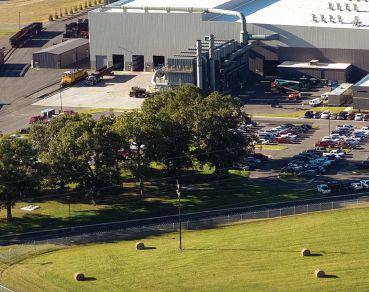





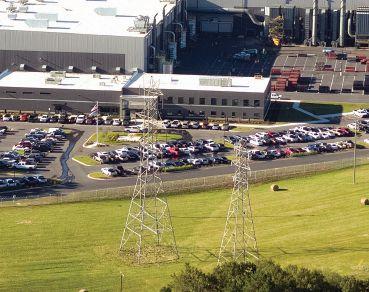






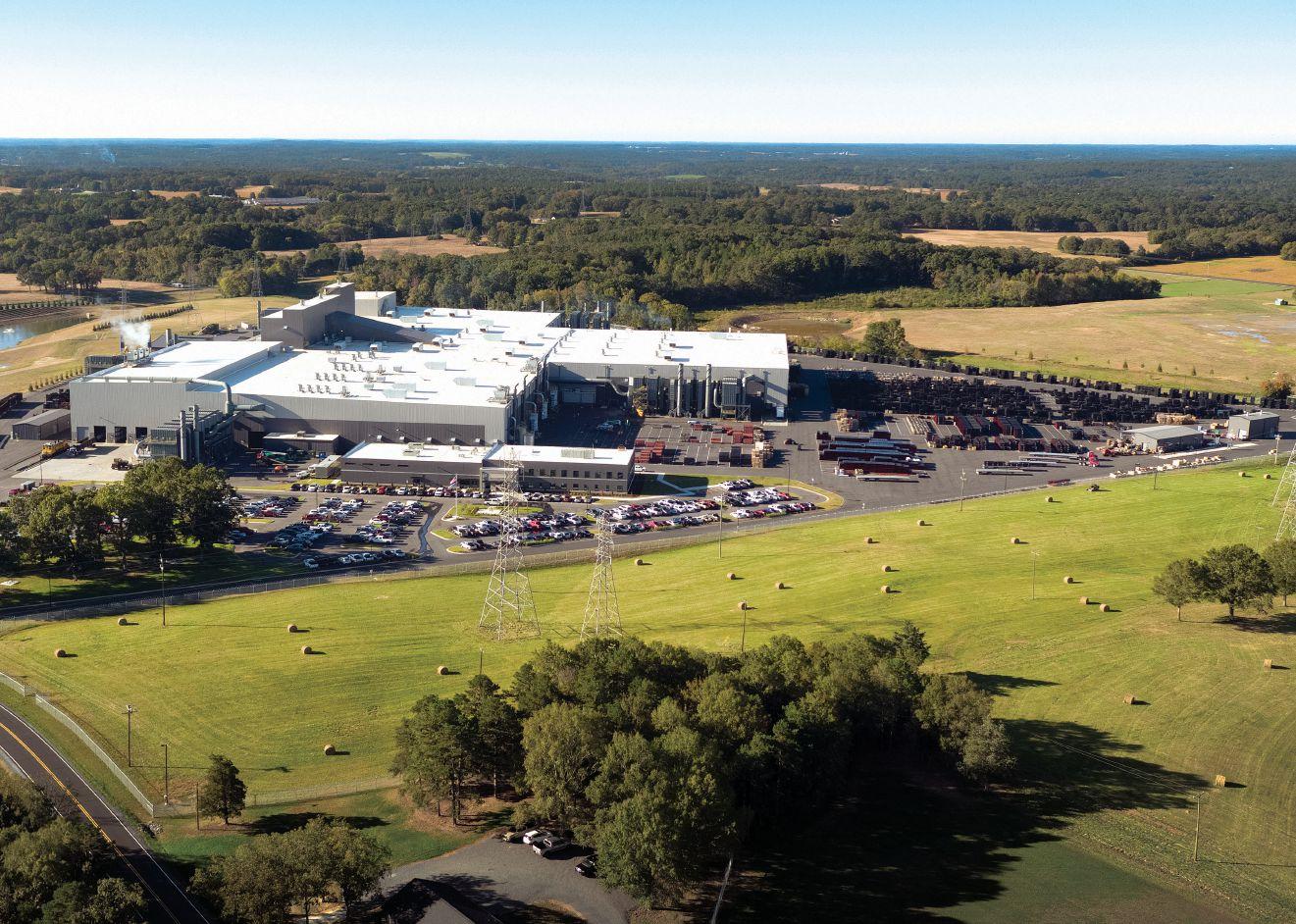
The industry is evolving, and we’re leading the way. Our new foundry in Oakboro, North Carolina, is a $460 million investment set on about 700 acres — making it one of the largest and most modern foundries in the world. The opening of this state-of-the-art foundry ushers in a new era of growth for Charlotte Pipe and Foundry and demonstrates our care and commitment to our associates, the plumbing industry, and American manufacturing.

Learn more at CharlottePipe.com/Oakboro-Foundry






INTEROPERABILITY





IMPROVED DATA MANAGEMENT





INTRANSPARENCY MAINTENANCE EXECUTION






The power of standard communication protocols


BY HARRY WILLEMSE






EFFICIENTINCIDENT RESOLUTION

COST EFFICIENCY SECURITY



The digital age continues transforming industries, streamlining processes and creating efficient mechanisms to conduct business operations. The relationship between maintenance service providers and their customers is no exception. Implementation of a market standard protocol for communication between the production systems of maintenance service providers and the facility management systems of their customers can significantly contribute to this trend.
Market standard communication protocols are designed to standardize the exchange of information between different systems, fostering coherence, transparency and efficiency. There is not much FM industry experience with a protocol that covers the synchronization of basic data like building information and asset information, or incident calls and the progress of maintenance execution. Based on the experience of other similar domains it undoubtedly offers an array of benefits that enhance service delivery, foster customer satisfaction, and reduce operational inefficiencies and costs.
One of the core benefits of a communication protocol is enhanced data management. A streamlined channel for data exchange eliminates information silos and improves the accuracy and consistency of data across different systems. Synchronizing basic data such as building and asset information ensures all parties have access to the same updated and accurate information. This consistency reduces the risk of misinterpretation or errors arising from conflicting data, promoting operational efficiency.
Many companies work with multiple service providers and suppliers. For end users in these companies, it is not workable to have a separate portal for each service provider or supplier. The protocol enables customers to register incident calls to be handled by a service provider in their own FM system. This capability significantly enhances incident resolution. Customers can directly communicate their concerns, ensuring the appropriate service provider has accurate information about the issue. Direct communication eliminates the need for intermediary interpretation or communication, reducing the risk of misconception and enhancing the speed and efficiency of incident resolution.
By providing real-time information on the progress of reactive and planned preventive maintenance, the market standard protocol fosters transparency. Transparent communication enables customers to stay informed about the status of their service requests, enhancing their trust and satisfaction. It also allows service providers to demonstrate their reliability and efficiency, which can lead to improved customer retention and competitive advantage.
A market standard communication protocol can significantly reduce operational costs. By fostering efficient communication and reducing the likelihood of errors and misunderstandings, it eliminates wasteful practices and redundancies. Furthermore, by enabling direct incident reporting and efficient incident resolution, it reduces the need for multiple costly and time-consuming site visits to diagnose the problem. Some other examples how the use of a protocol-based interface can lead to significant cost savings are:
Reduced development and maintenance costs:
By standardizing interactions through a protocol-based interface, the service provider reduces the complexity and scope of what needs to be developed and maintained since they can implement one interface for all their customers. On the other hand, customers can implement one interface for all their service providers.
A protocol allows for a higher degree of automation. Many tasks that might require human intervention in a web portal scenario can be automated, reducing labor costs. For example, customers can interact with the system to retrieve information, place orders and perform other tasks without needing assistance from the supplier’s staff.
With a protocol-based interface, less time and fewer resources are needed to train users because they are interacting with
their own systems that have been integrated with the supplier’s system, rather than having to learn how to use a new web portal.
Customer satisfaction:
Use of protocol-based interfaces improves customer communication, leading to better service delivery reliability and user experiences. Improved reliability and user experience can lead to increased customer satisfaction, potentially reducing costs associated with customer turnover, complaints and the need for support.
Analytics and optimization:
The use of a protocol-based interface can provide more accurate and granular data about how customers are using the service. This can help in optimizing the service, reducing waste and thereby reducing costs.
Creating a protocol-based interface between the system of a service provider and their customers can have numerous advantages in terms of cybersecurity over providing customers with direct access to the service provider’s system via a web portal. Here are some of the key benefits:
Data encapsulation:
The protocol-based interface provides an abstraction layer that prevents the client from directly accessing the underlying system data. This encapsulation principle can enhance data security by limiting the system’s exposure to potentially malicious clients.
Auditability:
It is easier to monitor and log access when using a protocol-based interface. Every access request, including successful and
failed attempts, can be tracked and audited, which is critical for identifying potential security breaches or misuse.
Limitation of attack surface:
Protocol-based interfaces can minimize the attack surface by limiting the number of ways an attacker can gain unauthorized access to the system. A properly designed interface will expose only the necessary services, while keeping other parts of the system inaccessible.
Isolation:
If the service provider’s system is compromised, the attackers would not directly have access to the customer’s systems. Similarly, if a customer’s system is compromised, the damage can be contained, preventing it from spreading to the service provider’s system.

Market standard protocols enable interoperability, that is, they allow different systems to work together seamlessly. This is beneficial for customers using multiple service providers or service providers servicing multiple customers. Each party does not have to adapt to a unique system or communication style; instead, they can leverage the market standard protocol to facilitate smooth, standardized interactions between systems.
Maintenance service providers often have hundreds or thousands of customers who, in turn, often have multiple maintenance service providers. If only a small percentage of these customers need to have an interface between their FM system and the production system of their maintenance service provider, this will still mean that an enormous number of interfaces need to be built. Based on a protocol, suppliers of FM software and service provider production systems can develop a standard implementation of this protocol in their software. That out-of-the-box implementation can be installed by their users to connect between service providers and any number of customers.
The benefits of a market standard protocol for communication between the production systems of maintenance service providers and the FM systems of their customers are profound. The improved data management, efficient incident resolution, transparency in maintenance execu-
tion, cost-efficiency and interoperability
offered by such a protocol make it a beneficial tool for modern FM. It streamlines interactions, enhances customer satisfaction and boosts operational efficiency. FMJ

Harry Willemse, an IT professional for more than 35 years with an academic degree in administrative informatics, began his career in architectural software development. He worked as a business consultant for various organizations, with an increasing focus on the automation of business processes within facility management organizations. Since 2017, Willemse has been working as a product manager for the service provider solution of Planon, a leading supplier of facility and field services management software, as well as IWMS and CAFM solutions.
The most widespread comparable protocol is EDIFACT:
United Nations/Electronic Data Interchange for Administration, Commerce and Transport (UN/EDIFACT) is an international standard for electronic data interchange (EDI) developed for the United Nations and approved and published by the UN Economic Commission for Europe.
In 1987, following the convergence of the UN and US/ANSI syntax proposals, the UN/ EDIFACT Syntax Rules were approved as the ISO standard ISO 9735 by the International Organization for Standardization.
The EDIFACT standard provides:
■ a set of syntax rules to structure data
■ an interactive exchange protocol (I-EDI)
■ standard messages which allow multicountry and multi-industry exchange
The work of maintenance and further development of this standard is done through the United Nations Centre for Trade Facilitation and Electronic Business (UN/CEFACT) under the UN Economic Commission for Europe, in the Finance Domain working group UN CEFACT TBG5.
BY CLARE EPSTEIN

In an era of economic turbulence, employee turnover has become a top concern for business leaders across every industry. But this pain is disproportionately felt in the facility management space: employee turnover here can reach more than 200 percent, which is significantly higher than the national average.
Given the industry’s heavy reliance on safety regulations, this turnover creates a skills gap across leadership, engineering and maintenance tech roles that has the potential to be incredibly dangerous for employees’ overall health and safety.
Organizations must take a multifaceted approach to closing this gap. With recent data from LinkedIn revealing that providing learning opportunities is the No. 1 way organizations are improving retention, FM employers must offer their workers the resources they need for long-term growth. As such, employee education and training is the most effective way to keep facilities both safely operating and fully staffed.
One-size-fits-all onboarding approaches are outdated. Quick tours of the facility and rushed training processes are not enough to set new employees up for success in their new roles, especially when there is no support or follow-ups to gauge how that worker is progressing.
According to the Society for Human Resource Management (SHRM), onboarding can last up to a full year and should involve multiple stakeholders in the organization, including employees’ managers and peers. This may seem like a drawn-out process, but it takes time for new workers to meaningfully retain information. Giving employees ample time to ramp up is not just critical for operational safety; it also provides them with the opportunity to upskill within the facility and beyond.
Revamping and revitalizing the onboarding process should begin with developing a strategic plan that outlines what the company needs a new hire to achieve. This plan should include clear objectives and goals on a set timeline to lay the groundwork for employee growth and the employee career trajectory. Does this individual need to renew certifications to operate role-specific machinery? What resources, structure and support do they need to get certified on a reasonable timeline? These considerations should be baked into the onboarding plan so employees have everything they need to safely hit the ground running..



Proper onboarding should also incorporate learning and development systems to ensure the experience is engaging, interactive and resonant. Such platforms will grant employees access to ongoing training so they can continue their learning trajectory while taking care of their daily on-site responsibilities.
Consider kick-starter learning paths as an example. Assigning courses for the diverse array of FM jobs can be difficult to navigate. The right learning management platform will be able to match online training courses to jobs like facility technician, facility manager, electrician, plumber and others to ensure each employee has access to foundational, role-specific knowledge. Kick-starter learning paths are a simple way to assess and assign courses that align with federal OSHA and EPA compliance requirements while facilitating employees’ training objectives.
Onboarding and learning paths should also consider employee goals and career skills. Employees need to have job-related skills today, but it is also important that the employee feels invested in building skills that lead to a future career path with more opportunities. To improve employee retention and engagement, career paths can help individuals understand that today’s level 1 facilities maintenance technician can lead to level 2, progressing to HVAC technician career opportunities.













Managers have a critical role to play in getting the onboarding process right from the get-go. Direct managers should constantly look for more training opportunities for their employees and vouching for their growth. Managers should understand the applicable learning paths and career skills required for their employees. Consider the following review cycle guide as an example of how managers can stay involved in new employees’ success from the moment the employee is hired:
PLAN Set goals and development objectives.
ACT Develop and build role-specific capabilities.
MONITOR Complete ongoing check-ins, coaching and improvement.
REVIEW Deliver performance review as it pertains to the original plan.
By setting reasonable goals for employee learning and professional development, providing feedback and supporting ongoing training, managers can demonstrate they have a personal stake in their employees’ growth.
Managers thus have an integral role to play in retention. As leaders within the organization, managers are responsible for creating and perpetuating a positive workplace culture. They can accomplish this by fostering solid relationships with their employees, asking thoughtful questions and taking concerns seriously. All of this serves to strengthen trust between manager and employee, and it contributes to overall employee well-being — an absolute necessity for high-performing teams, especially in potentially hazardous environments.
With so much responsibility on their shoulders, managers should not be excluded from organizations’ training initiatives. Ensuring employees have the necessary technical training to efficiently and safely fulfill their duties is only part of the picture — facilities should prioritize ramping up soft skills as well. Anybody can be an effective














manager with the proper training and self-reflection, but many leaders are promoted without adequate instruction. According to Gallup, the five traits of great managers include:
■ Motivation: Inspiring teams to get exceptional work done.
■ Workstyle: Setting goals and arranging resources for the team to excel.
■ Initiation: Influencing others to act, pushing through adversity and resistance.
■ Collaboration: Building committed teams with deep bonds.
■ Thought process: Taking an analytical approach to strategy and decision making.
Organizations that wish to attract and retain staff must begin by providing managers with the training they need to hone the skills and traits required of effective leaders.






















and excellence in which workers aresatisfied,engagedand productive enough to be continuously developing and improvingshouldbeleadership’s top priority.




















While training current managers, keep future leaders within the organization in mind as well. Many potential managers may be already working in nonmanagement roles, so providing soft skills and professional development training can offer the business a strong leadership pipeline to power ongoing success.
Creating a culture of learning and excellence in which workers are satisfied, engaged and productive enough to be continuously developing and improving should be leadership’s top priority. However, career growth is no longer a prescriptive or linear process. The imagery of climbing up the corporate ladder must be reimagined for the contemporary workforce. Instead, think of career advancement as a rock wall: the climber does not just go upward — they must traverse left, right and sometimes down a few holds to progress.
Even for those who are not interested in pursuing management roles, providing clear growth pathways wherein employees can upskill and reskill themselves promotes self-awareness, clarity and confidence in their abilities. Consider the following methods for socializing growth pathways outside of traditional training initiatives:
■ Establishing role profiles for staff that explicitly state what is required of an individual in their role, what they need to be successful and what makes them unique.
■ Hosting live learning events for various teams to support social learning.
■ Cross-functionally matching mentors and mentees so they can help each other grow.
Outside of mandatory training, leaders should also consider removing the term “required” from additional courses. This language can make employees feel like they are simply checking a box rather than investing in their professional advancement.

Instead, communicate that the resources are there and encourage employees to use them, but do not force it. Allowing them to drive their own career growth will nurture a sense of individual ownership and pride in their accomplishments.
Just like onboarding, there is no blanket approach to training that will adequately meet the needs of every organization or individual employee. That said, there are several components to effective training that FM leaders should ensure their learning and development programs include, no matter the specifics.
One such component is the implementation of a comprehensive learning and training management platform. This technology is essential for closing skills gaps, promoting organizational consistency, and boosting morale and retention.
Online learning standardizes the presentation of the necessary role-specific skills and knowledge new hires must hone to fulfill their duties. For example, these programs instill confidence that an organization’s maintenance technicians, regardless of their level, have been introduced to the same foundational safety concepts they need to operate, thereby creating a solid basis for the organization to build upon.
Learning management systems also streamline the onboarding process, which is crucial for employee retention in a competitive job market. Systems that offer career pathing guides, for instance, can establish 12-month training goals for new hires, no matter their experience or specific role.
All of this contributes to improving employee morale, retention and professional growth. When employees have access to a library of training resources, in addition to their onboarding and compliance requirements courses, they may seek out their own training opportunities to further individual development. With 94 percent of respondents telling LinkedIn that development opportunities would encourage them to stay at their company longer, it is obvious that providing a clear path for continuous upskilling and education has a competitive retentive advantage. Instead,
Implementing virtual learning is not enough to adequately train employees, no matter how robust the platform. This is where the 70/20/10 learning model comes into play. This approach posits that workers obtain most of the knowledge and skills necessary for their jobs by getting their hands dirty and performing work-related tasks. The rest comes from social interactions with colleagues and formal learning initiatives like classroom lectures or eLearning modules.
As such, it is important to marry virtual learning with on-the-job training (OJT). The most used training method, OJT takes place directly at the worksite and involves the trainee performing or observing someone else perform certain tasks. OJT provides learners with the opportunity to use real machinery, equipment, tools, processes and procedures so they can develop the competencies required to fulfill their responsibilities.
The right learning management software is designed to support a blend of OJT and virtual learning. By supplementing hands-on education with digital assets like 3D animations, organizations can ensure they are covering all their bases when it comes to best-inclass training.
Building a culture of continuous improvement will prove a massive contributor to employee retention. By giving employees the necessary resources to grow, develop and feel confident in their roles, organizations can ensure they are doing everything in their power to keep their staff safe and engaged.
But education must be supplemented by a sincere sense of belonging. When training and advancement opportunities are married with relationship-building efforts (even something as simple as regular coffee breaks with managers can go a long way), employees at every level will feel holistically supported and be less likely to churn. FMJ

Clare Epstein serves as general manager, commercial at Vector Solutions, bringing more than 20 years of leadership experience working with safety training and technology solutions. Epstein is responsible for driving strategy, execution and growth for Vector’s commercial market segment, which serves customers across manufacturing, oil and gas, property management, engineering and construction. She first came to Vector after the company’s acquisition of IndustrySafe, a leading provider of EHS software, where she was the chief operating officer. Her experience also includes leadership roles at Civis Analytics and theEMPLOYEEapp. Epstein holds a master’s degree in city planning from the Massachusetts Institute of Technology and a bachelor’s degree in urban studies from the University of Pennsylvania.
builtin.com/recruiting/employee-turnover-statistics diversifiedm.com/how-outsourced-facilities-maintenance-turnover-canimpact-your-business inc.com/scott-mautz/these-are-5-traits-of-great-leaders-according-to-50years-of-gallup-research.html learning.linkedin.com/resources/career-development/develop-employees






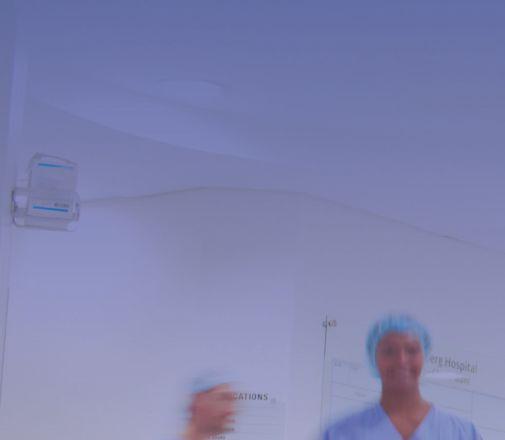


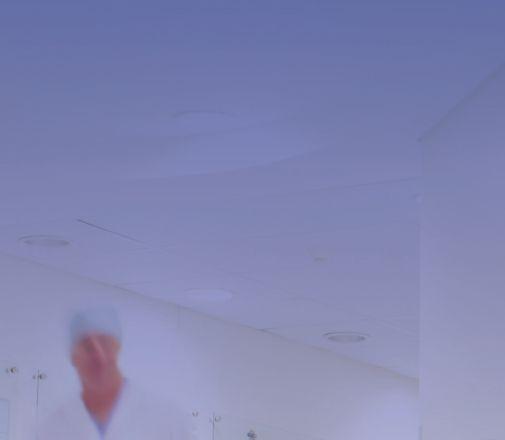

BY KIM FOX


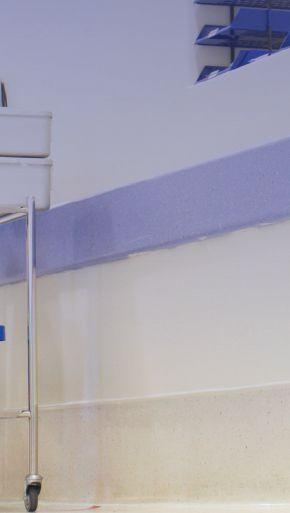
Protecting the safety and well-being of everyone within health care facilities is paramount.

These institutions expect to provide excellent patient care while maintaining a safe environment for staff and visitors. Unfortunately, there is a troubling trend of violence in health care workplaces. The Occupational Health & Safety Administration (OSHA) reports that 75 percent of the approximately 25,000 workplace assaults occur in the health care industry each year. The impact of such violence, whether emotional or physical, can extend beyond those directly involved, affecting patient care, job satisfaction, quality of care and even staff retention. As incidents of violence continue to rise, health care leaders must confront this critical occupational safety issue.
Most hospitals have developed robust response plans for incidents. However, there is a growing need for even more preventive measures and action. In response, accrediting organizations such as The Centers for Medicare & Medicaid Services (CMS) and OSHA have intensified their focus on the safety and security of health care facilities, streamlining standards to ensure that proactive measures are in place.
With the addition of the new workplace violence standard EC.02.01.01 EP17 by The Joint Commission, a leading U.S.-based regulatory body, health care providers are required to proactively assess their current workplace safety measures and identify opportunities for further improvement to minimize risks. At this point, hospitals and health care facilities should be adequately prepared to demonstrate their actions to address workplace violence to avoid potential infractions.
The Joint Commission regularly evaluates and updates its accreditation standards. However, with numerous modifications, deletions and additions over the years, hospitals and health care facilities often need help to keep pace. To encourage greater levels of compliance, The Joint Commission modernized its core standards and introduced new ones to provide greater clarity. The workplace violence prevention standards apply to all Joint Commission-accredited hospitals. The new standards emphasize proactive measures in addition to previous protocols, such as controlling access to and egress from security-sensitive areas.
Specifically, the newest safety standard requires the hospital to conduct a proactive risk assessment or annual worksite analysis. The guidelines are extensive, including analyzing the worksite, the hospital’s workplace violence incidents, and how the program’s policies and procedures, training,
education and environmental design reflect best practices and conform to applicable laws and regulations. Based on the findings, the hospital must take action to mitigate or resolve workplace violence safety and security risks.
Facility managers will be crucial in addressing this new regulation, working closely with the compliance department and colleagues across the organization. They will be expected to regularly conduct worksite analyses to ensure that policies and procedures follow the updated standards. Hospitals must now be prepared to demonstrate they have completed a worksite risk assessment as The Joint Commission expects they have had adequate time to respond to the new standards. However, many hospitals face challenges in conducting comprehensive analyses to evaluate policy effectiveness and ensure compliance. This is often attributed to budgetary and staffing
Workplace Violence Prevention Compendium of Resources















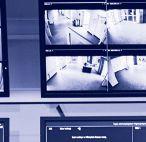


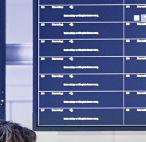






constraints. Failing to comply not only heightens the likelihood of safety and security incidents but could also put hospitals at risk of reputational harm, potential loss of accreditation, a decrease in patient volume and revenue loss.
The Joint Commission has identified key focus areas for mitigating incidents of workplace violence:
■ Access
■ IDing anyone entering a facility
■ Annual worksite analysis
As standards and regulations surrounding workplace safety continue to evolve, organizations can stay prepared by following best practices:
■ MAKE IT PUBLIC. Increasingly, health care organizations are including workplace violence prevention programs in their code of conduct, establishing specific guidelines for badging, identification, designated points of ingress/egress and reporting incidents. By making these programs publicly available, organizations can demonstrate their commitment to creating a safe and supportive work environment for their employees, patients and visitors.

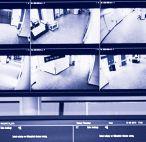


























■ BUILD AN INTERDISCIPLINARY TEAM. FMs should be part of an interdisciplinary team responsible for creating a security masterplan that defines the organization’s safety and security policies, practices and assessments, including the annual workplace assessment. The organization’s security leader may lead this team with input from different departments and stakeholders, including clinical, admittance, IT and patient safety.
There are three categories of security risk assessments:
1. General Facility Risk Assessments: Evaluate the general vulnerabilities of a facility, including the local area, building perimeter, access to a facility and accessible areas inside a facility.
2. High-risk Department Risk Assessments: Health care facilities should assess their high-risk or security-sensitive departments, as identified by the The International Association for Healthcare Security and Safety and The Joint Commission.
3. Situational or Incident-based Risk Assessments: After a serious incident or near miss, it is prudent to gauge contributing vulnerabilities and provide recommendations to mitigate the likelihood of a recurrence.
■ UNDERSTAND THE ROLES. Most FMs will oversee the annual workplace assessment or have input into it. They need to fully understand their role and responsibilities relative to other members of the interdisciplinary committee in conducting evaluations, as well as creating and testing protocols to satisfy the new workplace assessment requirement.
Facility managers should first audit their practices and supplement the audit with industry data to identify potential gaps in compliance with these new standards. For example, the absence of proper ID badge controls may lead to the issuance of badges to unregistered, noncompliant or unqualified vendor representatives. FMs should then regularly assess whether their safety and security protocols and processes are followed and proactively address any issues or gaps.
To avoid the negative consequences of noncompliance, FMs must prioritize conducting a thorough worksite analysis and documenting all actions taken as a result. If possible, partner with a trusted third-party organization or invest in technology that can help monitor and measure activities and progress in alignment with organizational goals.
Fortunately, more modern vendor management solutions are available to help short-handed facility managers automate vendor access. By limiting the paperwork and manual effort needed to manage vendor credentialing and badging compliance, health systems can better address the constantly shifting compliance landscape and help create a safer environment.






















When hospitals experience a steady increase in admissions and procedures, they tend to bring in more staff, patients, vendors and other individuals. Organizations should take a proactive approach to access control and security, beginning with clearly defining badging requirements through training staff. As a result, all staff are empowered to follow through on their training to help ensure ongoing compliance with vendor management and violence prevention policies and procedures.
Hospitals and other health care facilities are places where people seek help and comfort — reflecting the Hippocratic oath of “first, do no harm.” These organizations must prioritize the safety and security of patients, staff and visitors. To comply with the new Joint Commission regulations, health care organizations must establish and enforce policies and procedures that will help protect everyone in their facilities. By fostering a culture of safety, providing comprehensive training, conducting risk assessments and implementing effective security measures, hospitals and health systems can work toward minimizing violence in health care and safeguarding the well-being of both hospital workers and patients. FMJ

Kim Fox is a senior compliance solutions specialist for GHX Vendormate. In this role, Fox works directly with hospitals and other health care providers to evolve and modernize their credentialing and compliance programs.






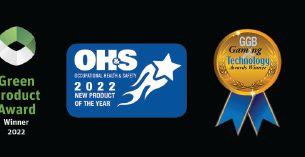
Situatednear the shores of Lake Erie in the northern United States, Holden Forest & Gardens provides unique challenges and opportunities for IFMA member Nico Viola and his FM team. Overseeing a portfolio that includes 3,600-acre outdoor museum and a five-story biome means separate strategies to keep the property vibrant, safe, secure and welcoming to staff, scientists and more than 350,000 annual visitors.







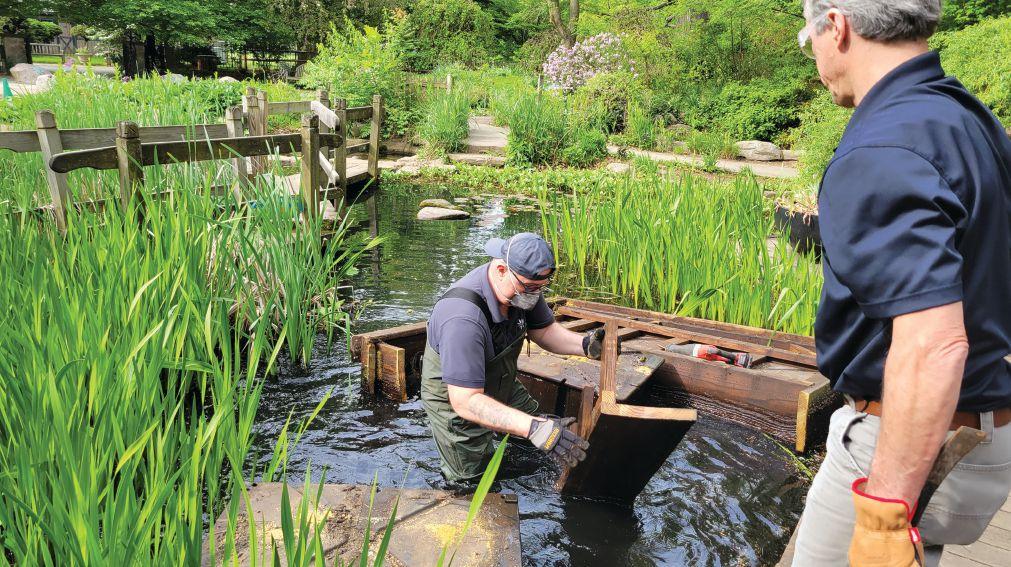


FMJ: Tell us about yourself and how you got into FM.
VIOLA: My journey into FM started as a child working with my grandfather at his rental properties. As I got older, he gave me more responsibility to take care of repairs, collecting rent, snow removal and whatever was needed to keep the properties in top shape. I went to trade school to get certified in HVAC-R and worked as a technician while going to college in the evenings for business administration. By my mid-20s, I was working as a director of facilities managing more than 700 apartments and a staff of 20. I ended up leapfrogging from that into project management and took a position as a national project manager for a large property restoration company and eventually became director of operations for another restoration company before joining Holden Forests and Gardens as director of facilities in 2020. In the last few years, my focus has turned to sustainable facilities practices.
FMJ: What is Holden Forests & Gardens?
VIOLA: Holden Forests & Gardens (HFG) is comprised of two campuses: Holden Arboretum located in Kirtland, Ohio, USA, and Cleveland Botanical Gardens located in nearby Cleveland, Ohio. HFG connects people with the wonder, beauty and value of trees and plants, to inspire action for healthy communities.
The Holden Arboretum is a 3,600-acre outdoor living museum that promotes the beauty and importance of trees and plants to create sustainable healthy communities in the Great Lakes region. HFG is the 14th largest public garden in the United States.
FMJ: What is day-to-day life like at HFG?
VIOLA: Every day is unique. Like most FMs, I spend half my time planning, budgeting, training and working with internal and external partners on projects that are happening simultaneously. We have been performing energy audits, applying for grants for energy upgrades and making changes to our automation to use less power and HVAC. In the past few years, I have been evaluating our fleet and divesting older, inefficient trucks, carts, utility vehicles and machines, swapping them out for EVs, hybrids or more efficient models where possible. In the past couple of months, we have taken possession of our first hybrid police interceptor and a hybrid pickup truck for facilities. I am big on technology that helps us run leaner and greener. I lead a team of three technicians at each campus, plus a mechanic and a facilities coordinator who is a great asset in dealing with the day-to-day issues that arise. We are constantly bringing in different shows and exhibits. Throughout the year, there are many smaller events: weddings, corporate events, educational events, student groups and other situations we accommodate. Every available hour, something is happening someplace on our campuses! Through it all, we make sure that things
VIOLA Director of Facilities
Holden Forests & Gardens Kirtland, Ohio, USA
are maintained, repaired, replaced and upgraded. It doesn’t always go off as planned. Recently, we had a contractor who accidentally hit a 3-inch gas main, which resulted in an evacuation of part of the arboretum campus. Thankfully, there were no injuries, and we were back online the next day; but it’s events like those that keep me up at night.
FMJ: Why is your facility unique and what kind of unique challenges do you face managing the facility and grounds?
VIOLA: HFG is many things to many people. If you asked the public, they would say we are a park or a museum. If you asked a teacher, they would say we are a fun place to have an educational field trip. If you asked our research department, they would tell you we are a world-class research institute. To me, we are all of the above. The Cleveland Botanical Gardens (CBG) campus consists of 11 acres of gardens, a two-story below-ground parking garage, a 90,000-square-foot building and a five-story, 35,000-square-foot biome, which is the largest in Ohio. CBG is in University Circle, which has the highest concentration of museums and cultural institutions of any place in the United States. The Holden Arboretum consists of more than 3,600 acres of land that houses a visitor center, administration and education buildings, a large service yard and the Long Science Center, where our research team is housed. We also have a satellite research center in Madison, Ohio.


CBG’s most unique feature is the biomes. It is divided into three spaces: a working glass house, Madagascar and Costa Rica. Each space has its own custom built air handler, ventilation and humidification systems. I cannot overstate how complicated it is to keep Costa Rica at 80 F with 60 percent relative humidity when it is 20 degrees outside in Cleveland in February! Even with all the assistance the building automation provides, it still requires daily oversight and constant adjustments. Many rare plants, birds, butterflies, frogs, iguanas and other animals call the biomes their home, so we are constantly concerned about their well-being.
As for the Holden Arboretum, it’s more like managing a city. We maintain countless miles of roads, trails and parking areas infrastructure for irrigation and utilities. We have a private water system and sewage treatment plant. One of my team members maintains a Class A operator’s license to operate our water systems. We have many large features and attractions that require inspection and upkeep. The Murch Canopy Walk and Kalberer Emergent Tower are the largest. The tower is 12 stories tall and gives you a bird’s eye view of the campus. The Canopy Walk was built to be ADA accessible and reaches about six stories above the forest floor. We are finishing replacement of the staircases that access Pierson’s Creek Valley. We have our own police department, and I spend a decent amount of time interacting with the chief to make sure we are on top of any security issues that may arise. We have a large fleet of trucks, side-by-sides, golf carts and heavy equipment. How many FMs have a steam roller in their fleet?

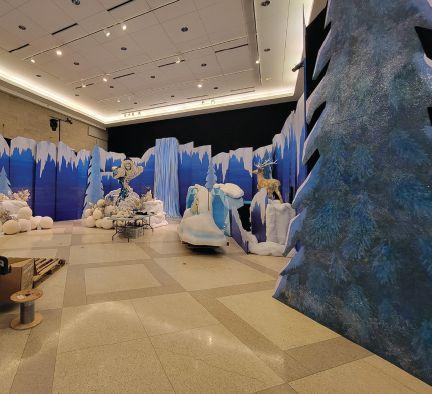


Managing living collections is unique. If we were to lose power or heat in the biomes, rare plants and animals could die, and some irreplaceable. At both campuses, we occasionally get bad storms that cause damage to structures and plants. It’s painful when a specimen that has been on the campus for generations is damaged or destroyed. Our chief of police has developed disaster plans, which facilities assisted in crafting to make sure that we are prepared for as many situations as possible.
FMJ: What is most challenging in making this all happen?
VIOLA: We must do all this in a way that the public sees the magic but does not see the magician. We work hard every day to make sure all our buildings and grounds are in top condition without the public seeing what is happening. There is a theatrical aspect to what we do. Museums and cultural institutions are unique in that the buildings and grounds are not the background, but the star of the show. It makes our work much more important.
FMJ: How much space do you manage and how is it used?
VIOLA: CBG is roughly 90,000 sq. ft., plus 35,000 sq. ft. of biomes on 11 acres. About half of that is public space, while the rest are offices or support space.
The Holden Arboretum consists of more than 3,600 acres of land with around 15 buildings. Half of the buildings are public spaces for visitors, education and events. The rest of the space is used for research, administration, or facilities and horticultural support. We are expanding our service yard as we have outgrown our current space. We completed a new composting area and retention pond last summer. The foundation and floor are in for our new 9,600 sq. ft. vehicle and equipment storage building, and the steel erector will be putting up the building soon.
FMJ: Tell us about your FM team.
VIOLA: I have a wonderful team that makes me look good! Some members of my team have been with the organization for over 25 years, and that’s great because they know what needs to be done and have been empowered to make decisions that they feel are best for the organization. This is a big help, because I divide my time between both campuses. It is great knowing I have people I can trust in my absence. I take everyone’s opinions into consideration as the technicians and housekeepers are the eyes and ears of our organization. They see what’s working and not working in real time and report what changes need to be made and why. Each member of my team has a unique skill set, which you need when you’re as diverse an organization as we are. My biggest concern with my team is how to fill the vacuum of knowledge that will happen when some of them retire in the next few years.
NICO VIOLA Director of Facilities Holden Forests & Gardens Kirtland, Ohio, USA
FMJ: What are some FM challenges you face at Holden that are common across the FM industry?
VIOLA: No matter the building, a leak is a leak. Yes, the biomes are complicated and specialized, but just like my FM peers, much of my time is spent budgeting, planning and dealing with the inevitable emergency. Every FM has plenty of war stories: the fire that broke out on Christmas Eve or the major water leak that happened 20 minutes before the opening of a show. It comes with the gig.
FMJ: How do you manage your decision-making process with so many moving pieces?
VIOLA: With every decision I make, I use the rule of five: How will this decision affect the organization five minutes from now, five days from now, five weeks from now, five months from now and five years from now? In FM, you are constantly refocusing on short- and longterm goals. Some reactions are knee-jerk. During an emergency, you go with your gut based on experience. But when the dust settles, you must take a step back to look at the big picture and make sure that your decisions are what’s best for the organization well into the future.
FMJ: What do you like best about what you do?
VIOLA: I love knowing that the work that I do has an impact on my community. When you set up and open a new show you see the immediate joy it brings to the public. When working on a project like the Pierson’s Creek staircases and overlook with a life expectancy of 75 years, it makes me feel good knowing that the projects I got to be a part of in my time here will be enjoyed by generations of people long after I am gone. FMJ










BY BILL CONLEY

The Acroynmic World of FM


It is an unfortunate constant in the cosmos that no matter how good something may be, there is something bad accompanying it. Every rose has its thorn and plastic was designed to last forever (and it does).
Sir Isaac Newton, in his third law of motion, states, “For every action, there is an equal and opposite reaction” — when one object exerts a force on another object, the second object exerts an equal and opposite force on the first object. An analogy could be made that this theory extends beyond physics and is reflected in life: Opposites attract and tend to counteract each other; so, where there is good, naturally, there is bad.
The dichotomy of good and evil has been prevalent throughout history, and timeless in its relevance to everything that is done in life. But while it is recognized that these concepts of good and bad are not always immediately evident, it should never come as a surprise when something that is perceived as positive creates a counterpart whose impact is negative.
Technology is playing a more essential role in facility management. With the acceleration and wider availability of advanced software, hardware and connectivity options, FMs can streamline operations
and maximize efficiency, save money and energy usage, manage work orders, enhance security, track preventive maintenance schedule and outcomes, and improve overall performance.
Technology’s role in FM is significant, and its importance is increasing.
The hardware and software that monitors equipment and fixtures in the facility is called operational technology (OT). Through the direct monitoring and/or control of facility equipment and assets, it can detect or cause a change in the operation. The term separates the technological and functional differences between traditional information technology (IT) systems and the industrial control systems (ICS) environment.
Some aspects of OT would be building management system (BMS), energy management systems (EMS) and building automation systems (BAS). Automated lighting controls would fall into this category, as well as facility access controls, surveillance cameras and vertical transportation systems.
The difference between IT and OT must be understood, as they are often confused. While operational technology controls equipment, IT controls data. Specifically, OT is concentrated on the physical functions of a facility. IT focuses on securing confidentiality, integrity, and availability of systems and data.
OT incorporates the use of ICS as its main component. ICS consists of myriad types of devices, systems, controls and networks that manage several processes. The most common types of ICS are supervisory control and data acquisition

Technology’s role in FM is significant, and its importance is increasing.

(SCADA) systems and distributed control systems (DCS). Strategically placed sensors communicate data to the SCADA system on a central computer, which manages and controls the information. DCS are used to manage localized controllers or devices in the facility.
The Internet of Things (IoT) describes the network of physical objects (things) that are embedded with sensors, software and other technologies for the purpose of connecting and exchanging data with other devices and systems over the internet. These devices range from ordinary household objects to sophisticated industrial tools. The sensors that make up industrial Internet of Things (IIoT) are components of operational technology and consist of sensors, monitors, actuators and other technologies that are deployed on or near OT equipment. The amount of equipment that is getting connected is growing exponentially and includes generators, pipelines, fans, programmable logic controllers (PLC) and remote processing units (RPU), to name a few.
With more than 7 billion connected IoT devices today, it is projected that this number will increase to 22 billion by 2025. This represents unlimited opportunities for bad actors to compromise technology in the workplace.
To keep up with digital innovation, operational technology systems need to interact with information technology systems.

OT network components like SCADA, DCS and similar networks are now being connected to IT networks. Processors, storage and systems management are being linked with OT. This integration enables the data collected by physical equipment and IIOT devices to identify problems or increase efficiencies. However, such merging of technologies creates more vulnerabilities for attacks.
OT was once isolated networks that nobody in IT was concerned about. OT networks traditionally sat behind air gaps not connected to the outside world and ran on obscure operating systems. Now connecting a previously air-gapped OT network to the internet via an IT network immediately exposes both networks and all connected devices to the threat landscape. OT was not designed with security in mind because it was originally created with the assumption it could not be exposed to threats. Additionally, the rise of remote access to OT networks by third-party vendors further expands the attack surface and creates new unprotected avenues for access. OT stopped being the safe, sequestered system that it was perceived to be.
As FM evolves and becomes more reliant on smart systems and devices, its risk of cyberattack increases. The benefits of using OT to monitor building systems’ efficiency and environmental sustainability are huge. However, the more the systems collect and transmit usage data, the greater the risk of being infected with ransomware.
Implementing and improving cybersecurity for operational technology is another challenge that FMs must face. It presents difficulties in multiple areas. There are the technical aspects. Some of the issues lie with legacy systems, which can be more than 20 years old. These aged systems are rife with exposure issues. Standard OT systems have a long list of cybersecurity concerns: existing equipment with decades long life cycles, the lack of efficient or effective patches to the software, and the fact that there was never a need for user authentication or encryption. There are operational aspects that need to be addressed. Where does the line exist separating facility functions from IT? Proper staff training is paramount, but the question arises: what to teach?
In the harsh reality of the digital world, OT has the double stigma of being the easiest target for intrusion, and an incident would incur more damage to IT. The physical security and the life and safety of employees would be at risk. It is imperative that steps be taken, sooner rather than later. Some best practices suggested by cyber security experts are:
» Have a security program that has the support of senior management.
» Maintain a system inventory of all hardware and associated software.
» Include make, model, manufacturer and age of any equipment. If software is being used to track performance, then note the type and date of installation.
» Perform a risk assessment to determine vulnerabilities.
» Have a comprehensive back-up process in case the system is compromised.
» This should include a redundant system.
» Keep a list of service providers, along with their scopes of work and authorized personnel.
» Maintain
» Full control of system and network access.
» As-built system documentation reflecting current configuration.
» Guidelines for physical access to determine approved users.
» A process for adding and removing users.
» Management of network infrastructure and the physical components.
» Documentation of change management policies and procedures.
» Ensure that periodic security reviews have been completed.
» Plan and exercise incident response and recovery.
» Stay current on cybersecurity trends and threats and train personnel accordingly.
An attack by a cybercriminal on an OT system can create unsafe conditions in a facility, threatening the health and safety of employees. Fire detection and alarms, HVAC systems, access control and other technologies are in place for the protection of people. If these systems are compromised, it constitutes a dangerous situation.
IFMA has recently partnered with Building Cyber Security (BCS), a nonprofit consultant group, to assist FMs in learning about the opportunities and threats that connected technologies present. They have developed training for cybersafety amelioration, providing checklists, assessment tools and certifications to augment cyber protections for the built environment.
It has been evidenced over time that bad things have a greater impact on people than good things. This is known as negativity bias. It suggests that negatives have a stronger effect on thoughts, feelings and behavior than positive events. Negativity bias is at the core of the debate on the relative effects of the struggle between good and bad forces over the course of history. It does not mean that bad will triumph over good. It proves that good proactive and preventive measures can override the negative effects of a bad situation. In nature, organisms that have evolved to prevent or overcome bad things are suggested to flourish and thrive. Innovative technological tools that serve to improve operations come with commensurate threats. Forewarned is forearmed. Bad things can have a stronger effect on people than good things, and a cyberattack could be an ongoing nightmare with unforeseen repercussions. However, it does not mean that the focus should only be on negative possibilities. Understanding and addressing the potential weaknesses and vulnerabilities of a system that could allow a cybersecurity attack can help mitigate the damage of an attack. The probability of when it could happen is much higher than if it could happen. No facility is safe. FMs must rely on the fact that they have done everything possible to safeguard their facilities. In any event, they should absorb and utilize all the information available to them — the tricks of the cyber trade — and strive to create more positive experiences to counterbalance the negativity bias. They would have the capability to ensure that bad things do not happen … or at least that they are minimized. This would be good for them, the employees and their organization. FMJ

Bill Conley, CFM, SFP, FMP, LEED AP, IFMA Fellowisa facility manager at Yamaha Motor Corp. in Cypress,California, USA. He previously served as owner and chief sustainability officer of CFM2, a facility management company. Conley has more than 40 years of experience in the facility management profession and has been a proponent of sustainable operations for more than 20 years. Conley has served on the IFMA board of directors, is a recipient of IFMA’s Distinguished Member of the Year award and has received the association’s Distinguished Author award three times. He has been a regular contributor to FMJ for almost 30 years and has authored 100 FMJ articles.

2-D As-Built Floor Plans
ABM
Aerotek Inc.
AHI FACILITY SERVICES,INC.
Alertus Technologies
Amentum Commercial
APCO Signs
APEX Group
ARC Facilities
Armstrong Ceiling and Wall Solutions
ATI Restoration
BELFOR Property Restoration
Betco Corporation
Bevi
BGIS
Biamp Systems
Blackmon Mooring & BMS CAT
Blink Charging
BluSky Restoration Contractors, LLC
Brightly Software
Brown & Root Industrial
Services
Camcode
Cascade Energy
Caterpillar
Clean-Tech Company
Clockworks Analytics Construction Specialties
Core America
CORT
Davies Office
Diversified Maintenance
eCIFM Solutions Inc.
Eighth Day Design, Inc
Embrava
EMCOR Facilities Services
Engineered Corrosion Solutions
Envoy
Eptura
EthoSource, LLC
Evac Chair North AmericaLLC
Evcor USA LLC
ezCater
Facility Plus
FacilityForce
FEA
FreeAxez LLC
Fresh Products
FSR, Inc.
GardaWorld
GDI Integrated Facility Services
Geospatial Analytics Inc
GOJO Industries
GP PRO (Georgia-Pacific)
Green Shield Products, LLC
GreenTech Environmental
Hawk Research Labs
Haws Corporation
I-CON Systems, Inc.
IFMA Central
InMapz
Instant Power Corp. (Scotch Corp)
Integrated Building Solutions
Interplay Learning

LogiSon Acoustic Network
MilliCare Floor & Surface
Care
Newmark
North American Rescue, LLC
Nuvolo
OfficeSpace Software
Paul Davis Restoration
Perimeter Security Partners
Planon
PlanRadar
Potter Electric Signal
Company
Precision Concrete Cutting
PRIDE Industries
Pro Storm Shelters
Fellowes Brands
First Onsite
Flagship Facility Services
FlexCart
Floodproofing.com
Flynn
FM:Systems FMX FotoFinish
Jacobs
JFC & Associates
JLL Technologies
KBS
Kee Safety, Inc.
Kimberly-Clark Professional
Kings III Emergency Communications
Legend Brands
Limble CMMS
ProxyPics
Re-Stream
Royal Cup Coffee
San Antonio Chapter of IFMA
Securitas Security Services
USA, Inc.
ServiceMaster Recovery
Management
Servpro Industries, Inc
Shure Incorporated
Skudo LLC
Skyfold
Smart Rain
IFMA Corporate Sustaining Partners are listed in bold.


Soft dB
Stop the Bleed
StructureTec Group
Sunbelt Rentals
Surfacing Solutions
Swift Sensors
Tango
Tarkett
Tecta America Corporation
Terracon Consultants, Inc
The Budd Group.
The Davey Tree Expert Company
Tradesmen International, LLC
UL Solutions
VendiBean
Verkada
Versico Roofing Systems
Versteel
VertiGIS
VLogic Systems
Western Specialty Contractors
Wurkwel Ventures
Xcluder - Global Material Technologies
XPEL, Inc.
Yardi Systems
ZOLL MEDICAL



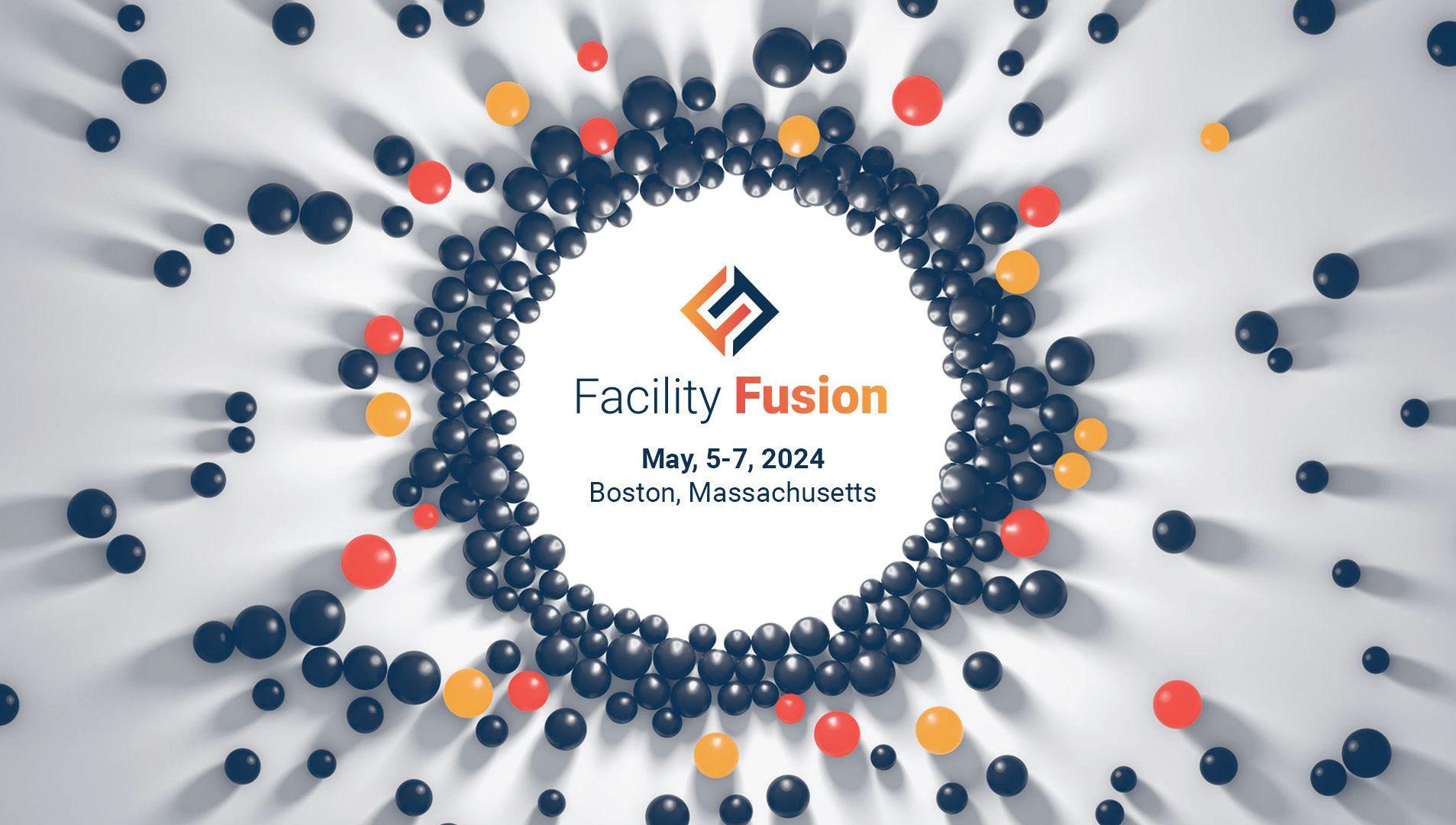
EMCOR
Eptura


ARC Facilities
Clean-Tech Company
Conklin Office Furniture
Davies Office
Dynamic Facility Services
Envoy
Eptura
ezCater
Flagship Facility Services
Floodproofing.com
FMX
Gordian
Hexmodal
Limble CMMS
OfficeSpace Software Inc.
SDI: The Digital Supply Chain Company
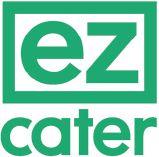

Smart Rain
The Davey Tree Expert Company
U.S. Department of State Bureau of Overseas Buildings Operations
True Data Ops
Vaask
Versico Roofing Systems
EXPO SCAVENGER HUNT
ARC Facilities
Clean-Tech Company
The Davey Tree Expert Company
Limble CMMS
MONDAY POWER TALK ezCater






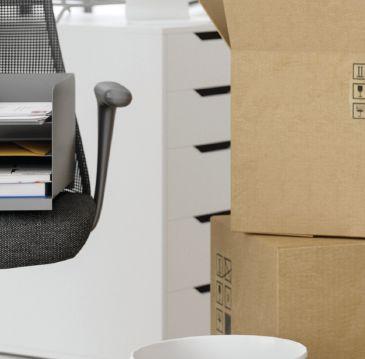
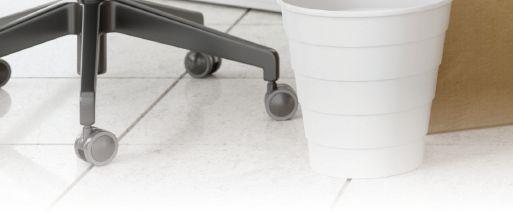
Successful decommissioning in the post-pandemic landscape
BY NICK KLOOS
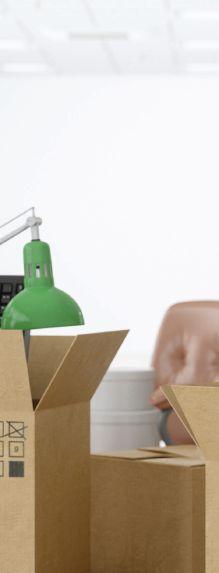







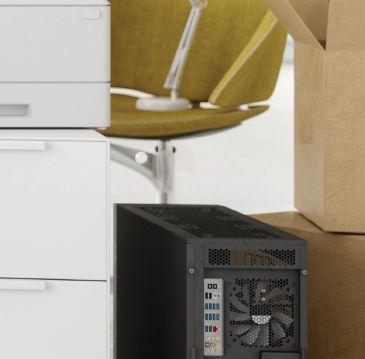
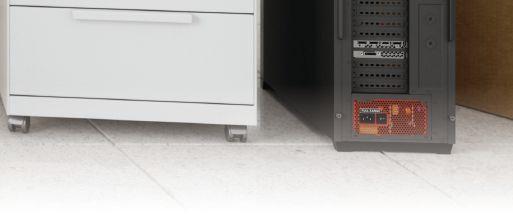


TAs corporations fi nish another year marked by seismic changes in the offi ce market, it is a good moment to stop and take stock of what lies ahead.
More interest rate hikes? Likely.
Ongoing rent decreases? Presumably.
Continued shifts in hybrid and work-from-home options? Certainly .
he silver linings may seem hard to discern with so much upheaval, but one area that organizations can explore to realize significant cost-savings and improved efficiencies is decommissioning. While decommissioning is a normal part of the life cycle for almost all facilities, the current rise in its necessity is dramatic. Downsizing, modernizing and adapting space for a fluctuating on-site workforce and meeting sustainability goals are all major factors in facility managers’ decisions to engage in the complex and multistep process of decommissioning. That process can vary widely depending on the type of facility or system, potentially involving asset disposition, dismantling technology, moving items and dealing with hazardous materials. FM executives should consider these key points when making decisions about decommissioning and how to successfully plan a safe and successful building decommission.









Trends in return-to-office and hybrid work arrangements
In this post-pandemic era, with its continued ripple eff ects, decommissioning is primarily being driven by the shrinking footprint that looms for offi ces as it becomes ever clearer that the workfrom-home genie will never be returned to its bottle. As a Time magazine headline announced in May 2023, “Return-to-Office Full Time Is Losing. Hybrid Work Is On the Rise.”
The article draws some significant statistics from The Flex Report compiled by Scoop Technologies from more than 4,000 companies employing more than 100 million people globally:
• The share of people in the office full time dropped to 42 percent in the second quarter of 2023, down from 49 percent in the first quarter.
• Meanwhile, the share of offices with hybrid work arrangements hit 30 percent in the quarter, up from 20 percent the previous quarter.









Work is moving toward what Scoop Technologies’ CEO Robert Sadow called “structured hybrid,” in which there are a set number of days that people are required to come into the office. The average minimum requirement is 2.53 days, according to Sadow, with two- and three-day schedules both being popular. Tuesday wins as the most often required day, followed by Wednesday and Thursday. Few offices require a Friday presence, and only 24 percent require Monday.
CBRE’s June 2023 report focused on trends in Europe that mirror the changes impacting the U.S. market. The report found that hybrid work situations are proving preferable, with half of those companies surveyed saying they would prefer that employees split time equally between home and on-site offices. Specifically, 38 percent of companies surveyed want employees primarily in the offi ce (three or more days a week) and only 11 percent expect to be mostly remote.
What does this mean for offi ce vacancies and downsizing? In June 2023, the U.S.
office vacancy rate reached 17.1 percent, up 180 basis points from June 2022 with more than half of the top 25 markets above the national average, according to recent data by Commercial Edge. For offi ces maintaining their existing presence or shifting operations to smaller square footage, the need for strategic and sensible decommissioning comes into focus. The logistical challenge of structured hybrid work means companies may not be positioned to dramatically shrink their spaces but must turn their focus to efficient and effective utilization of space they are occupying and paying for.
Downsizing, resizing and right-sizing amenities for today’s workforce
The structured hybrid model seems like a strong middle ground for workers who have developed a preference for flexibility and employers who continue to beat the drum of face-to-face collaboration. As Google’s Chief People Offi cer Fiona Cicconi wrote in an email to employees touting its recently expanded three-day schedule (and its more aggressive enforcement), “There’s just no substitute for coming together in person.”
While Google may be ready and have the resources to go all-in on their structured hybrid model, every company must explore its own needs and expectations to defi ne hybrid for themselves. The challenge for FMs, offi ce planners and business owners is breaking down the implications of a permanent hybrid structure:
• If downsizing would preclude the option for everyone to be in the space at the same time, is there a smart way to shrink the footprint but maximize and utilize the smaller space?
• Should collaborative spaces and customer-facing spaces take priority over individual ones?
• From a financial standpoint, how do companies maximize their output and reduce spending to get savings year after year? There is no one-sizefits-all model.
Narrowing the concerns to employee preferences, FMs must consider how the workspace competes. For someone who has adapted to working from home, returning to an office may mean a downgrade in furniture or amenities. It may mean lack of access to a local coffee shop, good lunch spot, convenient dry cleaner or gym facilities which, in today’s landscape, have reached the level of importance that parking once dominated. Decommissions are often driven by decisions about how to meet requirements like these to get employees back or attract and retain new hires. These concerns constitute a bit of an amenity war, but they are real concerns, nonetheless. Uncomfortable employees are unhappy employees.
Drilling down to a specific example, the workstation is a frequent star player in the decommissioning sphere. The modern workstation is agile. It may off er sit-tostand capability. It may off er “beltline” power and data, creating easy access from the surface rather than at fl oor level. It may offer flexible reconfiguration. Decommissioning outdated furniture or components can lead to space-saving, improved employee satisfaction and better cost-effectiveness in the long term.
Global law firm Jones Day provides an excellent example of an investment in service upgrades for employee comfort and satisfaction. Mid-pandemic, before hybrid even entered the workforce vernacular, Jones Day embarked on a long-term
Cross-generational Attitudes That Will Transform the Built Environment

project that involved a meticulous process of upgrading furniture, paint, carpet, HVAC systems and more. The goal was to allow its partners and staff an outstanding level of daily comfort along with the reassurance that future impacts like the pandemic would not impede their ability to get their jobs done safely and effectively. Putting this all together, the big picture reveals that a smaller footprint with more or better amenities may be the winning formula. The moving and storage industry has certainly taken some wild swings as the trend toward downsizing, resizing and decommissioning evolves, and the momentum behind structured hybrid work models indicates that flexibility and upgrades will continue to be the key drivers for FM.
Decommissioning can encompass a wide range of needs, from a full office move to a remodel in place to a batch upgrade of furniture throughout a facility. Under the
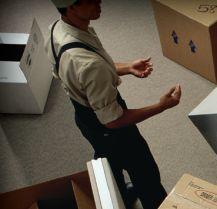

umbrella of decommissioning is a diverse list of processes and services that may come into play, including:
• Asset inventories and value assessment
• Furniture/equipment disassembly and removal
• IT asset disposal
• Cable abatement
• Eco-friendly asset disposal, recycling and reuse
• Hazardous waste disposal
• Storage and warehousing
• Space restoration and/or facility cleanup
The decision to undertake decommissioning can be a daunting one, understandably. But handled systematically, and with a focus on an organization’s core values, the process can be an energizing one. Moving into a new space, refreshing an existing one or meeting the needs of





staff with upgraded amenities and technology are all paths to positive change. Given the realities of post-pandemic corporate life, it is not too surprising to fi nd that there is a new intersection between HR, IT and FM personnel. Decommissioning is a prime example of where that intersection lies as each of these departments has its own unique and vital perspective on space utilization, corporate culture, and what is needed to ensure safety, connectivity, collaboration, ease of use and job satisfaction for all. A great place to start the decision-making process is to tap representatives from these three important groups to begin a collaborative overview of the organization’s wants and needs, within the shared workspace as well as in staff ’s off-site spaces.
Looking back and looking forward are equally important ways to help determine a decommissioning plan. Consider how space, furniture and equipment have been used and identify where those needs are changing now. Cast an eye to the future to consider how needs will continue to evolve. Consider the scramble that ensued in 2020, for example, to get everyone onto laptops to allow work-from-home flexibility. Evaluate the investment in video conferencing capabilities and how that usage is likely to change within a particular industry if staff are returning to the office or traveling to clients again.
It is an inescapable fact that furniture becomes dated, and technology is prone to rapid obsolescence. Decommissioning assets like these, and having a plan for effectively managing electronic waste, on an ongoing basis must be factored into the cost of doing business. The strength of decommissioning with an eye toward sustainability is that it can cushion the financial and environmental impacts of that inevitabil-
ity. Investing in materials that lend themselves to recycling or reuse is one important consideration. Partnering with services that can help with resale or donation, or responsible recycling, is another.
The return-to-office battle is sure to continue informing decisions for the near future, so it is best to push for and facilitate transparency and open communication between management and staff. CBRE’s recent Live-Work-Shop report shows that only 41 percent of European workers wanted to be in the office more than half of the working week. That may not align perfectly with what corporate leaders want, but having a solid grasp on what is practical and achievable is what matters most right now for companies. The key thing to focus on is flexibility. If downsizing or resizing is the right thing to ensure continued financial stability and achieve business objectives, decommissioning will be necessary. Start by devising a plan that will result in a safe and successful process. Seek out expert guidance to minimize waste, meet employees’ and stakeholders’ needs, and maximize the use of current or newly acquired space, regardless of size. Shift perspectives on the financial impact of downsizing or resizing by converting the savings reaped from space reduction into investments in improvement: kick up the finish level on new purchases, go bigger and better on technology, and upgrade chairs or other furniture to improve their longevity and resale value. Find the opportunity within the challenges, creating a win for everyone. FMJ

Nick Kloos is vice president of sales and business development for JK Moving Services’ commercial team. A motivated, organized and passionate leader, Kloos has more than 15 years of business development experience. His moving industry experience includes office, industrial, warehouse moving and furniture installation.
time.com/6281252/return-to-office-hybrid-work cbre.co.uk/-/media/project/cbre/shared-site/ insights/reports/european-office-occupiersurvey-2023/european-office-occupiersentiment-survey-2023.pdf commercialedge.com/blog/national-office-report cnbc.com/2023/06/08/google-to-crack-downon-hybrid-work-asks-remote-workers-toreconsider
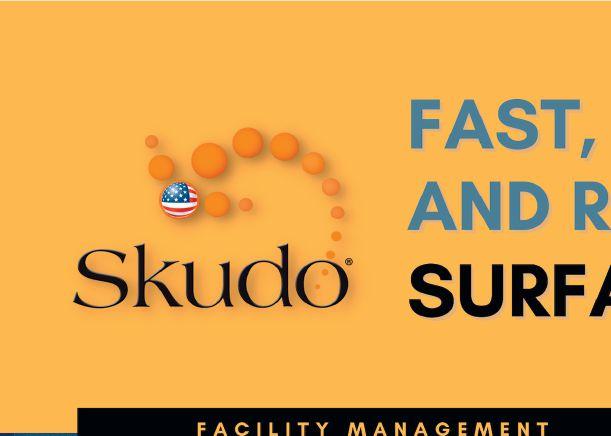
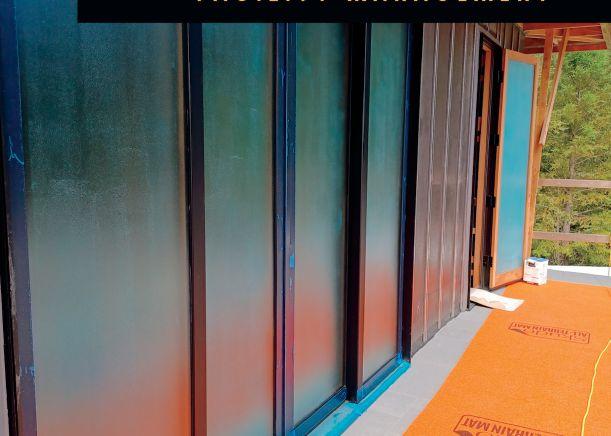


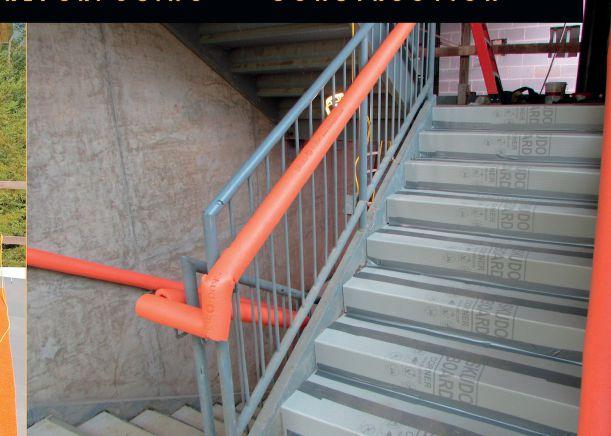


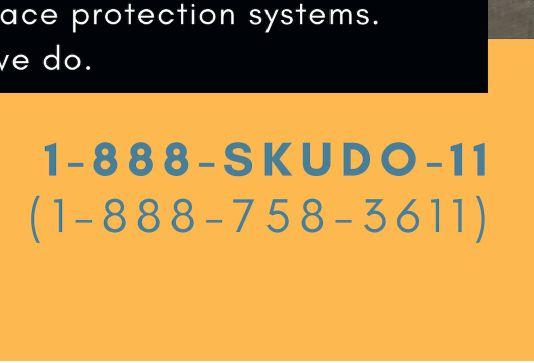
BY MARY GUITEAU
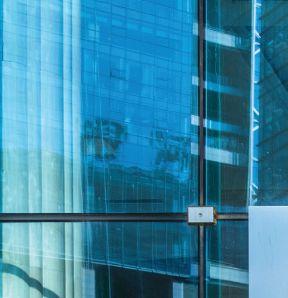
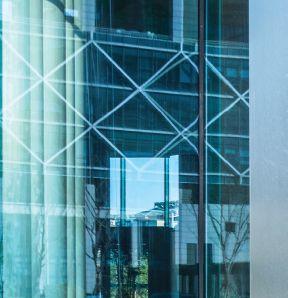
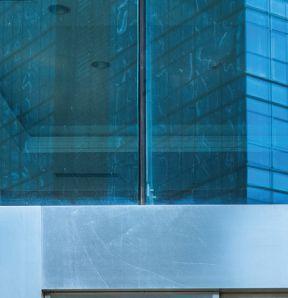










Image is defined as “the general impression that a person, organization or product presents to the public.” An organization can portray its image in many ways: through its branding, its online presence and its facility. Image is of the utmost importance because it can be an organization’s message to the world. Regardless of the organization’s work product or outcomes, image can be a make-or-break factor. A good image can set an organization on a path toward success, resulting in greater productivity and profitability. Adversely, a bad image can lead an organization to failure, resulting in lack of productivity and lack of profitability.




In the world of design, many have concluded that there is only one opportunity to make a first impression. In any organization, its facility makes the first impression – whether good or bad — on visitors, clients and employees. What message is the facility sending? The power of the message is critical, as it can tell others everything about an organization without saying a word. It can relay a brand. It can relay a vision/mission. It can relay a purpose.


The Louisiana Lottery Corp. Headquarters in Baton Rouge, Louisiana, USA, is undergoing an interior renovation to better facilitate the new hybrid work styles of its employees and to create an image that is better aligned with the company’s branding. The organization is known for giving away money in a celebratory fashion as well as providing funding for state education. The refreshed design brings an element of celebration and fun to the office building.

It can relay a brand. Most organizations have a curated set of branding guidelines, which direct all print and online communications. However, those guidelines do not often translate to the organization’s facilities. This can create a disconnect. When people spend their time in a facility that is in line with the organization’s brand, it creates a cohesive thread. Visitors, clients and especially employees are then able to live the brand. This also creates a marketing opportunity, with the facility itself serving as a marketing tool for the organization. Imagine walking into a space and becoming instantly immersed in the brand without anyone saying a word. That sends a strong message. Additionally, when employees are able to live the brand day in and day out, they are more likely to carry that brand beyond the facility’s doors.
It can relay a vision/mission. Every organization has a vision and a mission, whether formalized through vision and mission statements, or simply spoken and understood. That vision and mission are what guide everyone in the organization toward a common goal. When the facility is designed in such a way as to promote the vision and mission, it helps keep that critical information at the forefront. Some organizations display their vision and mission statements on the wall; others use the facility as a means to relay the vision and mission. The old adage, “out of sight, out of mind” is true here. If the organization’s vision/mission are not in sight – whether literally or figuratively — employees are less likely to work in support of those values and goals.
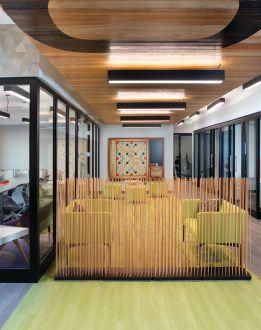


Technology company Envoc’s mission statement is as follows: “Envoc is an award-winning digital marketing and software development firm whose mission is to provide ‘A Better Reality’ for our team and our clients through radical creativity and productivity.” All of Envoc’s office facilities throughout Louisiana have been designed to create a better reality for its team and clients, providing an environment that promotes creativity.



It can relay a purpose. Practically speaking, the purpose of a facility is the most essential element to its existence. Why is it here? How is it used? How can it enhance the lives of the people who frequent it? A facility’s image can relay that purpose to all who visit the space. If it is an industrial educational institution, then an industrial-style facility with exposed structure, exposed systems and natural materials would echo the purpose. If it is an executive floor that hosts high-level meetings and high-level clientele in a corporation’s headquarters building, a refined aesthetic with more of a hospitality feel and high-end finishes would illustrate the purpose.
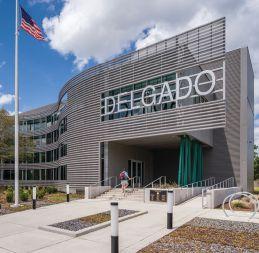





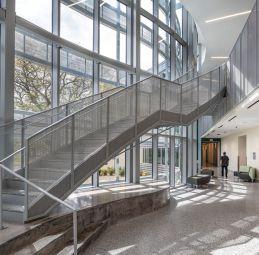


Delgado Community College’s Advanced Technology Center in New Orleans, Louisiana, USA, houses academic STEM programs, labs and faculty to serve academic and workforce programs, specifically the health care, petrochemical, digital media and transportation logistics industries. The purpose of the facility is to educate and train students in these fields. The facility itself echoes that purpose.




The Barnes-Ogden Art & Design Complex at Louisiana State University in Baton Rouge houses multiple art and design programs. Its purpose is to educate students in programs such as painting, sculpture, ceramics and drawing. The first building built on the LSU campus, circa 1910s, this historic facility was recently renovated to provide much-needed updates. A new art gallery was added to create a connector between building wings, and to provide visibility into the purpose of the art and design programs.

While the first impression of a facility gives an outward message, mainly to visitors and clients, the type of work environment that is being provided gives an inward message, mainly to the people who work in the building. What message is it sending to a company’s employees? Is the work environment old and static or new and engaging?
For business owners and organizations, facilities are a big expense. It can be easy to spend money on running the business and not on the facility itself. How much time and money are being invested in creating an engaging work environment for employees? Studies have shown that a healthy workplace equals happy and productive employees. To take it a step further, productivity equals profitability. Therefore, the return on investment for providing an engaging work environment is a positive one. Additionally, attracting employees to come back to the office post-pandemic is a real issue. When people are used to the comforts of home, the idea of going back to an old and static work environment is not enticing. Many organizations are renovating their facilities to provide refreshed spaces with upgraded breakrooms and better lounge areas to entice employees to come back to the office.
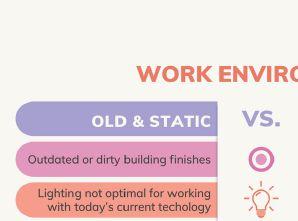

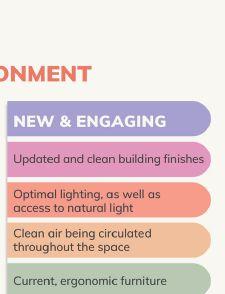

While first impressions and work environment are critical, nothing is more important than facility maintenance. Owners can invest money to create well-designed spaces, but if those spaces are not well maintained, the return on investment can go unrealized. Facilities upkeep is a key component to a successful project for everyone involved. When a facility is not well kept, it creates a negative perception for both employees and visitors. The perception is that a well-kept facility equals a well-kept company. If an organization is interviewing someone for a new job, and that person sits in a conference chair that is torn on a carpet tile floor that is stained, that could cause the interviewee to wonder what that says about the
company: If the company is not willing to take care of its building, how would it plan to take care of its employees? While the correlation of building maintenance may not accurately correlate to the way a company treats its employees, the perception could cause one to question that.





The Entergy Aerosol building in Hammond, Louisiana, USA, underwent an interior renovation due to work style changes post-pandemic. To provide a more hybrid workspace and encourage workers to come back to the office, the work environment was transformed from an enclosed, outdated space to an open, bright, modern space that promotes employee wellness and collaboration. The result: workers are now eager to work in the energized office.

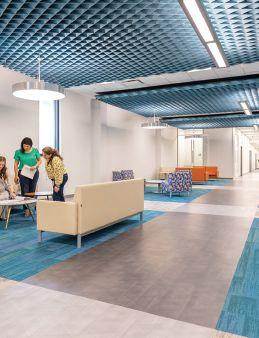
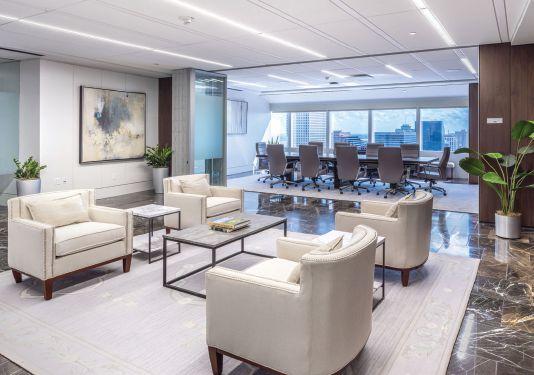













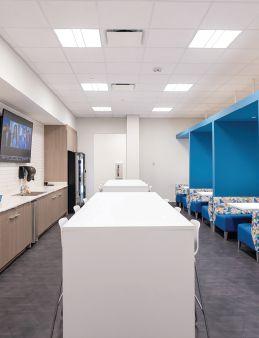

AFTER BEFORE AFTER Mary Mowad Guiteau is the associate principal/director of interior design at Holly & Smith Architects, APAC, which has offices in Hammond, New Orleans, and Lafayette, Louisiana, USA. A graduate of Louisiana State University, she has over 26 years of commercial design experience, working with owners, facility managers, users, developers and real estate companies. She is a member of IFMA Baton Rouge chapter.
This New Orleans, Louisiana, USA, corporate office headquarters’ executive lobby and conference room is well maintained to uphold the image of the work that takes place there.

Facilities can play a critical role in portraying an organization’s image. Regardless of the organization’s work product or outcomes, image can be a make-or-break factor. A good image can set an organization on a path toward success. Adversely, a bad image can lead an organization to failure. Image is of the utmost importance because it can be an organization’s message to the world. What message is the organization sending? FMJ
The following people were awarded the Certified Facility Manager® (CFM®) certification in SEPT. 2023:
Udodi Nwachukwu, CFM, FMP, SFP Toronto, ON, Canada
Abdullah Abdulsamad, CFM, FMP
Riyadh, Saudi Arabia
Ali Akram Bhalli, CFM
Sialkot, Pakistan
Joshua Duran, CFM San Marcos, Texas
Christopher Lambert, CFM Fishers, Indiana
Calyb Stebbins, CFM Tomball, Texas
Nimesh Kumar Mishra, CFM
Abu Dhabi, United Arab Emirates
Miguel Luna, CFM, FMP
Houston, Texas
Eva Lo, CFM Hong Kong
Amy McDowell, CFM Chesapeake, Virginia
Alice Bo Ting Ming, CFM
Hong Kong
Manimaran Thiagarajan, CFM Dubai, United Arab Emirates
Abdulmalik Owojori Abubakar, CFM
Kano, Nigeria
Mohammed Al Qudah, CFM
Amman, Jordan
Yaqoub Alsayed, CFM
Doha, Qatar
The following people were awarded the Sustainability Facility Professional® (SFP®) designation:
Andreea Ivan, SFP Bucharest, Romania
Edwin Bermudez, FMP, SFP Clayton, North Carolina
Mariam Hamdy, SFP 6th October, Egypt
Ahmed Ali Osman, SFP Cairo, Egypt
Mary Braun, SFP Ann Arbor, Michigan
Joshua Boyd, FMP, SFP Spring Hill, Florida
Amr El Mahdy, FMP, SFP Cairo, Egypt
Raymond Vega, FMP, SFP Lake Worth, Florida
Ian Thayer, SFP Mountain View, California
Ka Hei Chow, SFP Hong Kong
Jen Weishuhn, FMP, SFP Waterloo, ON, Canada
Ahmed Nasr, FMP, SFP Cairo, Egypt
Richard Simons, CFM, SFP Stony Plain, AB, Canada
Robert Shively, CFM, SFP Leesburg, Virginia
Katherine White, FMP, SFP Winnipeg, MB
Deni Gigunes Kelvin, CFM Dubai, United Arab Emirates
Elizabeth McDonald, FMP, SFP
William Sconzert, FMP, SFP
Adel Soliman, FMP, SFP
Egypt
The following people were awarded the Facility Management Professional™ (FMP®) designation:
Felix Oluwalomola, FMP Lagos, Nigeria
Amer Hazza AlSharif, FMP
Jeddah, Saudi Arabia
Melody Tolliver, FMP Mesa, Arizona
Wei Fang, FMP Shanghai, China
Joseph Heinz, FMP Salem, Wisconsin
Dana Carrow, FMP Edwardsville, Illinois
David Sammons, FMP Glenford, Ohio
Ron Erick Revilloza, FMP South San Francisco, California
Michael Le, FMP Mississauga, ON, Canada
Tiffany Smith, FMP St. Louis, Missouri
Matt Campbell, FMP Mason, Michigan
Pete Fay, FMP United States
Mothakani Padmavathi, FMP Hyderabad, India
Tommy Carpenter, FMP Lubbock, Texas
Michael Gay, FMP Tampa, Florida
Robert Meza, FMP Fort Worth, Texas
Charles Douglas, FMP Hondo, Texas
Cheryl Johnson, FMP Ashburn, Virginia
Jeremy Owen, FMP Fairfield, New Jersey
Nicolas Haddad, FMP Northridge, California
Stephan Bray, FMP Sachse, Texas
Asem Almahdi, FMP Saudi Arabia
Avana Ramdial-Liverpool, FMP
Cunuipia, Trinidad and Tobago
Marina Lang, FMP Washington, District of Columbia
Michael Blanco, FMP Summerville, South Carolina
John Majors, FMP Waxahachie, Texas
Kenneth Couch, FMP Weatherford, Texas
Brandon Clark, FMP Dallas, Texas
Troy Taylor, FMP Austin, Texas
Joseph Hunze, FMP Manchester, Missouri
William Miller, FMP Hoffman Estates, Illinois
Josh Horstmyer, FMP Lansing, Michigan
Mackenzie Knapp, FMP New York, New York
Lisa Brown, FMP Calgary, AB, Canada
Joe Lujan, FMP Celina, Texas
Sean Dunlop, FMP Mississauga, ON, Canada
Toufic Salem, FMP
Riyadh, Saudi Arabia
Abdulaziz Bin Osfur, FMP Riyadh, Saudi Arabia
Clarence Bryant, FMP Crofton, Maryland
Tai Le, FMP Ventura, California
Laura Kuhn, FMP
Charles Town, West Virginia
Trevor Desjardins, FMP Ottawa, ON, Canada
Thomas Guadagno, FMP Belcamp, Maryland
Stephen Duncan, FMP Ajax, ON, Canada
Abdullah ALghannam, FMP
Riyadh, Saudi Arabia
Abbey Pascoe, FMP Carbondale, Colorado
Vijayachandra Kondeti, FMP Guntur, India
Ryan Bernier, FMP Niverville, MB, Canada
Bradford Lang, FMP LaPlace, Louisiana
Gundeep Sidhu, FMP Bella Vista, Australia
Tasha Chin, FMP Alameda, California
Derrick Lawson, FMP Inglewood, California
Adam Novell, FMP United States
Kevin Bruning, FMP Washington, District of Columbia
Ahmed Alhussain, FMP Riyadh, Saudi Arabia
Ahmed Alraeesi, FMP Dubai, United Arab Emirates
Matthew Selvaggio, FMP Springfield, Illinois
Paula Carbone, FMP Amarillo, Texas
Rob Fulton, FMP Kamloops, Br Canada
Alex Barth, FMP Antioch, Illinois
Ahmed Almutairi, FMP Riyadh, Saudi Arabia
Carcamoandino Allan, FMP United States
Salman Alasmari, FMP Riyadh, Saudi Arabia
Shakeel Sheikh, FMP Mississauga, ON, Canada
Cassandra Davis, FMP Boulder, Colorado
Amro Zuhair Almadhoun, FMP Dubai, United Arab Emirates
Lindsay Anderson, FMP Lubbock, Texas
Natalie Thompson, FMP Fort Worth, Texas
Robert Simmons, FMP Belton, Missouri
Stephen Heinz, FMP Springfield, Illinois
David Herrington, FMP Brentwood, California
Mohamed Alharbi, FMP Riyadh, Saudi Arabia
John Kerber, FMP Philadelphia, Pennsylvania
Ted Blenkush, FMP Duluth, Minnesota
Jason Anderson, FMP Las Vegas, Nevada
Mani Gandan Perumal, FMP
Bangalore, India
Bikash Dhungel, FMP Okotoks, AB, Canada
David Nichols, FMP
Morristown, Tennessee
Shubhi Gulati, FMP Vancouver, BC, Canada
Abdulrahman Y. Alhoshan, FMP
Riyadh, Saudi Arabia
Christian Servant, FMP
Fairfax, Virginia
Faisal Saleh, FMP Katy, Texas
Naif Altubaishi, FMP Riyadh, Saudi Arabia
Benjamin Baird, FMP Ottawa, ON, Canada
Abdullah Alotaibi, FMP Riyadh, Saudi Arabia
James Qiu, FMP Shanghai, China
Ting Liu, FMP Shanghai, China
Souren Chakraborty, FMP Bangalore, India
Abdul Rehman, FMP Edmonton, AB, Canada
Sriram Posinasetty, FMP Tempe, Arizona
Thomas Wise, FMP Livingston Manor, New York
Tony Vellante, FMP Marlborough, Massachusetts
Keri Iwanok, FMP Rogers, Minnesota
Nathan Oleksyn, FMP Gainesville, Virginia
Hosam Basaffar, FMP Dharan, Saudi Arabia
Fares Alshehri, FMP Riyadh, Saudi Arabia
Matthew Araujo, FMP
Petit Valley, Trinidad and Tobago
Alicia Moore, FMP San Diego, California
Robert Owens, FMP United States
Nawaf Hamad Alsubaie, FMP Dammam, Saudi Arabia
Mazin Owidah, FMP Madinah, Saudi Arabia
Patrick McClutchy, FMP Stafford, Virginia
Jamil Arslanbayov, FMP Baku, Azerbaijan
Wanzhen Tan, FMP United States
Sahal Mohamed, FMP Mississauga, ON, Canada
Maria Iordanova, FMP Phoenix, Arizona
Anthea White, FMP Longmont, Colorado
Michael Dolan, FMP Phoenixville, Pennsylvania
Touri Heath, FMP New York, New York
Jonathan Hennessy, FMP Raleigh, North Carolina
Ashish Dev, FMP Coquitlam, British Colombia, Canada
Vera Flores, FMP Whittier, California
Derek Morganti, FMP Albuquerque, New Mexico
Shaman Sahabandu, FMP Katana, Sri Lanka
Curtis Kalk, FMP Deerwood, Minnesota
Andrew Page, FMP Norfolk, Massachusetts
Meshari Aldebas, FMP Riyadh, Saudi Arabia
Stefanny Polley, FMP Lake Worth, Florida
Evan Barrett, FMP Edmonton, AB, Canada
Angela Lamothe, FMP Palo Alto, California
Ravin Das, FMP Pune, India
Blakleigh Buck, FMP Mobile, Alabama
Abdullah Almehmadi, FMP Almadiah, Saudi Arabia
Noel Dsouza, FMP Pune, India
Dale Moore, FMP San Jose, California
Ahmed Avdic, FMP Clawson, Michigan
Omer Ahmed Abduelsalam Osman, FMP
Sudan
Fares Alshaikh, FMP Jeddah, Saudi Arabia
Darren Brennan, FMP Woodside, New York
Joe Harris, FMP Churchville, Pennsylvania
Zach Johnson, FMP
Alexandria, Virginia
Brant Miller, FMP Austin, Texas
Lena Lynch, FMP Columbus, Ohio
Shahad Alharbi, FMP Riyadh, Saudi Arabia
Ryan Sheehan, FMP Burlington, ON, Canada
Daniel Scott, FMP Bel Air, Maryland
Yousef Alghannam, FMP Riyadh, Saudi Arabia
Susan Mosher, FMP Culpeper, Virginia
Renny Braun, FMP Redondo Beach, California
Janani Balan, FMP Abu Dhabi, United Arab
Emirates
Hand Ramdani, FMP Lieusaint, France
Christina Weber, FMP Washington, District of Columbia
Awwadh Alosaimi, FMP Riyadh, Saudi Arabia
Nicole Street, FMP Renton, Washington
Dave Schmitt, FMP Algona, Iowa
Alex Cuboni, FMP San Jose, California
Estefani Ulerio, FMP United States
Jason Zoldak, FMP Spotsylvania, Virginia
Mohammad Alaseri, FMP Dhahran, Saudi Arabia
Alison Tyler, FMP San Diego, California
Harold Graham, FMP Delta, BC, Canada
Carmen Chrysafis, FMP New Jersey
Clifferd Crull, FMP Oklahoma City, Oklahoma
Ahmed Fatani, FMP Jeddah, Saudi Arabia
Ibrahim Alshadi, FMP Riyadh, Saudi Arabia
Chandra Mohan, FMP
Singapore
Jason Palmer, FMP Woodbridge, Virginia
Kumud Bharti, FMP Mumbai, India
Ethan Lang, FMP Baltimore, Maryland
Alwin van Ombergen, FMP
Heinkenszand, Netherlands
Erik Wester, FMP United States
Joseph Selvam, FMP
Singapore
Michael Thomas, FMP Washington, District of Columbia
Videsh Singh, FMP Scarborough, ON, Canada
Todd Muir, FMP
Sandy, Utah
Maximo Garcia, FMP El Monte, California
Andrew Pane, FMP Mineola, New York
Sulaiman Sulaiman, FMP Auckland, New Zealand
L
Michael Balla, CFM
Rocky River, Ohio
Eric Yeager, CFM San Francisco, California
Mohamed Teaima, CFM
Al-Ahsa Saudi Arabia
Mohamed Soliman, CFM Riyadh, Saudia Arabia
Shailesh Yelwande CFM Maharashtra, India
Olivia Fisher, CFM Las Vegas, Nevada
Julie Martin, FMP, SFP Toronto, ON, Canada
Ryan McMillan, CFM, SFP Salt Lake City, Utah
Martin Vaclavik, SFP Prague, Czech Republic
Mohammad Jamal Akhtar, FMP, SFP New, Delhi, India
Judy Wilkinson, SFP Wilsonville, Oregon
Khalid Al Falahy, SFP United Arab Emirates
Ahmed Osman Hassan FMP, CFM Khartoum, Sudan
Christopher York, CFM Tulsa, Oklahoma
Lik hang Lam CFM Hong Kong, China
Andrew Moore, FMP, CFM Flower Mound, Texas
Otah Ejidoh CFM Benin, Nigeria
Brad T Jones, CFM Leupp, Arizona
Wael Gamal, SFP New Cairo, Egypt
Richard Oliver, FMP, SFP Kittery, Maine
Raed Alfaifi, FMP, SFP Riyadh, Saudi Arabia
Giselle Holder, CFM, FMP, SFP Port Of Spain, Trinidad and Tobago
Abdulelah Al-Sunbul, FMP, SFP Riyadh City, Saudi Arabia
Sonjayy Dahiya, SFP Sonipat, India
Diljot Brar, CFM Winnipeg MB Canada
Suhib Zaidiyah, CFM Abu Dhabi, United Arab Emirates
Kevin Blume, FMP, CFM Bastrop, Texas
Faizan Mahmood, CFM Peshawar Pakistan
Solomon Murungi Byara, CFM Kampala, Uganda
Walid Khaled Kamel, CFM Riyadh, Saudi Arabia
Emanuele Sottile, CFM, SFP Las Vegas, Nevada
Miles Friend, FMP, SFP Morton Grove, Illinois
Ibrahim Baharoon, SFP
Abu Dhabi, United Arab Emirates
Amber Pizzola, SFP Forest Grove, Oregon
Basel ALSaeed, FMP, SFP Saudi Arabia
Bader Alghamdi, FMP, SFP Sharma, Saudi Arabia
Mohamed Fahad, CFM Wukair, India
Cameron Mitchell, CFM Lucan, ON
Patrick Obiora Nduka, CFM Shomolu, Nigeria
Sheejith Payyaratta CFM Doha, Qatar
Roy Carmona CFM Dubai, United Arab Emirates
Ahmad Al-Obaidli, CFM Doha Qatar
Christopher Johnson, SFP Rock Hill, South Carolina
Brandi Smith, SFP Little Rock, Arkansas
Tiffany Durr, SFP McPherson, Kansas
Paul Mathews, CFM, FMP, SFP Salt Lake City, Utah
James Liu, FMP, SFP Pudong District, China
Billie Statom, FMP, SFP Huntsville, Alabama
Arun Jaison, CFM Dubai, United Arab Emirates
Richard Young, CFM Houston, Texas
Christopher Good, FMP, CFM Fleming Island, Florida
Ramy Almaasrawy, CFM Tanta, Egypt
Osama Aldali, CFM Doha, Qatar
Joshua Lawrence, CFM, FMP Jacksonville, Florida
Suresh Tata, CFM Hyderabad, India
Islam Obeidat, CFM Riyadh, Saudi Arabia
Quinlan O’Brien, CFM Orland Park, Illinois
Saravanan Ayyanar, CFM
Abu Dhabi, United Arab Emirates
Babar Ali, CFM Karachi, Pakistan
Cynthia Nowembabazi Kitimbo, CFM Kampala, Uganda
Collins Oduka, CFM Kampala, Uganda
Lisa Hines, CFM Roswell, Georgia
Randy Groff, CFM, SFP Ephrata, Pennsylvania
April Morris, CFM, SFP Greer, South Carolina
Salman AlThuyayb, FMP, SFP Riyadh, Saudi Arabia
Brandon Chocklett, FMP, SFP Elkton, Florida
Micah Arnold, FMP, SFP Aromas, California
Rahul Radhakrishnan, SFP Dubai, United Arab Emirates
Zhuo ie Yu FMP Shanghai Ch na
Yong iang Wang FMP
Shanghai Ch na Hui in Chen FMP
Shanghai Ch na
Chao Shen FMP
Shanghai Ch na Yuhua Du, FMP Shanghai Ch na Xue Bai FMP Shanghai Ch na Yuyang Song FMP Shanghai Ch na Xinhong L , FMP Shanghai Ch na Haifu Wang FMP
Shanghai Ch na Xiaoyu Han FMP Shanghai Ch na Zhiyuan Xia FMP Shanghai Ch na Tao Lu FMP Shanghai Ch na J aoj ao Zhu FMP Shanghai Ch na Song Peng FMP Shanghai Ch na Hao Chen FMP J angsu China
Rahu Divakaran FMP Brampton ON Canada
Othman Maqbu Alghamdi, FMP Riyadh Saud Arabia
Megan Rios FMP Howe l Mich gan
Arab a Joe Conklin FMP West Sacramento California
Muj b Baig K FMP Villupram India
Daniel Doman FMP
R o Rancho New Mexico
Haseeb U Hassan Zahid FMP R yadh Saud Arabia
Brandon Sackett FMP St Lou s Missouri
Kodey Gray FMP
Oak R dge TN
Abdullah Alanazi FMP
R yadh Saud Arabia
Par n Patel FMP
Ajax ON Canada
James Freyder FMP Baton Rouge LA Shuang Dai FMP Shanghai China
Yong Wang FMP Shanghai China
Sarah Zellner FMP Howe l MI Basel Abdu razag FMP Riyadh, Saud Arabia
Man unath Muniyappa FMP Bengaluru India
Sahm Alha ri FMP Dhahran Saud Arabia
Kevin Mohan, FMP Toronto, ON, Canada Marcela Sanabria FMP Marietta Georgia Mustafa Abdu zahra FMP Al-Shatra Iraq Kevin Carter FMP San Anton o Texas N rbhay S
Shamun Mahmud, SFP Bothell, Washington
Darren Johnson, SFP Elkhorn, Nebraska
Sam Garrett, SFP Englewood, Colorado
Benjamin Olagadeyo, SFP Newark, New Jersey
Andrew McDaniel, FMP, SFP Elgin, Illinois
Eva Lo, CFM, SFP Hong Kong
Aykean
Ali J. Sudairy, SFP Saudi Arabia
Bryan Martin, FMP, SFP Dulles, Virginia
Todd Lunden, FMP, SFP Freemansburg, Pennsylvania
Zachary Dahn, FMP, SFP Reno, Nevada

BY JON DOMMISSE










2023 Healthy Handwashing Survey


One might say that commercial restrooms are the unsung heroes of commercial buildings. They are indispensable, unique, one-of-a-kind public spaces that seem to get a bad rap more often than not. Yet they increasingly require facility management’s time, attention and care.







Every commercial building has a restroom — sometimes facil-
restroom sometimes multiple facil ities — that are used by almost every person who enters the building. As such, public restrooms are high-use and high-visibility, making them high-impact areas for all building occupants and stakeholders.

ddUpgraded maintenance strategies new solutions are available

Restrooms are distinctive in that they are tight enclosed spaces in which people use toilets, have many germy touchpoints (about 10 in a single visit), and contend with indoor air quality issues, including airborne pathogens as well as disagreeable odors.
Additionally, restrooms utilize volumes of water, soap and paper products that are costly and can potentially create mess, slips, and falls and breed bacteria. They also require much of facility staff ’s time and energy for regular cleaning, restocking and maintenance throughout the day.
To a layperson, restroom maintenance may seem straightforward and a business no-brainer. However, limited budgets and facility staffing issues mean that companies are having to do more with less staff and resources. Today, over-stretched maintenance staff are on the lookout for restroom products, technologies and features that improve maintenance, save time, cut costs and make their jobs easier.
Fortunately, new solutions are available to support restroom cleanliness, infection control and reliable handwashing for building occupants, while optimizing maintenance and driving efficiency. For example, restroom products with maintenance indicators, IoT connectivity and A/C power (rather than batteries) simplify maintenance capabilities. Sustainable product designs like all-in-one handwashing models and nonporous sink materials also help reduce germs and upkeep.
Not only do maintenance indicators give facility staff advance notice when something needs to be refilled, restocked or addressed in some way, this smart technology also gives building occupants confidence in knowing that the restrooms will be regularly stocked and cleaned.
To further anticipate and enhance restroom maintenance, it is also important to recognize the current drivers of change that are impacting restrooms and the people who use them.

Today, the public’s expectations for clean restrooms are higher than ever. Increased demand stems from worldwide public infectious health concerns, such as the coronavirus pandemic and the spread of any germs that cause illness, whether it be a COVID variant, RSV, norovirus or flu virus. People associate a hygienic restroom experience with health, safety and well-being. While it has been for a
While it has always been important for a restroom to look and smell clean, now it is an absolute necessity.

There is also a strong relationship between a restroom’s cleanliness, maintenance and functionality, and a business’ or establishment’s overall image and even profitability. Research illustrates how customers place a high value on clean restrooms — and reward businesses that offer them.
According to the 2023 Healthy Handwashing Survey™ conducted by Bradley Corp., 60 percent of Americans say they would willingly spend more money at a business with clean, well-maintained restrooms. Another 60 percent say when out running errands they take restroom breaks at a business they know has “good” restrooms. Conversely, “bad” restrooms have the opposite effect. More than half of respondents say an unclean or unpleasant public bathroom shows poor management and causes them to lower their opinion of the overall establishment. Fifty-two percent
There is also a strong relationship between a restroom’s cleanliness, maintenance and functionality, and a business’ or establishment’s overall image and even profitability.

also say a negative restroom experience causes them to vow not to return in the future or think twice about doing so.
Identifying restroom user pain points and grievances
Unfortunately, restrooms intrinsically carry a certain “ick factor” that impacts how people view and use these public facilities. In turn, these perceptions and behaviors affect — and inform — facility maintenance strategies.
According to the survey, the most common restroom frustrations include clogged or unflushed toilets; an overall appearance that is old, dirty or unkempt; unpleasant smells; and empty or jammed dispensers for soap, toilet paper and hand towels.
Another pet peeve uncovered by the survey is having to touch bathroom surfaces, which is not surprising as people continue to be in an elevated state of germ consciousness following the pandemic. Plus, no one wants to touch things after somebody else just touched them, especially right after using the toilet. The majority go out of their way in bathrooms
to avoid any skin contact, with 62 percent of people stating they use a paper towel as a barrier to avoid touching flushers, faucets and doors. Women are even more likely to rely on paper towels, with 67 percent taking this evasive measure.
Others employ sheer physicality to steer clear of germs. Forty-three percent use their foot to flush toilets (much to the dismay of maintenance staff because flushing mechanisms can get stuck or break), 31 percent hover over the toilet seat, and 27 percent open and close doors with their backside in
hopes of avoiding contact. Women are significantly more likely than men to employ these actions.
Cleanliness routinely tops lists of restroom improvements users would like to see. Access to touchless fixtures and better stocking of supplies, such as toilet paper, soap and paper towels, were other high requests.
With so much effort going into evading germs, it is no wonder that 82 percent of adults believe it is important to have touchless fixtures in a public restroom. 60 percent say they are more likely to return to a business that offers no-touch capabilities in its restrooms. It appears the days of handled and levered faucets in restrooms are numbered and touch-free technology is the new gold standard.
In the U.S., the top touchless restroom features considered most important are faucets, flushers, soap dispensers and paper towel dispensers.
The good news for building staff and restroom users alike is that the mechan-
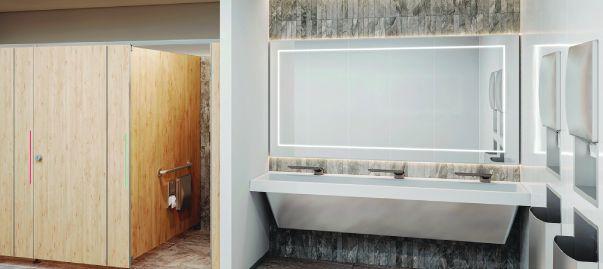


















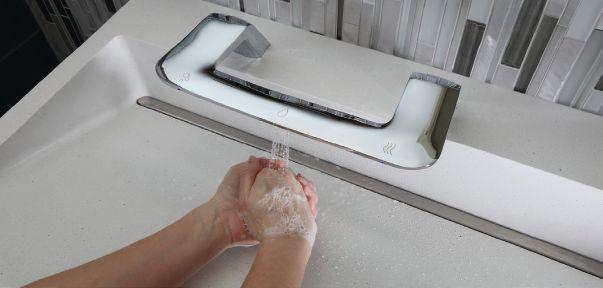
icals used in sensor technology have been improved over the past several years. Specifi cally, faucets incorporate highly sensitive sensors and options for ultra-low flow demands. While some older touchless models include sensors that deliver unreliable soap and water activations, today’s designs incorporate advanced sensing technology ensuring continuous washing, and less soap splotches leftover in and around the basin.
From an operational efficiency standpoint, touchless fixtures are easier to keep clean, maintain and service than manually activated fixtures. While automated technologies may require some modifications to the existing plumbing and electrical systems, they are often relatively straightforward for retrofitting into a current restroom space.
One type of touchless handwashing technology is a completely touch-free all-inone design. By combining soap, faucet and hand dryer into the handwashing system, hygiene, maintenance, accessibility and







significantly cut down on soap refills for maintenance staff. This new soap system incorporates a large capacity 1.3-gallon (5.0 L) tank that can supply up to three units, allowing staff to efficiently refill multiple soaps through a single top-fill hub. A smart sense system with LED indicator shows when soap/battery levels are low and provides audible and visual indicators to prevent overfilling. This multifeed soap system accommodates liquid or foam soap and is especially ideal for high-traffic applications with multiple handwashing stations.

sustainability are simultaneously improved. This handwashing concept also improves water containment inside the washbasin, as the hand dryer is engineered to work with the basin to keep water in the bowl. This prevents water from dripping from hands onto the user, walls and floors to eliminate slips, trips and falls and extra floor mopping.
With all-in-one handwashing models, an efficient top-fill multifeed soap system can
Hygienic and sustainable materials and fixtures
Using smooth, nonporous materials with seamless construction like solid surface and natural quartz makes washbasins hygienic, sustainable and visually stunning. These durable cast-formed materials help prevent bacteria and mold accumulation and growth, and can be easily cleaned, disinfected, repaired, reused and last the life of the building. Natural quartz and solid surface materials can be GREENGUARD Gold-certified.











For soap and faucet fixtures, physical vapor deposition (PVD) coatings are a more sustainable way to finish metals than traditional electroplating. These popular and attractive finishes are produced with PVD, an advanced process that creates a molecular bond to the fixture, creating a resilient coating that will not corrode or fade. Colors like brushed black stainless, bronze, brass and nickel add modern accents and character to restroom designs.
In the future, expect to see more water-saving fixtures like sensor-controlled faucets with adjustable low-flow rates, low-flow toilets, waterless urinals and energy-efficient hand dryers.
Warm and welcoming restroom appearances
Long gone are the days of cold, barren, institutional-looking commercial restrooms. Today’s end users are drawn to elevated, well-designed restroom spaces.
FMs are showing a resurgence in the importance of improving facility appearance. According to an industry survey in 2023, half of the managers polled say they




prioritize the look and condition of facilities, compared with only 34 percent in 2022.
The world’s most notable restrooms convey beauty, architectural style, ease of use and comfort. These bathrooms often incorporate features like building materials and décor that mirror our natural surroundings; sleek no-touch fixtures; warm ambient lighting; restroom partitions designed for privacy; and matching styles of washroom accessories that unify restrooms and enhance the user experience.
Internationally, the sky is the limit for accentuating restrooms with fresh and modern design elements, as well as for providing clean and well-maintained spaces. Today, FMs have more tools, materials and technology options than ever to help foster operational efficiency, hygiene, functionality, appearances and even increased business. FMJ

Jon Dommisse is the vice president of marketing and strategy for Bradley Corp., now a division of Watts Water Technologies. For more than 25 years, Dommisse has led a variety of areas including Bradley’s marketing, research, international sales and product innovation disciplines. He oversees strategy initiatives and develops strategic alliances, acquisition strategy and market intelligence for the company. Dommisse received his MBA from the Keller Graduate School of DeVry University and has continued his studies through executive education programs at University of Wisconsin-Madison and MIT.

2023 Facility Cleaning Decisions
Management Study: cleanlink.com/hs/article/ Study-Outlines-Top-Management-Trends-forFacility-Cleaning-Executives---29952
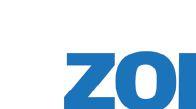


COMPANY: ZOLL Medical Corporation
EXPERTISE: Emergency Response & Supplies/Disaster Recovery
CSP LEVEL: Platinum
CSP SINCE: 2023
WEBSITE: zoll.com
How is ZOLL responding to the ever-changing needs of the FM world?
Expect the best. Prepare for the worst. It’s a smart way to live our lives. Because when you’re ready for anything, you don’t need to constantly worry about what might come your way.
Whether it’s a cardiac event or any number of trauma incidents, ZOLL has a turn-key solution to keep your environment safe and compliant. Backed with program management that limits your maintenance responsibilities, you can have peace of mind knowing that you are both ready and protected.
What research or product innovations is ZOLL working on that will help FMs be more successful in their roles?
The evidence is indisputable: high-quality CPR is the primary component in influencing survival from cardiac arrest. Not everyone experiencing sudden cardiac arrest (SCA) will need a defibrillating shock, but every patient will need CPR.
ZOLL introduced Real CPR Help® technology in 2002, and it’s standard on every AED (automated external defibrillator) and professional defibrillator ZOLL sells.
Even for seasoned health care professionals, it’s hard to know if you are pushing hard enough and fast enough to meet current guidelines for compression rate and depth. With Real CPR Help technology, you know. It provides audio and visual feedback that guides rescuers to deliver high-quality CPR.
Tell us ZOLL’s “why” in the FM world.
When it comes to keeping managed environments safe and compliant, nobody can do it alone. Consider:
• More than 100,000 cardiac arrests happen outside the home, and less than half get the immediate help they need before emergency responders arrive.
• In the U.S., injury accounts for over 150,000 deaths per year.
ZOLL offers comprehensive solutions that protect and empower employees, combined with the expertise to help ensure efficient safety processes and costs. Investing in these critical resources is a proactive stop toward safeguarding your most valuable asset — people.
ZOLL is committed to advancing resuscitation practices and doesn't stop at technology alone. The company has consistently demonstrated a dedication to education and training, ensuring that facility managers and their teams are well-equipped to respond effectively to emergencies. By choosing ZOLL, facility managers align themselves with a partner that prioritizes not only the quality of their products but also the competence and preparedness of those entrusted with using them.
ZOLL stands out as the optimal choice for facility managers seeking the best AED solution. The integration of Real CPR Help technology into every device, coupled with a commitment to education and training, positions ZOLL as the industry leader dedicated to saving lives through cutting-edge, user-friendly and life-saving technology.
COMPANY: IBM
EXPERTISE: Integrated Workplace Management Systems (IWMS)
CSP LEVEL: Gold
CSP SINCE: 2019
WEBSITE: ibm.com/products/tririga
Tell us IBM’s “why” in the FM world?
Companies are facing a new set of challenges recovering from the COVID-19 pandemic workplace disruption. Not only is the global economy still digesting the financial impact of factory closures, supply chain disruptions and economic incentive programs, companies are dealing with the unprecedented change in the workplace dynamic. For the foreseeable future hybrid work is here to stay. In response, companies are managing underutilized and unutilized office space –which introduces lease management and capital planning challenges, operations and maintenance challenges and space planning challenges. In this environment companies must reevaluate their real estate and facility management processes/solution. Their real estate/facilities management challenges are interconnected and really rely on the same data foundation for optimizing their processes and decision making — they can no longer rely on manual processes or siloed solutions to successfully manage their properties. Companies must adopt an integrated management environment which rationalizes an end-to-end solution for the property lifecycle -from acquisition through disposal. The lifecycle solution should help address processes like property acquisition, space build-out, lease management, space planning/management, operations and maintenance, sustainability and the final property disposal. A life cycle solution can create and leverage a single-source of truth (information) across all the processes ensuring decision making is timely, optimized and clearly reported.
The IBM TRIRIGA Application Suite is a leading integrated workplace management solution (IWMS), which offers an end-to-end life cycle solution for managing real estate and facilities. One value of an integrated solution is that you do not need to worry about managing connections for the basics of property management; this saves time, money and resources, while also being fundamentally more reliable. This means TRIRIGA offers comprehensive functionality to manage your properties from acquisition through disposal without locking you into a pre-defined process. TRIRIGA can be customized for any unique characteristics of your business as well as offer extensions to interconnect with your IT ecosystem and third-party applications. The ability of TRIRIGA to manage complex asset portfolios has been timetested by Fortune 500 companies, while at the same time TRIRIGA’s ability to start small and grow as needed is what sets it apart. Many companies can justify TRIRIGA adoption based on its ability to help them resolve a single major real estate/facility management challenge.
Once in place they realize they can easily expand its usage across other areas of their property life cycle management, eventually leveraging the wealth of the TRIRIGA solution to establish a complete end-to-end solution. TRIRIGA’s ability to establish that single source of property management information is the cornerstone of the power of an integrated workplace solution. The TRIRIGA Application Suite is so adaptable that IBM Global Real Estate selected it as their real estate and FM solution for IBM’s global properties after a comprehensive market evaluation.
Why should FMs choose IBM as a partner?
We believe that the TRIRIGA Application Suite is uniquely positioned to help companies manage the entire life cycle of their real estate and facilities portfolio in an optimal fashion. As an integrated IWMS TRIRIGA offers companies one solution that can manage from the acquisition of the real estate asset through its life to its eventual disposal. The integrated life cycle management architecture enables each of the facility management processes to share the same trusted information — reinforcing the data’s validity as well as building a comprehensive and invaluable repository of facility information. This shared information not only eliminates redundant work but compounds the TRIRIGA value proposition.
Albeit some businesses are hesitant to embrace integrated solutions for fear of lock-in, not being able to select individual best-of-breed point solutions, or for budget limitations — an integrated facilities management still provides the best bang-for-the-buck. TRIRIGA’s architecture is open and supports industry standard interfaces for data exchange eliminating lock-in. Point solutions are just that — point solutions — that do not readily share and leverage common data, require upfront investment to integrate, require long-term investment to maintain custom interfaces and rarely deliver the promised value because they only address one element of optimizing a facility’s life cycle. And even if budget limitations are real, they more often are used as an excuse for not making the needed investment. IBM is addressing this challenge of budget limits with the introduction of the TRIRIGA Essential bundles. These are targeted point enablements which provide the client a solution for FM challenges at an aggressive price but still based on the TRIRIGA integrated architecture, which allows for the client to enable additional functionality over time so they can stretch out their budget allocation.
IBM’s history and reputation in delivering solutions and working with clients to help them address business issues and opportunities is unchallenged. IBM TRIRIGA is a market leading real estate and facilities management solution. There is a strong ecosystem of business partners to help companies quickly configure, integrate and operationalize TRIRIGA into their business processes.

COMPANY: Tarkett
EXPERTISE: Carpet/Flooring/Textiles/Floor Covering
CSP LEVEL: Silver
CSP SINCE: 2000
WEBSITE: tarkettna.com
Why is indoor air quality (IAQ) so important?
The U.S. EPA estimates that the average person spends 90 percent of their time (roughly 18,000 breaths) indoors, where pollutant levels can often be two-to-five times — occasionally even more than 100 times — higher than typical outdoor levels. The EPA lists indoor air pollution as one of the top five environmental risks to public health.
One of the most prevalent health concerns triggered by indoor air pollutants is asthma, which affects 25 million Americans, according to the Asthma and Allergy Foundation of America (AAFA). Daily limitations from asthma and other respiratory illnesses can be seen across adults and children alike: Poor air quality is estimated to create a combined loss of US$15 billion annually for businesses due to worker inefficiency and sick days, and asthma is the nation’s leading chronic cause of school absenteeism, accounting for 10 million missed school days per year.
What is the connection between indoor air quality and social equity?
While respiratory illness is on the rise, The AAFA’s 2022 Asthma Capitals™ report shows the condition disproportionately affects vulnerable and disadvantaged populations, including low-income, women and people of color. Good IAQ is a critical part of asthma and allergy management, but the people most at risk of chronic respiratory illness may not have knowledge of, or economic access to, mindfully manufactured products that support good IAQ.
Manufacturers have an opportunity to alleviate this equity gap by ensuring products that promote good IAQ are more accessible to everyone. At Tarkett, we’re applying this approach holistically: Instead of creating a few products with low VOC emissions and healthier materials offered at premium price points, we prioritize healthier materials that support good IAQ across our entire portfolio.
What else can we do to support good IAQ?
To reduce exposure to asthma and allergy triggers, source products that are certified Asthma & Allergy Friendly®. This certification was developed by AAFA and Allergy Standards Limited and is earned only by products that pass rigorous testing against strict standards.

To learn more about asthma, allergies and the role of social equity, read our latest white paper on indoor air quality.

COMPANY: Grundfos
EXPERTISE: Energy Optimization
CSP LEVEL: Silver
CSP SINCE: 2023
WEBSITE: grundfos.com/us/support/contact-service
How energy efficient is your building?
Did you know commercial buildings consumed nearly 20 percent of all energy in the U.S. in 2022, and HVAC systems accounted for 39 percent of that energy? Selecting the right HVAC system is an important component in new construction and retrofit projects to keep costs in line and hit energy-efficiency targets. When HVAC systems are designed with energy efficiency in mind, they can use less electricity and produce fewer greenhouse gas emissions.
Many buildings are currently running outdated, energy-sapping technologies, including the pumps. In fact, 85 percent of a pump’s overall lifetime costs are related to its energy consumption.
Energy efficient systems are crucial to keep cost and energy consumption low. Grundfos offers a wide range of intelligent products and solutions to decrease system complexity and operating cost, without sacrificing end-user comfort.
How can Grundfos help with energy saving?
Grundfos aftermarket solutions unlock hidden potential through valuable services and comprehensive solutions. Our solutions offer a wide range of service offerings to keep customers covered for the lifetime of their pumps. We bring peace of mind by minimizing downtime, optimizing performance and providing solutions that help reduce operational expenses, while contributing to a more sustainable world.
About Grundfos:
Grundfos pioneers solutions to the world’s water and climate challenges and improves quality of life for people. As a leading global pump and water solutions company, we promise to respect, protect and advance the flow of water by providing energy and water efficient solutions and systems for a wide range of applications for water utilities, industries and buildings.

IFMA’s Corporate Sustaining Partners (CSPs) are dedicated facility management industry supporters. These best-in-class organizations make a substantial investment in the facility management community as trusted advisers, topic experts and change leaders. They are committed to the success of the professionals they support.
















































































ACOUSTICAL/SOUND MASKING
Biamp Systems | biamp.com
Lencore Acoustics LLC | lencore.com
LogiSon Acoustic Network | logison.com
AED/HEALTH AND SAFETY
Zoll | zoll.com
CARPET/FLOORING/TEXTILES
MasterCorp | mastercorp.com
milliCare Floor & Textile Care | millicare.com
Tarkett | tarkettna.com
CEILINGS/CEILING CARE
Armstrong World Industries | armstrong.com
DISASTER RECOVERY/EMERGENCY RESPONSE
BELFOR USA Group Inc. | belforusa.com
Legend Brands | legendbrands.com
EDUCATION
Capitol Technology University | captechu.edu
ELECTRICAL/WIRE MANAGEMENT
FreeAxez LLC | freeaxez.com
Schneider Electric | schneider-electric.com
ENERGY SOLUTIONS/MANAGEMENT
Schneider Electric | schneider-electric.com
Trane | Trane.com/connected-buildings
FLOORING INSTALLATION/MAINTENANCE
Corporate Care | corporatecare.com
FM CONSULTANTS/SERVICES/PROVIDERS
ABM | www.abm.com
Aerotek | aerotek.com
Alghanim International | falghanim.com
Al-Hajry Overseas Co. LTD. | alhajry-overseas.com.sa
Al Shirawi Facilities Management | alshirawifm.com
Canadian Base Operators | canadianbaseoperators.com
EMCOR Facilities Services | emcorfacilities.com
FEA | feapc.com
FOS CannonDesign | https://www.foscd.com
Grundfos | www.grundfos.com
Leadec | usa.leadec-services.com
Linc Facility Services. Doha. Qatar | abm.com
ODP Business Solutions | odpbusiness.com
OpenWorks | openworksweb.com
Renaissance Services SAOG | renaissanceservices.com
Sodexo | sodexousa.com
SRACO Company | sraco.com.sa
Staples | staplesadvantage.com
The Building People | thebuildingpeople.com

FM HARDWARE
IAdea | iadea.com
FM SOFTWARE
FM:Systems Inc. | fmsystems.com
IBM | ibm.com/us-en
Eptura | eptura.com
Officespace Software| officespacesoftware.com
JLL Technologies | jllt.com
Planon | planonsoftware.com
Velosio| www.velosio.com
FURNITURE
CORT | cort.com
Davies Office Inc. | daviesoffice.com
Versteel | versteel.com
HVAC/INDOOR ENVIRONMENTAL QUALITY SOLUTIONS
Ebtron | ebtron.com
INTEGRATED FACILITIES MANAGEMENT
A to Z Services | asmakh-atoz.com
ESFM | esfm-usa.com
United Facilities Management | ufm.com.kw
JANITORIAL SERVICES/CLEANING PRODUCTS
Excel Dryer | exceldryer.com
R-Zero | rzero.com
Tork, an Essity Brand | torkglobal.com
Vaask | vaask.com
LANDSCAPE/MAINTENANCE/PLANTS/ SERVICES/SUPPLIES
Ambius | ambius.com
RESTROOM PRODUCTS
Kimberly-Clark Professional | kcprofessional.com/en-us
SECURITY
Kastle Systems | kastle.com
Securitas Security Services USA | securitasinc.com
TECHNOLOGY SOFTWARE TOOLS
ARC Facilities | arcfacilities.com
SCLogic | SCLogic.com
WASTE MANAGEMENT
Republic Services | republicservices.com
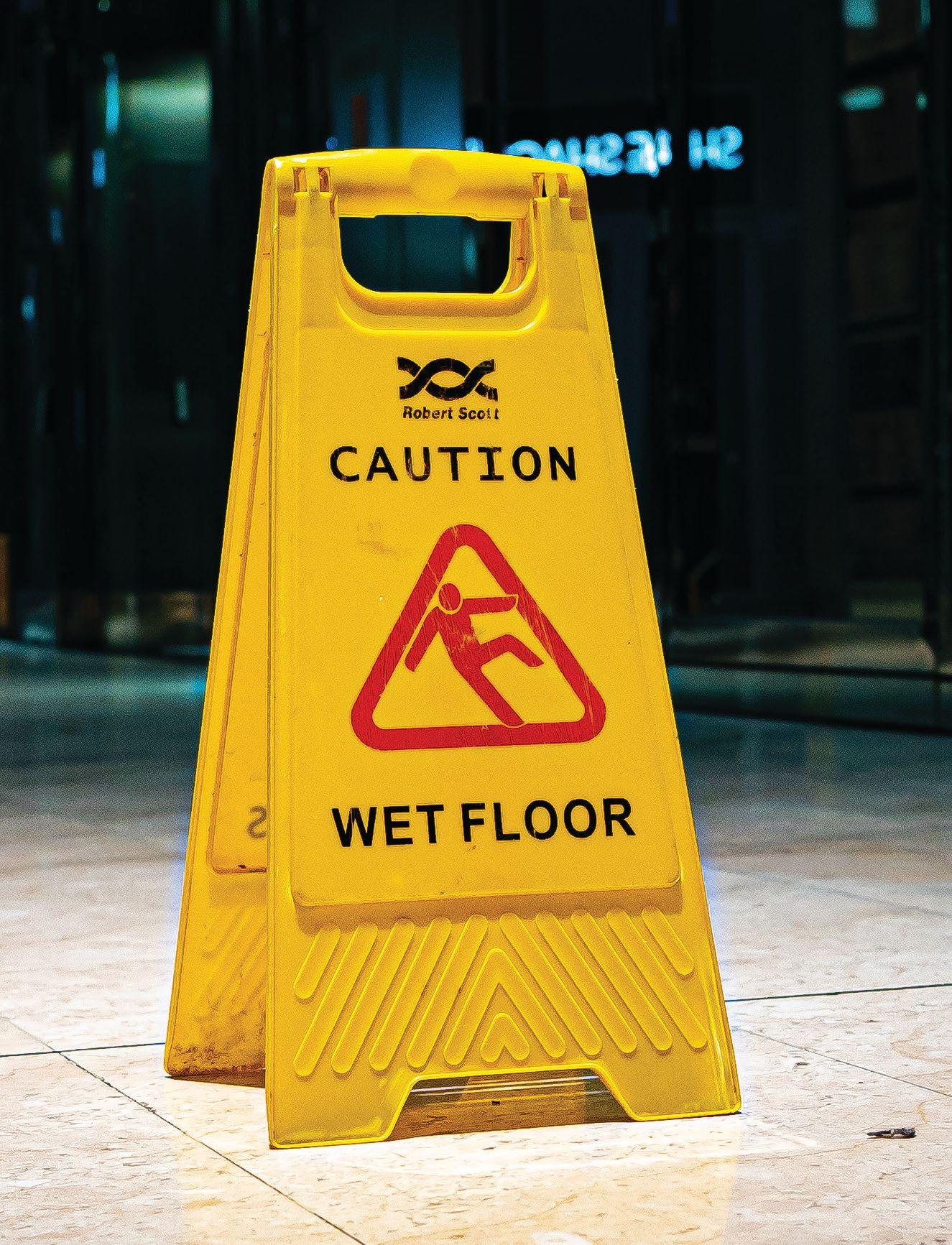
BY ADAM RABESA



Successful facility management teams must be able to handle whatever comes their way. Whether it is overflowing toilets, HVAC systems that suddenly stop working, storms that drop much more snow than predicted, or urgent, last-minute tenant requests, expecting the unexpected is critical.
It is particularly crucial for mitigating risks that lead to injuries — the majority of which come from slips, trips and falls. Their causes are many: the rush to take shortcuts, unattended spills, puddles and objects; overgrown landscapes and more. Often what it boils down to is that people are not paying attention when doing things that have become routine. After all, it is human nature.


Every person has two brain systems: one is fast-thinking and handles automated behavior. The other is slower, more deliberate, and requires more energy. As Daniel Kahneman points out in his book, “Thinking, Fast and Slow,” a law of least effort applies to physical exertion. He says, “If there are several ways of achieving the same goal, people will gravitate to the least demanding course of action. Laziness is built deep into our nature.”
That is not necessarily a bad thing. It is needed to save energy so bodies and brains can focus on higher-level, more complex thinking and activities. However, this process can expose workers to unexpected risks doing things that do not seem dangerous at all, like walking. Even something as seemingly innocuous as a technician taking a call while walking on their building rounds or crossing a sidewalk can be risky when someone trips over something they did not notice.
With all the demands and unknowns that constantly arise in FM — and the pressure to fix problems quickly and keep customers happy — it is not surprising that workers sometimes experience stress.
To help alleviate some of the problems causing their stress, they may resort to taking shortcuts, such as carrying a heavy, large package up the stairs instead of taking an elevator or using a dolly; running down a hallway where, unbeknownst to them, a spill just occurred; or using what they know is the wrong tool because the right one is not on hand. Any of these actions can cause injuries.
When stress happens too often, it floods the body’s nervous system with cortisol and adrenaline that short-circuit important cognitive functions, such as the ability to focus and pay attention to the task at hand or the surrounding environment. This exacerbates FM workers’ challenges and, in turn, causes more stress and puts them more at risk.
Nobody wants to be injured or cause injuries at work. But when people feel like they are under pressure to complete a job or help a customer, they may take calculated — and even uncalculated — risks. It is the FM services team’s job to mitigate that behavior. At a high level, the way to do this is by instilling a safety-first culture. FM services supervisors and managers must understand — and communicate — that doing things safely is more important than doing them fast. Consider starting each meeting, regardless of the topic, with a safety tip or comment. For example, at the end of each shift, have everyone write



down one safe or unsafe act or condition they noticed during their shift. Once a week, share the most valuable observations with the team. Doing so will make the team pay more attention to unsafe/safe acts when in the field and naturally cause them to think safety. The goal is to create routine habits of continuously looking for and avoiding unsafe situations, such as those akin to blowing on hot coffee before drinking it or checking the blind spot before changing lanes while driving.
Back this mindset up with actions. For instance, do not penalize workers if it takes them longer to do a task when doing it faster would have meant cutting corners or putting themselves, or others, at risk. Have managers remind people not to take shortcuts if they are seen doing so, and to take the time to do the task right the first time.
Communicate this to tenants and visitors as well. If a worker sees someone running across a busy parking lot, remind them to use the walking path instead. Or if a tenant is walking up the stairs holding a box that obstructs their view, offer to help transport the package in a safer way so no one falls. While some people may not heed the advice, others will. In any case, doing so helps promote the feeling that the FM pays attention to and cares about the well-being and safety of everyone on their premises — and can prevent costly injuries.

Many times, after people trip or fall, they acknowledge that they were not paying attention to their surroundings because they did not expect something to be in their path or to cause harm.
There is no way to ensure that everyone pays attention and makes the right safety-related decisions all the time. However, there are ways that FM organizations can mitigate the chance of incidents and help teams resist the innate urge to take shortcuts.
While it is impossible to stop people from spilling liquids and dropping things on floors, FM staff can take measures to improve the general safety of their facility’s floors.
First, recognize that builders and interior designers who determine the flooring options are not necessarily experts in which materials are best for which types of environments, or how easy — or difficult — they are to keep free of grime and chemicals that can cause slips.
Janitorial management should be involved in floor selection from the beginning, whether in new construction or renovations. They should know the best cleaning agent for the type of floor material. Keep in mind that there is likely a safer option for the material used. However, aesthetics also plays a role in decisions. It is important to find the right balance.
The coefficient of friction (COF) should be taken into consideration. The amount of friction an object has against the material will be affected by the chemicals used to clean it and the amount of cleaning that takes place. The cleaner it is, the safer it is. Use COF meters on a regular basis to determine the COF of the facility’s various floor surfaces, assess the potential risk of slips and falls, and take corrective action when needed. This could include, for example, changing the flooring or using secure mats that go all the way from a lobby entrance to an elevator. Of course, the quality of mats also matters. Make sure they are clean and are not curling up.
The opportunities for injury when moving heavy loads are numerous. One of the best ways to mitigate this is by limiting the number of times workers need to transport the same package. If they can move it to its final resting point the first time they touch it, they will reduce the chance of damage.
Require anybody who receives packages of a certain size to pick them up at the mailroom or lobby, where they are given a dolly or cart for transport and, if appropriate, directed to use the elevator. Make sure workers know how to use different dollies and moving equipment. Some are better suited for loading docks

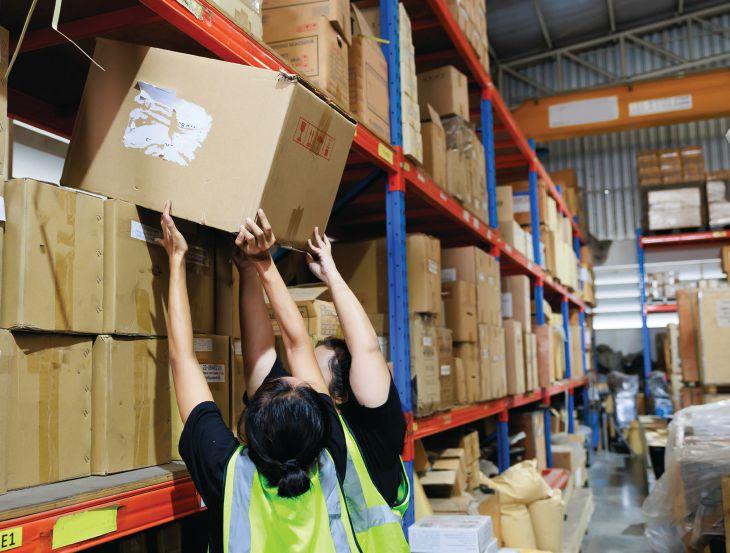


rather than smooth tiles or flooring. Others are better for transporting over stairs instead of long hallways.
People drive slower in inclement weather. Just like cars hydroplaning during rainstorms or on icy roads, so can the heels of people’s shoes on watery sidewalks, parking lots and lobbies.
Use signage to indicate ice alerts, wet areas and places where people should slow down. Where available, encourage people to take advantage of handrails, and keep walkways and parking areas clear of ice and snow. Umbrella bags should be handy and visible at lobby entrances, and high-quality mats placed from entry areas all the way to staircases and elevators.
FM services workers often have a customer-first mindset, with an instinct to address a customer’s concerns right away. However, this can increase the risk of injuries, for instance, if a worker carries on a conversation with a tenant while standing on a ladder fixing a 277-volt light ballast or turning a wrench under a sink.
Safety should come first. Make sure staff understand that it is okay to ask customers to wait a moment so they can complete their task; or at minimum, come down the
ladder or out from under the sink to speak with the customer.
Because tenants and visitors never go to places like staff break rooms, locker rooms, mechanical spaces and back-of-house hallways, these low-visibility areas are often not maintained to the same high levels as front-of-house areas. That makes them more prone to causing injuries due to things like grease that spills on the floor while being carried to a dumpster or trash or equipment left in the middle of a floor.
Janitorial teams must ensure back-ofhouse areas are clean and properly maintained, and that signage is readily available to indicate slippery or dangerous areas.
FM workers get injured because something unanticipated happens – even when it should be expected and could be prevented.

Adam Rabesa is director of environmental health and safety at UG2. After graduating from Massachusetts Maritime Academy, he started his professional career in a role where he made dramatic improvements in lost time injury rate, total recordable injury rate and claims. Prior to UG2, he was a compliance officer championing injury prevention and risk mitigation on board the world’s largest passenger vessel, Oasis of the Seas. Over his career Rabesa has had extensive experience in regulatory compliance and behavior-based safety. At UG2, he leads national risk mitigation efforts for all sectors of business, driving safety culture and oversees regulatory compliance including, but not limited to, DOT, EPCRA, OSHA 1910, OSHA 1926 and NRC.







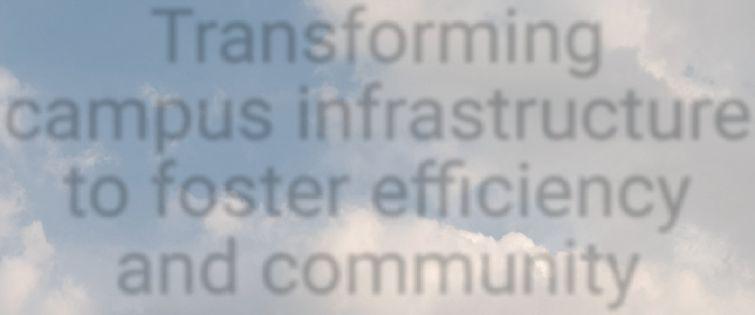

BY BRIAN LEACH & ZACH PRICE CASE







The challenge of integrating a new facility into an existing campus often requires careful consideration and innovative design. For many campuses with a history of expansion over several decades, the result can be a sprawling landscape with a lack of cohesive layout and suboptimal functionality.
In Delaware County, Ohio, USA, these challenges and more became known during a campus renovation project for a water utility co-op. After half a century of incongruous additions to house new departments and additional staff, the public water supplier needed a comprehensive approach to renovations that would provide additional space for departments in need, a centralized hub and meeting space, and the walkability that would promote ease of interdepartmental interactions and enhance workflow efficiencies.


Originally, all the supplier’s service departments were housed in a single office building, but organic growth over many years led to the need for additional office buildings. The flow and ease of functionality were challenged as office buildings stretched onto further areas of the grounds.
As so often is the case with campus expansions, available ground space for the renovation project was limited. The project team had concerns that required renovations and expansions may not be able to be contained to the area of campus that promoted walkability and ease of interdepartmental collaboration.

To further complicate matters, there were several utility-related obstacles on the remaining land parcels that the development team needed to overcome. Overhead and in-ground power lines, gas lines, an improperly abandoned well and limited recordkeeping meant that the project team had to scrutinize existing documentation and partner with its in-house GPS department to thoroughly record and log points of all utilities. The exercise was necessary for obvious safety reasons but also would help create adequate documentation for consideration during future campus and community projects.
The project team was intentional about using a master planning approach instead of adopting a single-building focus and launching into building-specific renovations. The first step in the master planning process involved analyzing the purpose and functionality of each building on the campus. The team raised key questions, such as:
• Are these buildings adequately serving the departments and staff housed within them?

• What is the useful life remaining in each of these structures?
• Which are the most critical updates that need to be prioritized?

The co-op’s project team then collaborated closely with the architecture and design team to gain an in-depth understanding of daily campus activities. Architects and designers shadowed co-op employees to observe workflow, document movement and identify opportunities for operational efficiencies. The project partners agreed that it was crucial for everyone to secure a deep understanding of the campus’ inner workings before they outlined any changes.
“From a design perspective, it was a huge help to our team to shadow the crew,” a member of the architectural firm said. “Because of that, we were able to meticulously document the entire workflow process and better understand the size of the crew and all the equipment we were dealing with.”
As a point of comparison, the architecture and design team also made site visits to nearby fire stations to see how process efficiencies like pull-through vehicle bays and building zones could be incorporated into the renovation project. They borrowed ideas from equipment bays to gear stations to clean-up stations all the way through to the break room area and offices.
The purposeful planning helped the design team eliminate backof-house elements typically hidden from general view. Instead, the team was able to apply the look of a professional office environment in place of a typical industrial design more commonly incorporated to utility service stations.



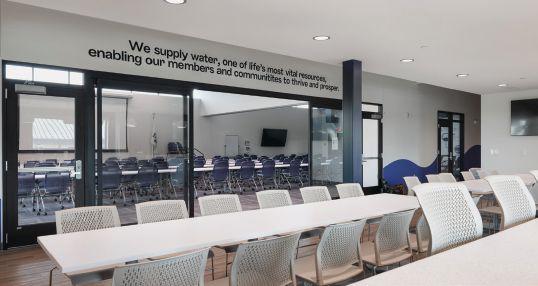

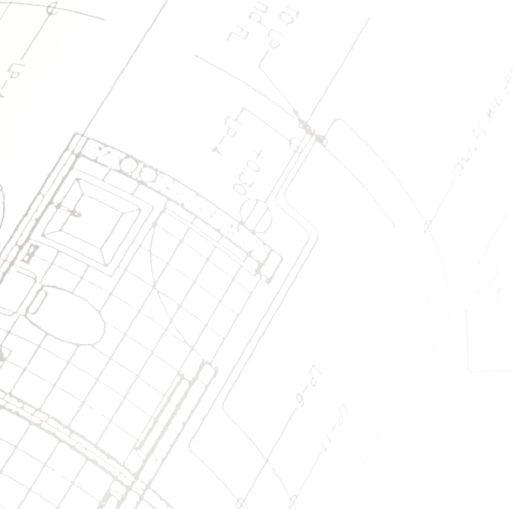
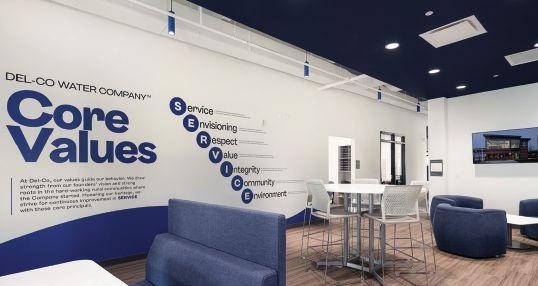
Budgetary constraints are the least unique aspect of any renovation or expansion project, and the cooperative water utility’s project was no exception. Post-COVID-19 residual supply chain issues, including massive price escalation and spotty materials availability, were also among the challenges the teams encountered during their project.
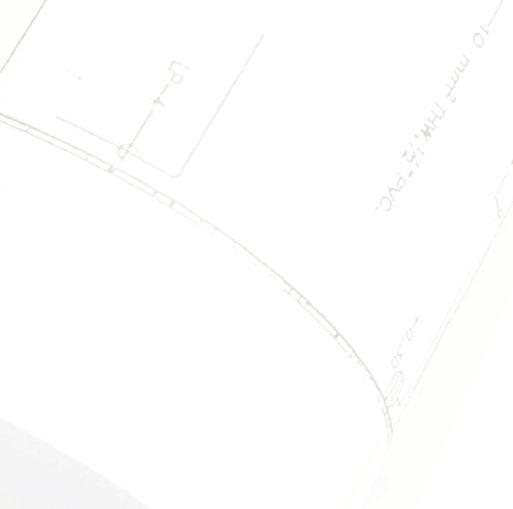

“We didn’t see issues across the board,” a member of the co-op’s team said. “But we were glad to have a partner that suggested affordable alternatives when we did run into issues. As long as you have a partner that isn’t suggesting outrageous substitutions, I’d encourage you to be flexible. Be open to alternatives.”
In any project — especially one on a tight budget — it can be challenging to consider broad scope functionality in lieu of applying tunnel vision to the task at hand. But it can be helpful to consider long-term community connections along with immediate-term needs.
In the case of the Delaware County project, one pleasant surprise came in the form of community demand for a state-of-the-art training facility the teams had designed and installed in the newly renovated building. The space easily satisfied its intended purpose for optimized staff training, but it quickly evolved into a space that city and county officials, as well as community organizations, wished to use.
With the success of the space, the co-op now is considering adding ancillary services, such as event space catering. The team is also offering visitor perks, such as free access to its electric vehicle (EV)
dual charger stations. In anticipating increased demand for the space, the team has incorporated additional community-friendly elements, such as a porous paving system that eventually could be converted to overflow parking space.
The renovation project in Delaware County was driven by a commitment to design a facility that optimized functionality and enhanced efficiency. As part of their project retrospective, both teams agreed that their work accomplished the primary objectives to provide additional space for departments in need, create a centralized hub and meeting space, and preserve the campus walkability that would promote ease of interdepartmental interactions and enhance workflow efficiencies.
Along the way, the team also created small, budget-friendly wins that exceeded their goals. Among those were elements such as:
■ an increased use of natural light

■ the addition of solar panels to garage roofs
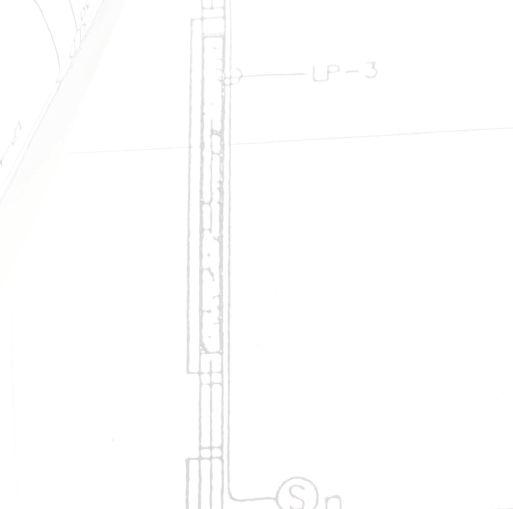
■ placement of EV charging stations that enabled the addition of electric vehicles to the water supplier’s fleet
■ erection of a carport to provide additional covered parking for vehicles
“The initial analysis and assessment, when we embedded ourselves to better understand campus activity and workflow, was key to our ability to present ideas that exceeded expectations without exceeding budget,” said a representative of the architectural firm.
“We were able to plan for small wins that created big differences in both functionality and community appeal.”






The project is a remarkable example of how comprehensive planning and innovative design can help transform an aging campus into a focal point of community service and pride. Project leaders have these suggestions for others seeking inspiration for similar projects in which design for functionality and efficiency meets community service:
■ Seek inspiration from industries, workflows and designs that parallel the project, being purposeful to consider the size of the crew, equipment and vehicles involved.
■ Explore the potential to divide a building into work zones, such as vehicle bays, storage areas, post-work clean-up stations, restocking areas, locker rooms, break rooms and offices.
■ Consider additional amenities that could add immediate benefit for both building occupants and community stakeholders, as well as those that could support longerterm growth.
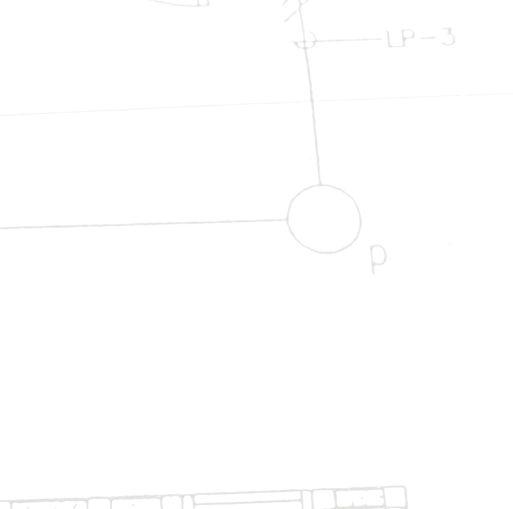
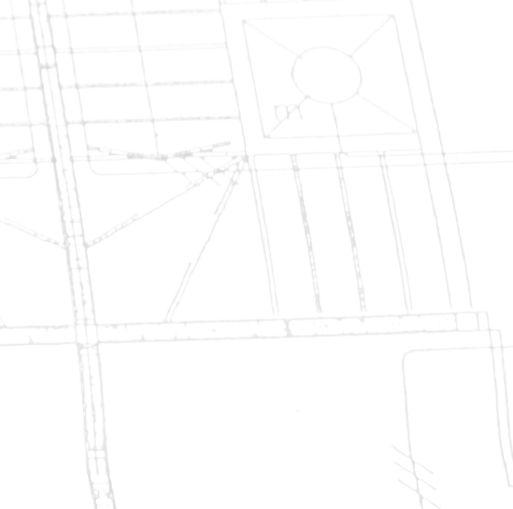
■ Evaluate options for project elements that may provide unexpected support for increased functionality or efficiencies while also adding a unique and aesthetic element to the campus.
■ Explore opportunities to incorporate space for ancillary services, such as catering.
■ Consider project add-ons that may become revenue generators, such as rental fees for meeting space.

■ When designing a space for employees and guests, thoughtfully design points of building ingress and egress to ensure the uninterrupted flow of operations.
■ When possible, prioritize sustainability without sacrificing the project’s primary goals.
■ Be open to flexible, cost-effective alternatives if supply chain issues impact project plans or timelines.
■ Meticulously record and map points of utility placements for ease of future development projects. FMJ
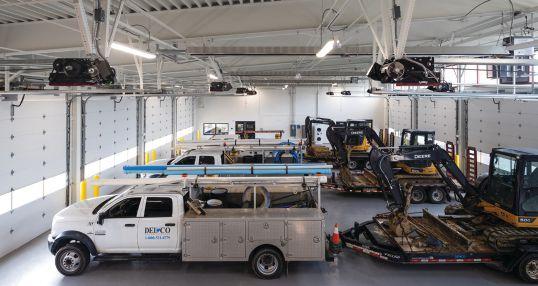



Brian Leach, FMP is the facility manager for the Del-Co Water Co., where he has worked for more than 20 years. Some of his main responsibilities are buildings, grounds and fleet management. He holds a bachelor’s degree from Ohio Wesleyan University and Water Distribution II with the Ohio EPA. Leach enjoys being responsible for maintaining Del-Co’s many assets and keeping their campuses looking great.

Zach Price is a partner at Triad Architects, where he led the design team for the Wolfe Water Center project. Price has more than two decades of architecture and design experience.








2024 IFMA Foundation
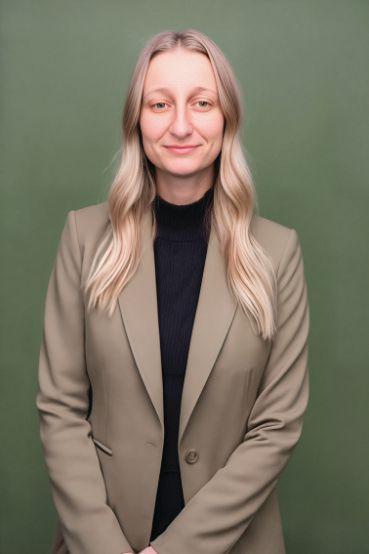


















Eric Teicholz Sustainability Facility Professional® (SFP) Scholarship
Available January 12th!
IFMA’s SFP is an assessment-based certificate program delivering a specialty credential in sustainability. By earning the SFP credential, you will:
Earn recognition and credibility for your expertise in sustainable FM practices.
Influence your organization’s economic, environmental and social bottom lines.
Maximize efficiencies and streamline operations to boost your triple bottom line: people, planet and profit.
Learn to use knowledge-based, data-driven methods to drive decisions and develop valuable solutions.



Young professionals currently in facility management or a related field with a demonstrated financial need are eligible to apply for this scholarship.


























IFMA Foundation Scholarships Available Friday, January 5, 2024





Learn more about eligibility criteria and application process.




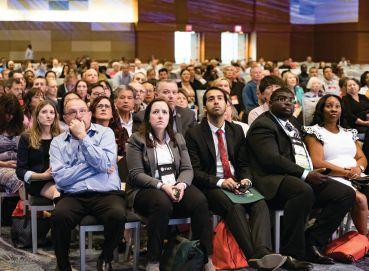














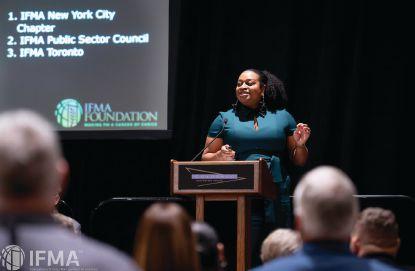
BY EVAN BENWAY

At the beginning of human history, the built environment looked quite different from how it does now. It consisted of caves, huts and temporary dwellings before more permanent structures began to be formed from materials like clay, mudbricks and stone.
As Stephen Kellert, a renowned professor of social ecology, points out, humans evolved in “a sensory world dominated by critical environmental features such as light, sound, wind, weather, water, vegetation, animals and landscapes.” The move to predominantly urban environments is a historically recent phenomenon.
In the midst of all the change sweeping workplace and commercial real estate, it is particularly useful to think back to the natural environments humans occupied for most of history. Doing so is a reminder of some basic needs — the foundations of healthy and comfortable buildings — which have been neglected.
The sense of hearing is exceptional, both in its power and the degree to which buildings have frustrated it. Hearing is the body’s early warning system. Ears are always on, even during sleep. They give living beings extraordinarily detailed information about their surroundings, in all directions. And of all the senses, hearing is the one that affects people the fastest.
It is no surprise, then, that complaints about noise are top of the list in modern workplaces. Some spaces are stressful and distracting; others lack privacy. Some are too quiet, while others are too loud. After years of solitude working from home, these problems have only intensified as people return to the office.

Leesman’s research found that dealing with issues relating to noise is the environmental change that could make the greatest positive difference to employees’ experiences in the physical workplace.
Soundscaping is the act of bringing designed sound into an indoor environment to support people. While often designed to be subtle and ambient, it is nonetheless a profound change from how sound in workplaces has previously been considered. Historically, the focus in workplaces has been on one sonic metric: loudness. There has been a concerted effort to reduce noise levels, but this can cause more problems than it solves. Not all sound is bad. Soundscaping can create a powerful link between

people and the natural world, fulfilling many basic human requirements for health, comfort and connection.
People need to feel safe to be comfortable and engaged in the office. But many workplaces fall at this first hurdle.
Sound can be an indicator of whether a space is clean, nourishing and free from predators. For this reason, a babbling brook, leaves rustling in the breeze and gentle birdsong are tell-tale sounds of safety and refreshment. People instinctively relax when they hear these sounds. Now think about the noises people typically encounter indoors: machinery,






notifications, construction. Humans are hard-wired to react negatively to these sudden, jarring sounds. Even if they consciously know they are not in immediate danger, these “mini-threats” subconsciously cause stress, distraction and trigger the body’s fight-or-flight response. It may be surprising to learn of another stressful sound: silence. Think back to human evolutionary experiences in nature when the cessation of birdsong signaled an impending threat. In today’s workplaces that are so quiet staff can often hear a pin drop, the absence of sound becomes its own kind of disturbance. Silence is unnerving. With lower occupancy levels, it is a growing issue in workplaces.
Silence is very different from quiet. Quiet — taken here to mean the absence of human-generated noise — can restore; enable deep focus; give space to think, wonder and create. The forest might be quiet, but not silent. The bluffs near the ocean with the inhalations and exhalations
of distant waves are quiet, but not silent. People still positively respond to the sounds of nature, even when they are introduced into the built environment. Introducing these “safe” natural sounds indoors through soundscaping can reduce physical symptoms of stress, reduce psychological anxiety, and encourage positive emotions of safety and comfort.
Social connection is a double-edged sword when it comes to sound in workplaces. Humans are inherently social beings and find speech almost impossible to ignore. Despite humans’ need for social connection, overheard conversations are the most complained about sound in offices. When people are distracted by someone else’s chatter, they do not have enough mental bandwidth left to focus on their own thoughts and work. This innate response to sound causes


frustration and degrades productivity.
Workplace sound also affects the quantity and quality of social connections. Not only does silence unnerve people; it also hinders collaboration. People hold back on talking to one another to avoid disturbing their neighbors or being overheard.
Workplace designers are then faced with the unenviable task of creating environments with enough background sound that people feel comfortable collaborating, while also minimizing speech distractions for people who are trying focus.
Natural soundscaping can be an antidote to both problems. The sounds of water — like a fl owing river — can be engineered to mask speech very eff ectively. The addition of this soundscaping into a workplace reduces the intelligibility of overheard conversations, making them far less distracting. And in turn, these natural soundscapes ensure that spaces are never eerily silent and allow people to feel comfortable talking to one another. Natural sounds can even bring a sense of life to empty offices. Researchers found that hearing birdsong in empty spaces creates a sense of social presence. They believe it is because birdsong has many complex characteristics, just like human speech, and therefore signifies intelligent life and helps people feel less alone.
People have an innate need to establish ownership over spaces. Evolutionary, this gave a sense of security. Thus, feeling “at






home” and being connected to surroundings is important for human health.
Someone’s relationship with a place can take many forms. The connection might be an emotional one — people are familiar with their sensory surroundings and are emotionally invested in them. Or they could think about the relationship from a physiological perspective — people’s bodily rhythms are in sync with the cadences of the natural world.
Circadian rhythms (internal biological clocks) help humans function normally and healthily, alerting, among other things, when it is time to wake up and move or slow down and relax. Most people know that light can regulate these rhythms, but sound plays an important role, too. Natural sounds that are characteristic of different times of day, like an early morning dawn chorus, can trigger circadian rhythms. Natural soundscaping that changes over the course of a day can therefore create a physiological connection to place in the built environment, and pairs well with circadian lighting systems.
Consider too, how distinctive regional natural sounds can link a building to its geographic surroundings or amplify interior design concepts. Nature is more restorative when senses are aligned.
People need a sense of control over their environment. Researchers argue it is essential for well-being, from both a psychologi-

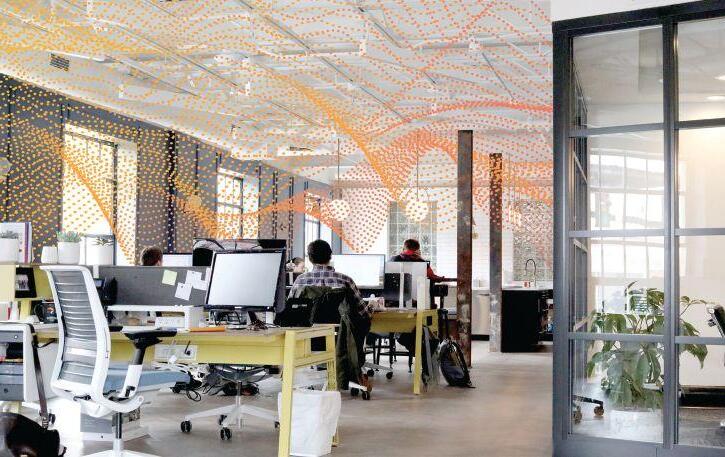
cal and a biological perspective. Historically, being able to make choices about the places people inhabited contributed to a healthy sense of personal autonomy and allowed us to adapt and solve problems.
Giving people control over their environment in workplaces increases satisfaction. Sound is no different — there is no one size fits all. Natural sounds are far less subjective than music and are beneficial for most people. But there is no one sound or soundscape that will benefit everyone equally all the time. In the workplace, people perform different tasks, and they have different personalities, preferences and ways and working. And consider the diversity of sensory sensitivity: neurodivergent employees respond differently to noise compared to neurotypical people — typically they are hypersensitive to disturbances.
Sometimes it is possible to offer people direct control of the soundscape, for instance in smaller spaces, like meeting rooms or wellness rooms. In these spaces, people can use soundscaping technology to directly select the content that is right for them.
In larger shared spaces, implement a process of sensory zoning. A workplace should not sound the same across the building. There can be sonic options based on different work functions or to provide distinct levels of auditory stimulation. In one area the soundscape might be lively
and dynamic, while in another it is calming and quiet. It is important to communicate with employees about the sensory options available to them. This approach of sensory zoning will help people understand their environment and choose areas that will best support them.
The sound of offices should be characterized by far more than a decibel level. By learning from nature and harmonizing the soundscape to human biology, workplace designers can create environments that cater to people’s fundamental needs from a sensory perspective. Nature-inspired, science-backed sound can create offices that are healthier, more engaging and better places to work. FMJ

Evan Benway is an advisor to the International Well Building Institute, where he contributes to the development of the WELL Building Standard’s Sound concept. A passionate advocate for advancing the field of soundscape design, Benway is also founder and managing director of Moodsonic, a science and technology company specializing in generative soundscaping.
Charlotte Pipe and Foundry | charlottepipe.com | linkedin.com/company/charlotte-pipe-and-foundry/
Supply | paintsupply.com | linkedin.com/company/paint-supply/
LLC | skudousa.com | linkedin.com/company/skudo-usa-inc-
Vaask | vaask.com | linkedin.com/company/vaask/
Let IFMA connect you with decision-makers and unlock new opportunities for your business.

Check out IFMA’s 2024 Media Kit at bit.ly/IFMA2024_MediaKit for more information.


expoadv@ifma.org

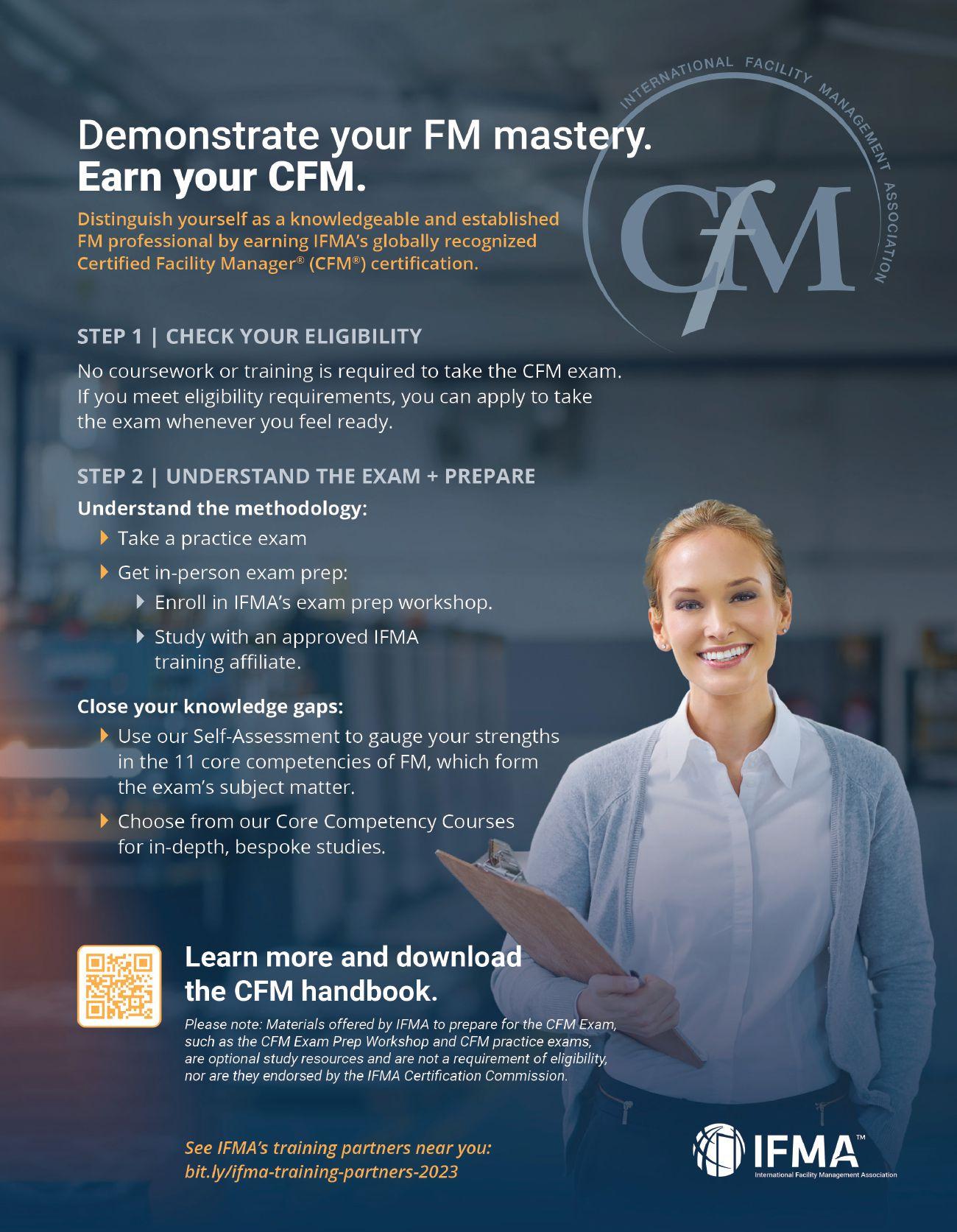

Ask the Experts
Young Professional Profiles
Book Excerpt
Leadership in Managing Facilities: A one-year journey
Richard Payant
Bridging the Gap
OT & IT’s impact on FM
Mike Murdy
A Critical Challenge
Developing the next-gen FM workforce
James Mylett
Evolving With Excellence
Comprehensive updates in IFMA’s benchmarks & targeted training
Nickalos Rocha & Jake Smithwick
Facing Hail Damage
The need for resilient roofing
Chuck Miccolis & Chris Sanders
Vendor Profiles
In each issue of FMJ, IFMA’s Facility Management Consultants Council shares some commonly asked FM-related questions accompanied by advice from top FM consultants. The questions and answers presented in this section align with IFMA’s core competencies following the themes outlined for the given edition of the magazine. While the following answers are intended to be helpful, these responses should not be deemed complete and are limited in context by the space allocated. Please contact the individual consultants directly for further explanation of the opinions expressed.

The Facility Management Consultants Council (FMCC) represents more than 300 FM consultants from various countries around the globe. Its mission states, “The FMCC is the resource and voice for facility management consultants worldwide to leverage our collective expertise to benefit IFMA members, and the facility management profession.”
IAQ — Do you want to make a decision or make a difference?
Air-tight buildings have become a source of contention as facility managers must weigh energy efficiency versus breathable air. Bringing in more outside air equates to conditioning and cleaning more air, which equates to more energy usage.
Then came COVID-19. Now it is not just a matter of cleaner air, but also pathogen-free air. FMs must now consider disinfectant foggers, continuous wiping of surfaces/touchpoints, masks, distancing, UV, HEPA, ionization, ozone, advanced active photocatalytic oxidation (AAPO), activated carbon and even more tools to ensure perceived and actual safety. Vendors came out of the woodwork with technologies and methodologies. FMs suddenly were thrown to the wolves. They must find a way to make it all happen without breaking the bank.
Indoor air quality (IAQ) is still a hot topic, raising several big questions:
• What is the best technology to accomplish my needs?
• How do I determine the placement/quantity?
• How will it affect my carbon footprint?
• How will it affect my preventive maintenance scheduling?
• What will the maintenance costs be?
• Do I want installed equipment or portable?
• Can filters alone eliminate pathogens?
• Do I want active or passive devices?
• Do I want to kill or trap the pathogen?
Active vs. passive
Passive systems only filter what is pulled in by the fan. HEPA, bipolar ionization, activated carbon and ozone generators are passive. Active systems seek pathogens and kill or make them inert wherever they are in the air or on surfaces. UVC and AAPO are both active.
One question at a time:
First though we decide what is the problem with the air? Is it odor? Particulate? Pathogenic? Multiple issues? Determining this answer will determine the type(s) of technology to choose.
Once this is determined, FMs can look at potential hazards, ongoing cost and what each solution affects (air-only or air and surfaces). The chart below provides an overview of each type of device and its characteristics.
Hazards:
UVC-254 is unsafe in occupied rooms because the light waves used to kill pathogens also kill human RNA/DNA. This is a great solution for flash disinfecting spaces with high infection rates such as operating rooms, clinics, classrooms and conference rooms when they are emptied.
According to the U.S. EPA, the article “How Does an Air Ionizer Work?” in Healthline as reviewed by Alana Biggers, MD, MPH, bipolar ionization can put unsafe levels of ozone in the air causing shortterm throat irritation, chest pain, coughing, shortness of breath and difficulty breathing. Long-term effects could be reduced lung function, worsening asthma, higher risk of respiratory infections and lung inflammation. Independent studies have also shown that bipolar ionizers do not reduce the pathogens at the rates claimed, which has resulted in multiple lawsuits for falsifying claims of efficacy.
As for ozone generators, CARB (California Air Resources Board) says: “Some devices that are advertised as air purifiers purposely emit large amounts of ozone, the main component of smog. CARB recommends that ozone generators not be used, except for approved industrial purposes where harmful exposure to ozone is prevented.

Not only are ozone generators ineffective at cleaning indoor air, but inhaling ozone poses serious health risks for humans and animals.”
Ongoing costs
All devices, except for some AAPO devices, have parts such bulbs and filters to replace. The cost of parts must be included with the cost of labor to get the overall cost of IAQ maintenance. FMs must also consider the ongoing cost of electricity. Motors and fans cost money and have wear and tear. Bulbs and AAPO have no moving parts, so will use less electricity.
What each device affects
UVC and AAPO both disinfect air and surfaces; all other types clean only the air. Some, the air that passes through its filter; others, ozone generators and bipolar ionization, the air reached by the ozone.
Additional thought-provoking tidbits
UVC in ductwork would require a minimum of 20 feet of UV light to have enough exposure to kill pathogens at the speed the air is traveling. To avoid turbulence in the duct, that 20 feet of duct would have to be acrylic with the bulbs on the outside. Any pathogens in the duct and its lining would not be affected. Therefore, this would only be cleaning the outside air and any recirculating air.
With UVC light bathing the room, pathogens are being killed as they are exhaled into the air and on surfaces.
HEPA/MERV 13+ will trap the pathogen, but there are three things to consider:
1. Not all HVAC systems can function with MERV 13+ filters, so this might not even be an option.
2. The tighter the filter medium the more frequently it will need to be changed due to more particulate being trapped faster.
3. Pathogens could be trapped only and released back into the air upon filter removal due to shaking and movement. This does require that the pathogen be pulled into the filter by a fan.
HVAC systems will exchange the air in a building 6-12 times per hour depending on design. A typical fan type device (activated carbon, HEPA) will clean, depending on the fan speed, a median of 1,000 cubic feet in an hour. If HVAC is replacing the air up to 12 times in an hour, how will a fan-type device ever clean all the air in the room?
Activated carbon can kill pathogens, but the points regarding HEPA/MERV13+ apply.
AAPO will actively kill pathogens in the air and on surfaces, not just those pulled into a filter. Some AAPO devices that have added a fan and filtration in the portable units.
There are dozens of independent studies showing the efficacy of AAPO as a first-installed device, demonstrating it is more effective than other devices. These studies were done in buildings with one type of device installed, samples of air and surfaces taken for a virus count; then AAPO installed, run, and samples taken of the same surface and air locations. The results showed more than a 60 percent reduction in pathogen saturation.
Many electronic air cleaning technologies are not evaluated by federal agencies or industry standard organizations for their efficacy or for potential unintended consequences, including the generation of hazardous chemical byproducts.
Even fewer technologies have independent studies, and most only have what the manufacturer has determined.
Only one technology has dozens of independent studies regarding efficacy, and comparisons in live buildings of active technologies.
Crucial to maximizing the efficiency of any in-room air cleaner (passive) is its strategic placement and setup within a room, which should be done in consultation with ventilation engineers, infection control experts and/or industrial hygienists. A poorly positioned air cleaner may disrupt air-flow patterns within the room and through the air cleaner, thereby compromising its air cleaning efficiency.
All this considered, it is important to remember:
• One size fits all does not apply to IAQ. The needs and objectives of each organization and space within each building can require different solutions.
• Do you want to make a decision, or make a difference?
Do your due diligence to make a difference. FMJ

Brent Ward has been in facility management since 2007, serving in the education, banking and medical laboratory sectors. Ward is a board member of IFMA’s Oregon/ Southwest Washington Chapter of IFMA where he is the treasurer and chair of the Emerging Professionals and Career Development committees. He was previously vice president of IFMA’s Nonprofit Facilities Council.

The Netherlands
How did you get into facility management?
I knew I wanted a job where I would be able to organize, manage and take care of people. I wanted the ability to do this in different industries. I’ve had this service-oriented and wide-ranged character from a young age. I was always the one who organized every activity for family or friends. After visiting open days at various universities, I discovered that FM was a perfect fit.
What was your first exposure to this industry?
Initially I wanted to answer that I was first exposed to the industry during my facility management studies, but if I look at it closely, this was much earlier. When I was younger, I had a part-time job as a host at the largest theme and amusement park of the Netherlands. The guest experience was vital, and I did everything I could to facilitate this as best as possible. I really enjoyed my time there, but I did not realize at the time that it was my very first exposure to the potential of FM.
How did you know it was right for you?
During my studies I found that the various responsibilities, the impact one could make on the workplace, the ability to solve problems and the interaction with people appealed to me most. My passion was confirmed during my first internship at the largest cinema chain in the Netherlands. The impact that FM brought to the customer experience was massive. It felt like I had reached my destination working in this department, and I completely fell in love with the FM industry. It’s also the reason I started a young professional program and MBA program at my job directly after university.
What was your biggest surprise about FM?
I really had no idea that FM is the beating heart of every organization. FM is broad and diverse, but most of all significant because we help optimize the working environment to support larger business goals. The biggest surprise for me was that FM is of so much value to organizations and to the world. That is also what I like most about FM. Without everything we do as FMs, organizations cannot continue to exist. I believe, because of that, everything we do in FM deserves much more attention and appreciation than it often receives.
What skill sets do you have that you did not realize translate well into FM?
I knew FM would involve a wide range of services and functions aimed at creating and maintaining a safe, productive and efficient work environment, but I didn't expect that my people skills and strong communication skills would be so useful. There really is no skill set I do not utilize in this job.
What are your goals in the FM industry?
My main goal is to add many more great experiences to my résumé. Within my work as an FM consultant, I get great opportunities to realize this. I would like to continue to grow as a professional by gaining more work experience at different types of organizations with different types of assignments or positions. I also would like to achieve this by making the world a little bit more sustainable. If we all commit ourselves to this, I’m convinced that we will achieve the U.N. Sustainable Development Goals. I would like to inspire young people and make them enthusiastic about FM. Young professionals are our future and in a job market with huge demand.
What is the most important challenge facing young professionals in FM and what are your solutions?
FM can be quite complex and challenging to fully comprehend if you are still at the beginning of your career. Sometimes, it can be difficult to deal with all this responsibility, especially especially working for large organizations. For young professionals, these challenges can be overwhelming. They often ask too much of themselves and do not always know when to ask for help. We must gain as much practical experience as possible and give ourselves some space to make mistakes and learn from them. Be vulnerable and curious.
In what ways do you believe young professionals can influence today’s FM industry?
Today's young professionals can have a lot of good and positive influences on the FM industry. We grew up in a world where more and more technological innovations are being utilized. Young people are more adept with these technologies and can introduce these in their working environments. We have an increasingly growing awareness of sustainability and the need to take care of our planet. Young professionals have fresh, innovative ideas and a different view of the work field. This allows us to shape the future of the FM industry to ensure that it remains flexible, sustainable and focused on the needs of a changing world.
What would you tell someone looking for a career or to change careers to convince them to try FM?
FM is one of the most multidimensional, impactful and promising work fields. You can learn a lot from the diversity of tasks and responsibilities, the impact it can have on the working environment, and the opportunity to contribute to sustainable and socially responsible organizations. Every organization needs a good facility manager, so you will always have a valuable and important job. FMJ

EMMANUEL MIREKU OSEI, FMP, MPhil., MSc. Ghana, Africa
How did you get into facility management?
I developed an interest in facilities management, first through hands-on experiences in 2015, when I was tasked by my head of department to liaise with the administration team to ensure that the work premises were kept clean and that all utilities always functioned effectively.
With this ignited passion and a further step to take up the role of a facilities officer, my main objective was to excel in the field and efficiently produce results. As a result, I engaged a retired FM practitioner to discuss my career path and tap into his vast wealth of knowledge in the field.
I further enhanced my skills through extensive reading about the best FM industry practices and how to become effective in my line of work. Subsequently, I prepared for the IFMA FMP to back my excellent working skills with a certificate in 2022 and an IFMA SFP in 2023.
How did you know it was right for you?
I knew FM was right for me when I realized the ease and enthusiasm at which I got my office premises issues resolved by well-coordinating vendors on site and making sure that systems within the facility always functioned well, even though I was then a collateral/records officer in my organization. With this, I realized my natural tendency toward problem solving and strategic thinking, aligned well with solving the challenges inherent in optimizing and maintaining physical spaces. FM is interdisciplinary; therefore, seeing concepts from my academic background in climate change and sustainable development and geographical information science becoming key areas of discussion in FM made me realize the important contribution and impact I could make by taking up FM as my profession.
What was your biggest surprise about FM?
My biggest surprise was that FM is not just about maintenance, but rather an avenue to contribute to the overall productivity and success of an organization while ensuring work premises are always safe and functioning for smooth operations at the very optimal cost.
What are your goals in the FM industry?
• To leverage my knowledge of the use of technology and data analysis principles in facilities operations to drive optimization and efficiency in core building systems and improve on the overall management and sustainability of any facility I manage.
• To become well vested with the efficient allocation of an organization’s resources and consistently develop and implement effective strategies toward cost savings and long-term resilience of businesses.
• Lastly, to become an IFMA Certified Instructor, with the ability to impact knowledge on FM best practices and share my experiences with other professionals seeking to develop their career in FM.
In what ways do you believe young professionals can influence today’s FM industry?
Young professionals can influence today’s FM industry by learning to adopt new trends in technology and sustainability practices as much as they can. Encouraging a mindset of continuous improvement and embracing new approaches to problem solving can lead to more agile and effective facility management practices.
Furthermore, sustainability is increasingly crucial in today's world. Young professionals must take it upon themselves to champion environmentally responsible practices, advocate for green building certifications, energy-efficient technologies and waste reduction initiatives at their workplaces. Hence, by leveraging their unique skills, perspectives and enthusiasm, young professionals can contribute immensely to the industry's evolution and make a positive impact such as cost savings and long-term resilience on the facilities they manage and operate.
What would you tell someone looking for a career or to change careers to convince them to try FM?
FM is an interdisciplinary field that offers a dynamic and fulfilling career path through a combination of strategic thinking, problem solving, and a direct impact on the well-being of organizations and their occupants. Thus, FM provides a career in which your efforts directly contribute to the success of any organization.
Also, the collaborative nature of FM promotes a rich and rewarding work environment. Facilities management makes one versatile in resolving complex and diverse challenges, as FM practitioners get the opportunity to learn from experts from various fields. FMJ
BY RICHARD PAYANT

One Sunday, while he read the local newspaper, Frank Mitchell spotted a job at a university for their director of facilities management. He submitted his application and curriculum vitae. He received a call to come for an interview. After several positive and interesting interviews, Frank enthusiastically agreed to the university job offer.
Frank is a middle-aged administrator. He is confident, organized and attentive to details. He approaches each day with a can-do attitude. He thrives on the daily challenges, excitement and mental stimulation provided by the job and the people with whom he works.
Frank’s first day included introductions to various university department heads. He also briefly met with his managers and supervisors and asked many questions. One comment struck him: “Employees worked 7:30 a.m. to 4 p.m., Monday through Friday.” Later he was sitting at his desk when, at 5:25 p.m., the lights went out. Frank looked out the window and saw nothing but blackness — no lights. This was January when darkness
T
he book “Leadership
A One-year Journey,”
in Managing
Facilities:
published in March 2023, p rovides real-life experiences, challenges and tips on how to be a successful facility manager. This book of 31 short chapters reinforces in story form the more extensive FM books on planning, organizing, staffing and controlling facility management organizations.
came early. He knew this was not good. This was Frank’s introduction to his new job. Remembering employees left at 4 p.m., he called out to George Herman, his deputy, and groped his way to George’s office. He also noted there were no emergency lights in the office! George discovered the utility company had lost a generator at its plant across the river. The utility company was working on getting the backup generator online and expected to have power back within one hour. Frank was impressed with George’s follow-up investigation.
On his way home Frank contemplated the meetings and events of his first day. He decided to develop a plan that would provide him with focus and direction. It would be a roadmap he could follow and adjust to help him navigate the job’s complexities.
His plan would include getting to know many of the 350 employees by name. Essentially, the concept of managing by walking around (MBWA) explains that managers who get out of their offices and walk around meeting and speaking with employees
are more successful; they build trust and credibility. Frank liked the concept. He had success with this in previous jobs.
The next area of importance to Frank was the department’s policies and procedures. A facility management organization needs good management tools, such as policies and operating procedures, to navigate the myriad of issues that surface daily. Policies and procedures should be well-coordinated and provide guidance on how to handle various issues on a consistent basis. Frank knew that policies are guidelines focused primarily on organizational activities that should or should not be performed. Procedures, on the other hand, focus on the process of getting something completed and are more narrative in nature than policies. Incorporated with policies and procedures is safety. One of Frank’s mantras is “Safety is number one.” A safe workplace for employees, staff, faculty, students and visitors is paramount. To achieve a safe building or campus, a good department training program for technicians and managers must be implemented.
Frank believes knowledge and training are important. Equally important is encouraging employees to think through challenges creatively and calmly. He recalled an incident that occurred a few years earlier involving a sprinkler system in a barracks. Soldiers were playing frisbee in the hallway. The frisbee clipped the sprinkler head. The fire alarm alerted the public safety office, who then contacted the night maintenance technician. When the technician arrived and saw the amount of water being discharged, he panicked. He stopped thinking clearly. The technician called Frank at home and explained the situation. Frank instructed the technician to calm down and think about where the shutoff valve would be located. When the technician replied that he didn’t know, and expressed concern about there being so much water, Frank suggested he check the stairwell. Soon after, the technician reported to Frank that he found and shut the valve, but the water was still running. Following Frank’s prompts, the technician indicated he was on the third floor of five. Frank then led the technician to think about what he had just explained and realized there remained two floors of water in the pipe above; therefore, the water would continue until it got to his level.
Developing an overall department strategic plan was critical. But before he could start developing such a plan, he needed to know both the assets and their condition. He wanted to review the physical asset inventory. Frank knew that buildings change; equipment becomes obsolete or breaks down and eventually has to be replaced. He asked Jim Askew (the asset manager) to see the asset register and inventory. Jim responded that, when he took over his current position, there was no register

Understanding how capital projects were initiated, designers selected, construction contracts administered, contract work inspected, and documents archived for future reference is important.
and inventory. He has been trying to develop one himself. Jim’s effort was commendable, but Frank was frustrated, knowing that without a good asset management database, an effective facility strategic plan could not be developed easily. Frank also met with other department heads, including the director of design and engineering, the director of administration and budget, and the director of utilities. Understanding how capital projects were initiated, designers selected, construction contracts administered, contract work inspected, and documents archived for future reference is important. He knew from experience that it took one to three years for a major capital project to be programmed, planned, designed, constructed and commissioned. On larger projects, it could take longer. Having learned that design and engineering held weekly meetings to review projects, Frank decided to attend them. This would provide an opportunity to get to know all 10 project managers and the potential problems with each ongoing project. Those problems could ultimately impact the operations and maintenance of that facility. He also wanted to know the archivist. The archives contained all the past and present building designs,
r ecord drawings (sometimes called as-built drawings), operations and maintenance manuals, warranties and contracts for various projects
As Frank was speaking with several project managers, he overheard a discussion concerning an ongoing construction p roject. The contractor had submitted a request for substitution of a piece of equipment and the project manager was considering approving. Frank couldn’t help himself. He chimed in that substitution should never be allowed unless reasonable payment credit is given by the contractor. His experience was that contractors seldom want to credit the payments when they make substitutions. He told the project managers they may also see a contractor specify that a piece of equipment to be installed is approved equals, which really means cheaper.
Frank obtained a list of new ongoing capital construction projects. He decided to walk through the projects with each project manager. As he had done within his department, he wanted to know the project managers and understand their strengths, weaknesses and challenges. Frank had another thought and told the director of design and engineering that O&M also needed to be involved with developing the final project punch list and signing off on the list. As a project comes to an end, a list is compiled naming deficiencies, items requiring immediate attention and items not conforming to the contract specifications. In both smaller and million-dollar projects, a punch list can have hundreds of items requiring correc-

tion — sometimes thousands in larger projects. These items must be corrected or completed by the contractor before the final payment is made and the project is turned over to operations and maintenance. Facility management is constantly evolving. Rapid advancements in technology have had a sizable impact on how facilities are managed. With older employees retiring, their legacy knowledge must somehow be captured. Younger employees are looking for companies that welcome open-mindedness and allow them to speak their minds. As a result, organizational culture is coming to the forefront because FM leaders have a workforce made up of various generations: baby boomers, Generation X, Millennials and Generation Z. They all think differently. Taking these cultural issues into account, Frank thought about how important it was for all managers and supervisors to understand and appreciate each generation’s work styles and beliefs. Understanding the four generations and how they work together would be critical to job success and quality service. This meant FM employees would need to let go of old ways of performing work. It would mean changing habits. Frank reasserted that training was essential. For change to be effective, there has to be positive, continuous reinforcement and feedback. Every possible communication channel should be used, including newsletters, weekly notes, town hall meetings and a dedicated website. Frank placed Rona, his administrative assistant, in charge of scheduling quarterly town hall meetings, developing the newsletter and ensuring it was distributed to all employees. In addition, there has to be ongoing training
for the managers, supervisors, foremen and employees on how to communicate with each other while respecting their differences
Frank told his managers and supervisors, Life is a journey. The road of life events is not straight. It has many twists and turns. Hopefully, we all learn from mistakes we make and the challenges we face along the way.
“ “
Next Frank addressed hiring practices for new employees. Frank learned managers and foremen interviewed job candidates by themselves and that candidates were often selected based on friendships or family ties as opposed to qualification and suitability for the position. Frank was determined to change that practice.
He stated that going forward he wanted a panel of three to five people, with at least one woman on the panel. George countered, asking why they needed a woman on the interview panel given that they have no technical experience. Frank told George he was incorrect, noting that women frequently attend technical trade schools and were just as qualified as men. Furthermore, he theorized that women frequently look at applicants as to whether their personalities would fit in with the organization culture, values and operational methods. By contrast, men were often more focused on whether the applicant could do the job.
Frank then offered another example from a previous position where they needed to fill a vacancy in the solid waste and recycling section. When a female applied and was interviewed, Frank had first been skeptical, but decided to take the risk and hire her. She would be the only woman in the crew of 20 men. The work was dirty and physically taxing. The men did not care about their appearance; they were unshaven, scruffy, disheveled and used foul language. Once this woman joined the section, the crew cleaned up both themselves and the shop.
Her presence had a major positive impact on the functioning of this section. Frank added that, despite her size, she more than kept up with the work.
Managing the operations and maintenance of facilities is critically important for every organization. Facilities are becoming smarter and more sophisticated, which means facility managers also have to become smarter and better trained. They need to understand the legal, health and safety requirements of operating and maintaining their facilities. Frank told his managers and supervisors, “Life is a journey. The road of life events is not straight. It has many twists and turns. Hopefully, we all learn from mistakes we make and the challenges we face along the way.” FMJ

Dr. Richard Payant spent 22 years as director of facility management at a major university, and 23 years with the U.S. Army Corps of Engineers. He has established and directed public works and operations and maintenance programs. He teaches in the George Mason University Facility Management certificate program.
BY MIKE MURDY



on of operational technology (OT) and information technology (IT) has become indispensable for forward-thinking facility management. Facility managers are entrusted with the seamless functioning of diverse physical assets. Their intrinsic motivation is not just to keep the lights on, but to create environments that are efficient, safe and reliable. The advent of the Industrial Internet of Things (IIoT) offers powerful solutions, ushering in a transformative digital era in facility management. Armed with this blend of IT and OT, FMs can achieve their objectives with unprecedented precision, aligning their personal ambitions with the overarching goals of their organizations.
However, in this interconnected world, a fragmented approach to technology can be a significant hindrance. Organizations that do not have a cohesive technology strategy often find themselves grappling with inefficiencies, redundancies and missed opportunities. For FMs, this is especially pertinent. Given the intertwined nature of OT and IT in their daily operations, the absence of a unified strategy can lead to misaligned objectives and resource wastage. Moreover, as the pace of technological advancement accelerates, facilities that are not strategically aligned risk falling behind, unable to adapt quickly to changing demands or harness new innovations. It is no longer just about having the right tools; it is about ensuring that every technological component, whether IT or OT, fits seamlessly into the larger operational puzzle. By recognizing the imperative for a comprehensive technology strategy, organizations set the stage for proactive, future-proofed FM.
As leaders of an organization's physical infrastructure, FMs occupy a unique vantage point, making them instrumental in crafting a technology strategy that combines both IT and OT. While IT primarily focuses on the digital realm, ensuring data flow, system integrations and cybersecurity, OT zeroes in on the tangible, physical systems, from HVAC controls to production line operations. The distinction between these two realms underscores the importance of a holistic approach. An FM’s expertise can bridge this gap. They can identify where OT can be enhanced by IT solutions, and vice versa, ensuring both digital and physical infrastructures are symbiotic. Their strategic involvement ensures that technology deployments not only bolster operational efficiencies but also align with the organization's broader objectives. In crafting this strategy, an FM’s engagement is critical to merging the digital and physical worlds in a way that's cohesive, efficient and forward-looking.
Historically, IT and OT were treated as independent domains with little overlap. With roots in the industrial sector, businesses in sectors such as manufacturing, energy and transportation allowed OT to evolve to meet the needs of controlling and monitoring physical processes. These businesses often had specific departments to handle OT needs such as instrumentation and controls (I&C) teams or automation/robotics teams with the primary goal to ensure that machinery and infrastructure operated efficiently, safely and reliably. Conversely, the IT domain was developing to meet the emerging needs for data management, processing and communication in an increasingly digitized world.
As the two domains were developing throughout the 1980s and 1990s, commonalities developed due to both technology advancements and responses to business demands to incorporate them. Throughout these developments, IT departments often drove standards and networking/communications requirements to ensure businesses would operate securely, reliably and efficiently. While both domains utilized technology, their primary concerns, design philosophies and operational methodologies were distinct. Over time, as businesses realized the potential for technology-driven efficiency, silos formed around these two domains. This was in part due to the belief that the real-time, mission-critical nature of OT systems demanded isolation from the broader, data-centric network of IT to prevent potential disruptions. Thus, this historical divergence in purpose and design led to the contemporary dichotomy, treating OT and IT as two separate entities, often with limited interaction.
1. Information Technology
IT refers to the use of computers, networks, software and data management to store, retrieve, transmit and manipulate data. In facility management, IT systems often include office networks, data centers and various software applications used for administrative tasks, such as asset tracking, space management and financial reporting.
Examples of IT in FM:
■ Enterprise resource planning (ERP) systems for asset tracking and financial management
■ Building information modeling (BIM) software for design and construction planning
■ Computerized maintenance management systems (CMMS) for work order and maintenance management
2. Operational Technology
OT encompasses hardware and software designed to manage and control industrial operations and processes. In FM, OT systems are responsible for the monitoring, control and automation of equipment and infrastructure, ensuring they function efficiently.
Examples of OT in FM:
■ Supervisory control and data acquisition (SCADA) systems for real-time monitoring and control of physical processes
■ Building automation systems (BAS) for HVAC, lighting, and security management
■ Programmable logic Ccontrollers (PLCs) for process automation in manufacturing facilities
The IIoT is a transformative concept that unifies IT and OT within the framework of connected devices and data-driven decision making. FM leverages IIoT to enhance operational efficiency, reduce downtime and make data-informed decisions.
IT in IIoT:
■ IT systems enable data transmission and storage in the cloud
■ IT platforms provide the infrastructure for data analytics and visualization
■ IT security measures protect sensitive data
OT in IIoT:

■ OT systems connect to sensors, actuators, and machinery for data collection
■ OT devices ensure real-time monitoring and control of physical processes
■ OT automation and controls improve operational efficiency
While IT and OT both play crucial roles in FM and IIoT, they differ significantly in terms of their operational and security considerations.
1. Operational Considerations
IT:
■ Emphasizes data integrity, confidentiality and accessibility
■ Focuses on office-based applications, networks and data centers
■ Typically follows a regular update and patch cycle
■ Can be highly virtualized, allowing for flexibility and scalability
OT:
■ Prioritizes real-time performance, reliability and stability
■ Manages physical systems, including machinery and infrastructure
■ Often requires long-term support for legacy systems
■ Relies on deterministic processes to ensure operational safety
2. Security Considerations
IT:
■ Primarily concerns cybersecurity against data breaches and unauthorized access
■ Utilizes firewalls, encryption and intrusion detection systems
■ Faces a constant threat from external cyberattacks
OT:
■ Focuses on safety and availability to prevent physical harm or equipment damage
■ Implements redundancy and fault-tolerant systems to ensure continuity
■ Typically encounters internal and external threats that can disrupt operations
To maximize the benefits that can be garnered from technology, businesses must develop a holistic technology strategy that enables each technology to succeed at its intended goals. Nuances have developed between the IT and OT domains in recent years. A holistic strategy must consider these nuances between both domains.
The convergence of IT and OT in IIoT is redefining the FM role. IT systems facilitate data processing and analytics, while OT systems manage the physical processes that keep facilities operational. The unique operational and security considerations of IT and OT make it imperative for companies to formulate a holistic technology strategy that addresses data collection, connectivity, data processing, analytics, security, integration, visualization, automation, scalability and corporate governance.
FMs are at the forefront of implementing these strategies, using technology to optimize operational efficiency, reduce downtime and make data-informed decisions. As IT and OT continue to evolve, facility managers must adapt, leveraging the potential of the IIoT to ensure the seamless operation of facilities in the digital age. FMJ
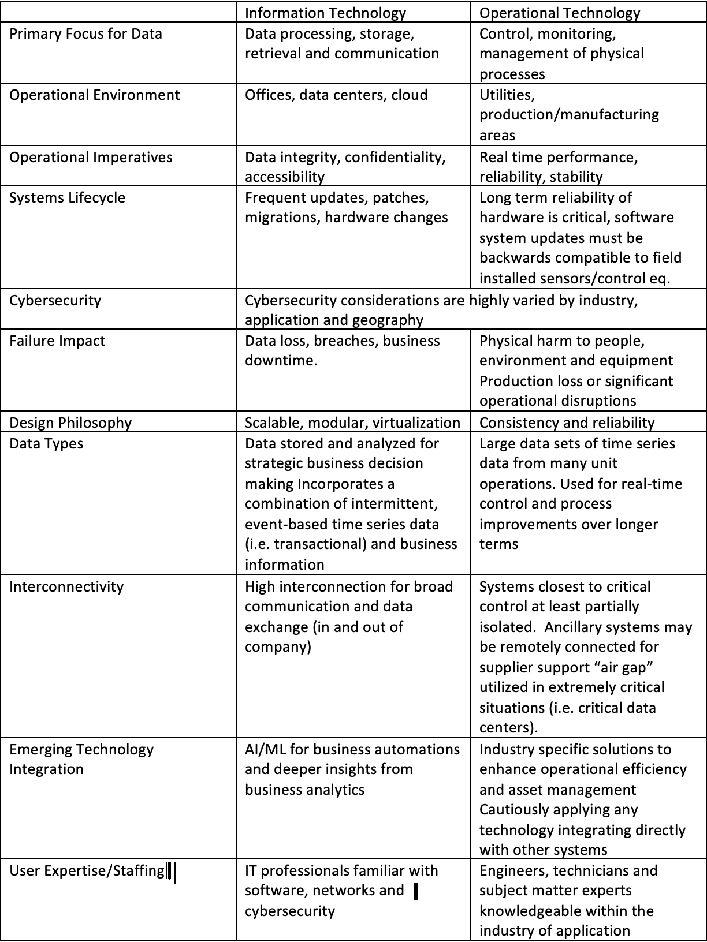

Michael Murdy, CEO of Persistent Controls, has been at the forefront of operational technology, embodying decades of hands-on experience in complex industrial environments. With a rich background in engineering and a keen eye for business, Murdy is an expert at marrying automation, technology and function

into efficient, fully integrated ecosystems that deliver tangible solutions to business leaders across varying sectors. Murdy's career began on the production floors, where he gained invaluable insights into the nuances of industrial operations and the business challenges facing them.


BY JAMES MYLETT
As experienced facility managers retire and take their institutional knowledge with them, the industry faces a skills gap that hinders its ability to keep pace with the changing demands of modern buildings. Without adequately trained facility managers, the comfort, safety and health of building occupants could be at risk. Building owners could also face a growing risk of building performance deterioration and increased deferred maintenance costs. Yet, despite these risks, the FM skills gap remains unresolved in many areas.

This gap has been growing for decades, presenting an increasingly critical supply chain challenge that remains unresolved. Over time, expectations of occupants in how they engage with their spaces have evolved, along with their desires for swift issue resolution and proactive problem prevention. Unless organizations can effectively reconcile these shifting expectations with the shortage of skilled resources, FMs will encounter difficulties in consistently delivering the desired user experience between occupants and the facility. This challenge becomes particularly pronounced due to the rapid advancements in technology and innovation, rendering traditional maintenance and operations strategies outdated while offering advantages to those who embrace change.
So, what is the solution? It lies in a combination of two key approaches: reimagining work to make it more appealing and transforming the approach to workforce development programs. However, it is important to recognize that implementing these approaches is not as simple as discussing them. The first step is understanding that any business, including FM, can undertake this process and follow the roadmap to success, although it may require effort and dedication

In no uncertain terms, staying ahead of the skills gap curve is imperative for companies, and it starts with integrating recruitment strategies right from the outset. New talent needs a clear pathway to enter the skilled workforce. A vital solution lies in forging strategic partnerships with local and regional educational institutions. These partnerships have now become essential in effectively addressing the issue. By focusing on establishing internship programs or apprenticeships for students, companies can empower these aspiring team members to gain a valuable edge through hands-on experience in their chosen fields. Connecting with educational or vocational organizations means that a company can help aspiring workers realize their full career potential through vocational training while also being able to tap into this newly trained workforce.
Adding a generous amount of mentorship from team members to these students significantly enhances their chances of success within the team. Mentors and experienced leaders in the field, well-versed in both older and newer technological advancements, serve as valuable guides for early career workers. By sharing their expertise with colleagues equipped with system training and software proficiency, they strengthen the workforce. This stage facilitates the connection of vital system dynamics, which demand specialized skills for precise maintenance, such as visualizations or power analytics.
Referrals matter and are typically underleveraged. By increasing referral bonuses for frontline technical positions, businesses can reinforce the message that these positions are highly valued and use the networks of their peers to build the business up. The work itself can also be redesigned by investing in readily available analytics software that has in-depth insights. These insights can help early career skilled workers by equipping them with advanced knowledge and troubleshooting direction. By leveraging the technology already here, businesses can bridge the skills gap and create a more supportive environment for newly trained professionals.
Lastly, connecting the work to a greater purpose can help recruit newly trained professionals looking for more than just a paycheck. Fighting climate change matters deeply to Gen Z, and a survey from Deloitte found that 77 percent of Gen Z respondents said it was important to work at organizations whose values aligned with theirs. As buildings account for 40 percent of carbon emissions, highlighting the impact skilled workers can have on reducing carbon emissions can make the work more attractive to prospective candidates.

Many building management systems (BMS) are equipped with centralized interfaces and automated software that make usage of it as simple as possible. However, these systems still require IT talent to maximize their capabilities. The 2021 Energy Outlook Report found that 40 percent of recruiters attribute the ongoing skills shortage in the energy industry to insufficient education and training. To close the skills gap, organizations must take a proactive approach to the training and development of their FMs.
Training programs can help companies upskill the talent they have. Building owners can provide access to online courses and training programs to help FMs stay current on the latest trends and best practices. For example, building owners can support facility managers in obtaining professional certifications by covering the cost of exams and training materials.
Encouraging the attendance of industry events online or in person can also help FMs network and collaborate with peers to share knowledge and insights. FMs can also gain practical experience through on-the-job training programs, such as shadowing more experienced colleagues. Investing in education and training programs can help FMs stay current on the latest trends and best practices, as well as gain practical experience in implementing the newest technology in

A simple yet effective tactic is to automate mundane tasks whenever possible, not only improving the quality of the work but also delivering cost savings for facility executives. An illustrative example is automating data collection and utilizing analytics platforms to generate actionable insights.
From the perspective of skilled workers, this simple step removes monotonous tasks from their daily routines and equips them with the necessary information to proactively address issues before they escalate. For early career skilled workers, leveraging analytics and artificial intelligence serves as a valuable bridge in their quest for knowledge acquisition, enhancing their confidence in fulfilling their work responsibilities.
Taking this a step further, envisioning AI platforms that report on outcome impact metrics, such as carbon reduction, patient satisfaction or student engagement, can provide skilled workers with a deeper understanding of their role in meaningful outcomes. For instance, in the realm of BMS, it becomes even more crucial to help skilled workers grasp that they are not solely optimizing the performance of a chilled water plant; they are actively contributing to carbon emissions reduction and playing a significant part in preserving the planet.
Building owners can also consider taking a collaborative co-sourcing approach to building management. This brings together an outside resource provider to work with existing FMs to supplement any skills or competencies that are not readily available in-house. Co-sourcing can help streamline processes and improve efficiency by leveraging the strengths of both internal and external resources to accomplish projects more effectively.
Joint planning through co-sourcing can help FMs meet their energy and sustainability objectives by having an outside provider help to create a workable strategy to accomplish them. The external providers can help meet resource needs for short-term tactical projects or longer-term strategies for the facility. Co-sourcing can provide access to specialized resources and technologies they may not have in-house, such as cutting-edge energy-efficient systems. Ultimately, modernizing the industry with sustainability technology is essential to closing the skills gap and ensuring FMs have the skills they need to meet future challenges. This includes investing in education and training, adopting new technologies and workflows, and involving outside experts when helpful. By doing so, companies can ensure that their buildings are efficient and sustainable while also prioritizing occupant safety and comfort.

James Mylett leads the U.S. Digital Buildings business for Schneider Electric. A recognized pioneer in field services and the building management space, he is a leader in accelerating the digital service experience for commercial buildings. With a career spanning more than 40 years and having held positions ranging from the frontline to the boardroom, Mylett brings a unique perspective to driving strategic change in the industry. Prior to joining Schneider Electric, he held leadership positions at Comfort Systems USA and Johnson Controls. Mylett earned his MBA at University of Maryland.

bbc.com/worklife/article/20220225-how-climate-change-is-re-shaping-theway-gen-z-works
www2.deloitte.com/us/en/pages/consumer-business/articles/understandinggeneration-z-in-the-workplace.html
usgbc.org/articles/how-green-buildings-can-help-fight-climate-change brunel.net/en/blog/business-growth/energy-skills-shortage

For more than four decades, IFMA has been a recognized global leader in producing operations and maintenance (O&M) benchmarking reports. These reports have guided facility management professionals with insights rooted in industry standards and best practices. IFMA has also provided the industry with benchmarking reports on space planning and FM compensation and benefits. In the past three years, these reports have expanded their geographical scope, encompassing new global regions. They now address key areas of the evolving built environment: the ongoing impact of the COVID-19 pandemic, the growing influence of emerging technologies in FM, and strategies for FM workforce recruitment and retention.
IFMA is updating its 2020 Space Planning Benchmark Report. The updated report will retire certain outdated benchmarks, introduce new ones, and maintain assessments of existing metrics. The update will feature two new sections: an exploration of the future workplace’s landscape and an analysis of sensor integration in workplace settings. Both areas should not be considered deep dives but building blocks to help individuals evaluate, implement and measure investments, improvements and practices in support of smarter, safer, more sustainable and agile spaces.
IFMA's Global Salary and Compensation Report, is evolving to offer more direct and cost-effective benchmarking data dissemination. In 2024, IFMA will launch a compensation and benefits dashboard on its Resource Advantage Platform. Ultimately, the Resource Advantage Platform will comprise a series of tools accessible by members and nonmembers. Instead of an annual detailed compensation report, IFMA will update the Compensation and Benefits dashboard each year with key benchmark snapshots. This reflects one of the most essential changes specific to benchmarking IFMA has made in years: globally streamlining data collection.
roadmap
New strategy
Starting in 2026, IFMA will consolidate the publication of all global O&M benchmark projects into a single year. The development phase is slated to commence in July 2025, focusing on North America, Asia, Africa, the Middle East and Europe. In South and Central America, where the development process is just beginning, an abbreviated O&M project is anticipated to start in 2025. In years when the comprehensive benchmark survey is conducted, IFMA’s primary focus will likely be on enhancing support for O&M initiatives.
Traditionally, IFMA’'s annual O&M studies have been regionally or topically focused, with sectors like healthcare often highlighted. Moving forward, IFMA aims to centralize data collection, adopting a more global approach. In years without a full survey, IFMA will produce an O&M index report, utilizing an inflation-adjustment model to offer a comprehensive analysis of each O&M area. This approach enables FMs to gauge expected percentage increases in various O&M areas. These reports not only furnish
FMs with crucial O&M insights but also ensure responsible management of IFMA resources. For those seeking further O&M insights, IFMA offers additional resources to both members and nonmembers, including the Resource Advantage Platform, tailored analyses and the Power User subscription.
IFMA has broadened its educational scope to include specialized benchmarking classes. Although these classes were not a part of IFMA's traditional offerings, the successful implementation and positive reception of a four-hour intensive benchmarking class at the World Workplace 2023 Conference and Expo have catalyzed the introduction of these classes at future North American IFMA events and potentially at international events. This past class provided attendees with valuable, hands-on experience in effective benchmarking, encompassing data capture, storytelling through data, operational efficiency improvements and developing business case studies.
Expanding beyond benchmarking, IFMA is also exploring the introduction of a new series of AI Bootcamps. The boot camps aim to help facility and construction management professionals learn to harness advanced AI tools to streamline their operations and enhance decision-making. The program will focus on practical applications such as automating routine communication and reporting, improving document drafting like Statements of Work, and offering educational support through interactive AI-driven assistance. It will also delve into efficient knowledge management, task scheduling, incident reporting, stakeholder engagement, process optimization and financial analysis. The classes equip professionals with skills to effectively integrate AI into their daily tasks and strategic planning, significantly enhancing the efficiency and effectiveness of facility and construction management practices.
IFMA is exploring the optimal approach for designing, implementing and evaluating benchmarking classes tailored for various experience levels, from beginner to advanced. Additionally, there is consideration being given to awarding a digital badge after completing different benchmarking classes. IFMA currently includes some benchmarking in the Facility Management Professional™ (FMP®) and Sustainability Facility Professional® (SFP®) programs.
The IFMA Power User tool, integrating Tableau software, enables analysis of the latest O&M database. This tool allows for the analysis of more than 400 O&M benchmarks. A future goal is to allow any region to be analyzed by Tableau software. Demonstrations are available on request, and costs vary between members and nonmembers. IFMA is seeking to incorporate past years’ datasets to be available for analysis.
IFMA’s Resource Advantage Platform
Launched in 2019, the Resource Advantage Platform enables both members and nonmembers to purchase individual sections of O&M benchmarking reports, rather than the entire report. This tool offers users the flexibility to tailor report outputs by adjusting various demographic settings, such as location, size and sector. Additionally, this platform offers inflation-adjusted data, enhancing the relevance and usability of the information.
IFMA members can be involved in benchmarking and research projects by:
a. Applying to participate as a subject matter expert;
b. Completing surveys;
c. Sponsoring webinars, report specific, class specific or Resource Advantage Platform;
d. Attending webinars
In response to evolving market needs and regulatory landscapes, IFMA is implementing substantial updates to its benchmark reports:
section updates:
Approximately 50 percent of the O&M sections are set to receive updates, reflecting the evolving needs of the facility management landscape. A significant focus will be on sustainability, which will see the incorporation of new benchmarks based on market assessments, insights from subject matter experts, and IFMA’s specific requirements. Similarly, the utilities section is poised for an update to align more closely with future FM needs. This revision will involve a comparative analysis with the comprehensive utilities reports published by the U.S. government, ensuring relevance to current and future industry demands.
IFMA is planning to introduce benchmarks related to Regulation 28. This complex and dynamic area will provide FMs valuable, actionable insights. The security section is also undergoing an expansion to include critical areas like the ratio of full-time equivalents (FTEs) per security device and considerations around cybersecurity. These enhancements are based on insights provided by IFMA's subject matter experts and a thorough market analysis, aimed at determining the most relevant benchmarks for inclusion.
Artificial intelligence (AI) is being considered for inclusion in the upcoming updates, reflecting its growing significance in FM. Additionally, a new section focusing on natural disasters is proposed. This section aims to profile the types of organizations impacted by natural disasters and the percentage of operational budgets allocated
for facility reopening post-disaster. Given the increasing frequency of such events, this addition is crucial for FMs to prepare and respond effectively.
IFMA is reviewing the potential incorporation of North American NACIS codes and international LISC codes, along with building class type ratings. This effort adds more specificity to the global data collected and enabling more nuanced environmental assessments.
IFMA is opening sponsorship for its international O&M benchmark studies, marking a significant step in its global partnership initiatives. In a related development, South and Central America are expected to conduct abbreviated O&M benchmark studies in their respective regions during the fiscal year 2025, further expanding IFMA’s global research footprint.
The topic of Regulation 28, pivotal to FM, and warrants extensive research due to its sensitivity and potential impact. IFMA is committed to providing comprehensive insights that inform industry stakeholders on all aspects of this regulation. While the pilot city testing currently involves four cities, there is an expectation to expand this to more cities in the coming years. A key area of focus is how building owners manage the proposed fines, which are expected to be a significant aspect of the regulation in the future.
Regulation 28 was adopted as part of the Energy Performance for Buildings Act in 2021. Its primary goal is to reduce greenhouse gas (GHG) emissions from Colorado's largest buildings. The targets set by this regulation include a 7 percent reduction in GHG emissions by 2026 and a 20 percent reduction by 2030, using 2021 levels as a baseline.
The regulation, titled “Building Benchmarking and Performance Standards” was approved by Colorado’s Air Quality Commission and became effective on Oct. 15, 2023. It requires owners of covered buildings to meet specific energy use targets or implement measures to reduce greenhouse gas emissions to increase efficiency.
This legislation is part of a critical strategy for the building sector in Colorado to reduce its energy use and emissions. It aligns with the state’s science-based climate targets, which aim for a reduction in GHG pollution by 26 percent by 2025, 50 percent by 2030, and 90 percent by 2050, all from 2005 levels.
Portfolio of reports
FMs are dependent on insights, tools and informative resources. IFMA’s duty is to provide these resources to FMs, which support successful execution of their professional responsibilities.
Specifically, FMs need access to the following types of reports to execute their jobs:
a. Regional/Global Operations and Maintenance benchmark reports
b. Space Planning reports
c. Compensation and Benefits reports
d. FM Succession Planning reports
e. Amenities reports
f. Life Cycle Costing reports by region
g. Business Resiliency (survivability plans) reports
h. Emerging AI in FM reports
i. FM Software procurement best practices and lessons learned
j. Making the case for FM in the C-Suite
By participating in IFMA’s benchmarking surveys, FMs are providing the data necessary to help their fellow professionals strengthen not only the FM industry, but also their company’s productivity, efficiency and trustworthiness while improving their own standing within their organizations. FMJ

Nickalos (Nick) A. Rocha, MPA is IFMA’s director of benchmarking, where he provides quality global O&M benchmark data and research for FMs and the wider built environment. For more than 30 years, he has led and supported benchmarking and research products within multiple business sectors.


Dr. Jake Smithwick assists facility professionals elevate their team’s capabilities through O&M performance benchmarking and talent development. With his colleagues at Simplar, Smithwick has assisted hundreds of owners improve performance outcomes across thousands of projects. His industry experience also includes field inspection of nearly 2,000 roofing systems, and six years in the U.S. Air Force Reserve. He is an associate professor at the University of North Carolina where he leads their construction and facilities engineering master’s degree program.
REFERENCES
my.ifma.org/areas/bookstore/ ifmabookstoreproduct?ProdId=45 ifma.simplarbenchmarking.org/ pages.ifma.org/ifma-research-benchmarkingsme-application pages.ifma.org/share-your-insights-by-joiningifmas-studies
ifma.org/media/bf0iul4z/rbi_sponsorship_ brochure_fnl.pdf

BY CHUCK MICCOLIS & CHRIS SANDERS

In the first half of 2023, nearly 70 percent (US$35 billion) of insured losses worldwide were caused by severe convective storm damage according to the Swiss Re Institute. Hail, the main loss driver of storm damage, continues to be a growing problem as storms become more frequent and more severe, and as populations are increasingly extending into hail-prone areas.
Facility managers and maintenance staff strive to keep commercial buildings in good condition and operation. Often, this includes selecting the best building materials for repairs and upkeep, especially when it comes to the roof.
Asphalt shingles are the most used roofing material and often perform poorly when subjected to a hailstorm. To combat this issue, manufacturers created impact-resistant asphalt shingles, designed to better withstand hail damage. Polymer modified asphalt (PMA) shingles are typically more resilient than traditional oxidized shingles due to their rubber-like qualities, making them more malleable and resistant to hail damage. As hailstorms increase in frequency and intensity, property owners and builders are choosing impact-resistant materials, such as PMA shingles, hoping to increase structural resiliency and avoid costly repairs. Thunderstorms can, and often do, produce hail, so long-lasting and durable roofing material is a vital component to a structure’s overall resiliency.

To qualify for the impact-resistant label, roofing products must pass a standard materials test; the UL 2218 impact test standard is the most common for asphalt shingles. Developed in the mid-1990s, the test involves dropping steel balls of various sizes from a set height, hitting a target area twice. The shingle is then assessed for cracks underneath. Using this test standard, products are graded on a pass-or-fail basis and receive a rating from Class 1 to Class 4, with 4 providing the most protection.
While the UL 2218 impact test standard is beneficial for testing roofing materials against falling debris, it cannot accurately recreate the impact of real-world hail, as the damage created by steel balls and hailstones is starkly different.
The Insurance Institute for Business & Home Safety (IBHS) is a nonprofit that researches ways to strengthen homes and businesses to reduce damage caused by severe weather and wildfire.
Since 2012, IBHS has conducted large-scale field studies to better understand hail’s natural properties. This includes collecting stones from storms across the United States and measuring the diameter, mass, strength and energy on impact of various stones. IBHS researchers also use 3D scanning technology to record hailstone shapes.
From these field studies, IBHS has gained a better understanding of hail’s natural characteristics and how they can vary in size, shape and density. Multiple factors play into hail stone formation, including gas trapped during freezing, the time it takes for freezing to occur and the external temperature as a stone falls. Changes in these factors result in various types of hail, which cause different impacts and subsequent damage.
Hail impacts are categorized into three types:
1. Hard shatter — a stone shatters on impact, causing shrapnellike damage to the shingle.
2. Hard bounce — a stone bounces on impact, remaining largely intact, causing larger dents to occur in the shingle.
3. Soft impact — a stone crumples on impact, becoming the texture of slush and often sticking to the impact surface, causing a shear force to be applied to the granules of the shingle. Roofer installing the drip edge on a FORTIFIED Roof, strengthening part of a home particularly vulnerable to hail, high winds and heavy rain.
From these impacts, three types of damage can occur:
4. Dents — indents with raised ridges
5. Tears — cracks, fractures or breaks left in the material, which can lead to water intrusion into the building
6. Granule loss — loss of the protective grit coating, which shields the asphalt from the UV radiation of the sun
Hard-type impacts are more likely to cause dents or tears, both of which can leave the decking beneath the impacted shingles more vulnerable to leaks, allowing water to enter the structure. While all three impacts can cause granular loss, soft impacts tend to result in the greatest granule loss. While this does not pose an immediate threat, granule loss can expose the asphalt to UV radiation, causing the asphalt to become brittle and break. Continued granular loss from hail or other types of damage will increase degradation and limit the roof’s lifetime.

An IBHS laboratory technician analyzes shingles for damage while conducting the Impact Resistance Test Protocol for Asphalt Shingles.
As IBHS hail research continued, it became clear standard hail tests were not representative of the real-world damage hail can cause, as observed by researchers during hail field deployments. To address this, researchers designed a machine to replicate the mass, density and structure of hailstones seen in the field. They were able to more accurately test shingle performance against hailstone damage and measure each product’s performance on a scale instead of a binary pass or fail, leading to the development of the Impact Resistance Test Protocol for Asphalt Shingles.

For each round of testing, researchers evaluate the impact of 20 two-inch hard hailstones and 20 two-inch soft hailstones on each product. A shingle is impacted only once, and damage is observed from the top of the shingle to represent realistic hail damage more accurately.
To eliminate bias and mistakes from human assessment, IBHS created imaging software that uses multiple photos to reconstruct a 3D rendering of the impact. This software accurately measures dents, ridges and individual/patch granule loss.
IBHS researchers used findings from the Impact Resistance Test Protocol to develop the Impact-Resistant Shingle Performance Ratings. For the first ratings released in 2019, IBHS tested eight commercially available impact-resistant asphalt shingles purchased through normal distribution channels to best represent the products available to consumers. Researchers assessed material performance across the three identified damage types and provided an overall rating of excellent, good, marginal or poor.
The test results in the first ratings were mixed, with one product receiving a poor rating overall. This allowed manufacturers to see and address performance gaps, and in some cases, remove poor performing products from the marketplace altogether. In addition to retesting materials every two years, IBHS evaluates any new products that enter the market within six months of release to provide consumers and contractors with the information needed to make an informed product choice.

A hailstone covered in compressed air during the 3D scanning and analysis process as part of an IBHS hail field study.
Since that first iteration of ratings, there have been drastic marketplace changes. In the scheduled 2021 update, nine products were tested, with eight receiving an overall rating of Good or Excellent. In the 2023 Roof Shingle Hail Impact Ratings, nine products received a good or excellent overall rating from IBHS, but many received lesser scores in specific damage modes compared to previous years.

Hailstone creating a hard shatter impact on a shingle during lab testing.
Even if there are no obvious effects from a hailstorm, the quality of a structure’s roof cover can be weakened with each storm. In hail-prone areas, a commercial roof may be battered by hail year after year, making it important to prioritize resiliency. For commercial property owners looking to re-roof, roof material should be selected with local weather in mind. When assessing or replacing a property’s roof, work with your insurance company to locate a licensed adjuster and use local contractors with proper licenses and accreditation.
Other recommendations to strengthen a building’s roof include:
• Always use an asphalt shingle rated Good or Excellent in IBHS’s Impact-Resistant Shingle Performance Ratings.
• For commercial buildings with flat/low sloped roofs systems, use roofing products rated Class 4 for the most protection from hail impacts.
• Take steps to protect roof-attached equipment, including the use of hail guards and screens.
Impact Resistance Test Protocol for Asphalt Shingles


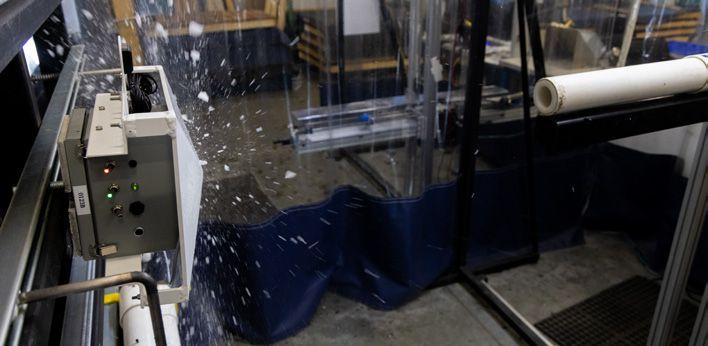
A lab-created hailstone impacting a distrometer during a routine calibration process in preparation for the 2023 hail field study.
• For retrofitting an existing roof, apply closed-cell spray foam to the underside of the roof.
• Seal the roof deck and tape seams between the decking and other joints to protect the roof deck from being damaged by long term water leaks. A sealed roof deck is part of IBHS’s FORTIFIED standard, a voluntary, beyond-code construction and re-roofing method that strengthens buildings to hail, high winds and heavy rain and a good option to consider when re-roofing or building a new commercial property. FMJ

Christopher Sanders spent the better part of a decade as a licensed insurance adjuster where he performed roof inspections that were used in underwriting the insurance policy for the property. He would later go onto do his master over the wind driven damages caused by Hurricane Harvey, based on insurance claims. At the Insurance Institute for Business and Home Safety (IBHS) he oversees the hail impact research of building envelope products.

Chuck Miccolis provides engineering and technical support for commercial building–related hazard mitigation initiatives. He is the lead engineer for the Institute’s FORTIFIED Commercial standards, a voluntary commercial construction criterion that focuses on building resiliency and mitigating losses from natural and human-caused hazards. He works with IBHS colleagues, member companies, and industry trade organizations on program development, mitigation, field research, and testing at the IBHS Research Center. Prior to joining IBHS, Miccolis was in the commercial property insurance business for more than 20 years.
The following product and service providers offer solutions for your everyday and specialized facility management needs.

Since 1901, we’ve been proudly manufacturing the highest-quality pipe and fittings in the USA. Not only are we the largest maker of cast iron and plastic pipe and fittings, but also we are the only manufacturer to offer a complete system of cast iron, PVC, CPVC, ABS, and FlowGuard Gold® pipe and fittings. From product to service, Charlotte Pipe and Foundry has an unmatched commitment to integrity and the craft. We’ve combined modern technology with over a century of craftsmanship and experience in order to make it right, every time.


charlottepipe.com
linkedin.com/company/charlotte-pipe-and-foundry/

Professionals trust Paint Supply to deliver. We stock thousands of paint-related products, ready to ship quickly from facilities strategically located around the United States. Anchored in long-term partnerships with the leading brands from top manufacturers, Paint Supply has the right products for your next job—all with superior customer service and professional pricing that sets us apart.


paintsupply.com
linkedin.com/company/paint-supply/
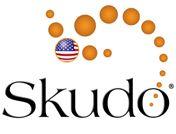
Skudo is a manufacturer of premium temporary surface protection products. Skudo’s mission is to develop solutions for the construction, flooring, and facility management industries to protect all surfaces from damage during construction. Skudo products offer superior performance compared to more common or traditional systems. Our existing range extends from patented adhering products to heavy-duty loose lay products. These solutions are purpose-built to protect various surfaces, including Concrete, Tile, Stone, Hardwood, Metal, and Glass. Innovative, purpose-built surface protection systems. This is All We Do.


skudousa.com
linkedin.com/company/skudo-usa-inc-

The Vaask® touchless hand sanitizing fixture is available in customizable finishes and designed to complement the style of any space. It uses AC power or POE (power-over-ethernet) – no batteries required. Vaask is available recessed into the wall, in a wall-mounted stand or freestanding. Built to last, the U.S.-manufactured fixture is made of aluminum and backed by a 5-year warranty. The large-capacity, refillable cartridge is compatible with any alcoholbased sanitizer gel. Its PalmPilot® sensor accurately detects hands, eliminating mess. An array of LEDs both attract users and notify staff when it’s time to refill. Learn more at Vaask.com.


vaask.com linkedin.com/company/vaask/

You have a vision, we’re here to help! Top-Rated Sign Company Near you. Your business deserves to be seen, and at the custom sign shop FASTSIGNS, we can help you with visibility and so much more. We are a custom sign and visual solutions company that can handle a wide variety of your business’s needs, including content development, graphic design, and project management. Our visual idea experts offer unmatched insight and will work closely with you to understand your business and develop customized solutions that convey your message. Visual Communication Solutions to Put Your Business Where It Needs To Be. Our approach is simple: You have visual communication challenges, we have the tools and technology to put your company in front of
the right audience. Whether you are looking to build brand awareness, increase location “findability”, or promote a service or product, our team of visual idea experts and collaborators will use the perfect mix of innovative marketing and graphics solutions to deliver exactly what you need. At FASTSIGNS, we specialize in a variety of services to meet all your signage needs. That includes indoor/outdoor signs and banners; yard & site signs; vehicle graphics, window lettering and decals’ custom tradeshow displays & exhibits; wall, floor or ceiling murals as well as messaging boards and digital sign technology solutions.

fastsigns.com SOFTWARE SOLUTIONS

Eptura is a global worktech company that provides software solutions for workplaces, people, and assets that enable everyone to reach their full potential.


eptura.com linkedin.com/company/Eptura
